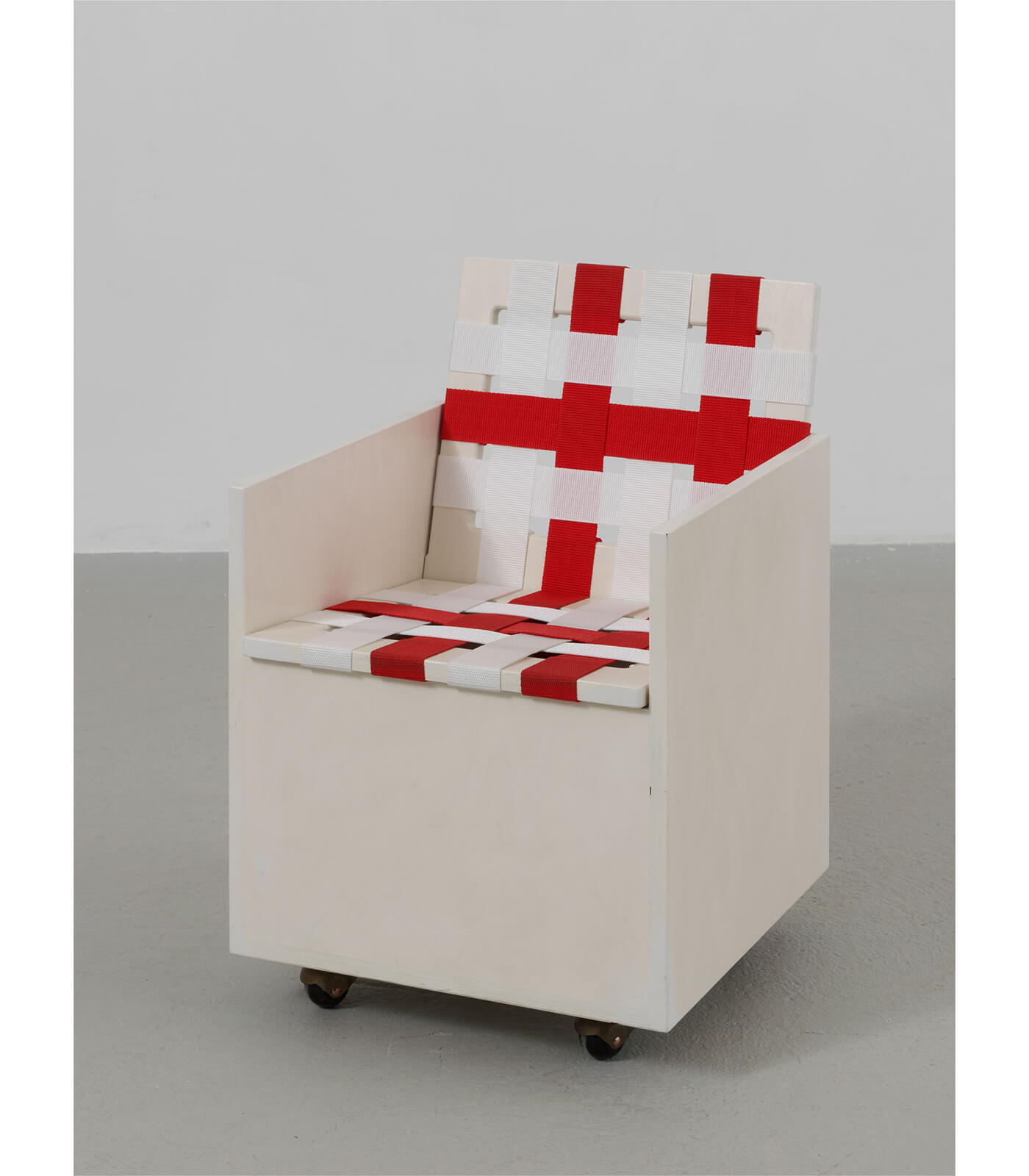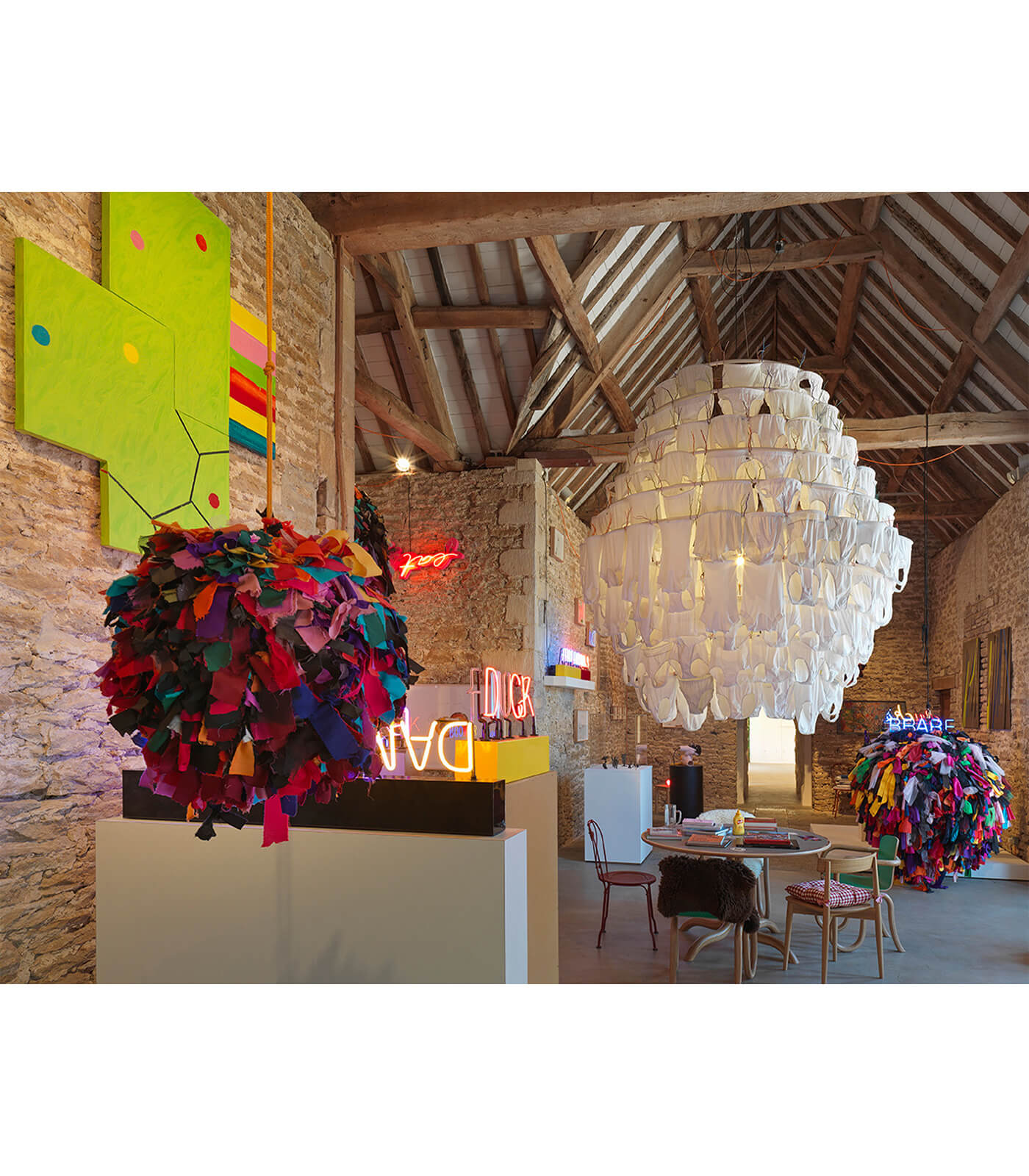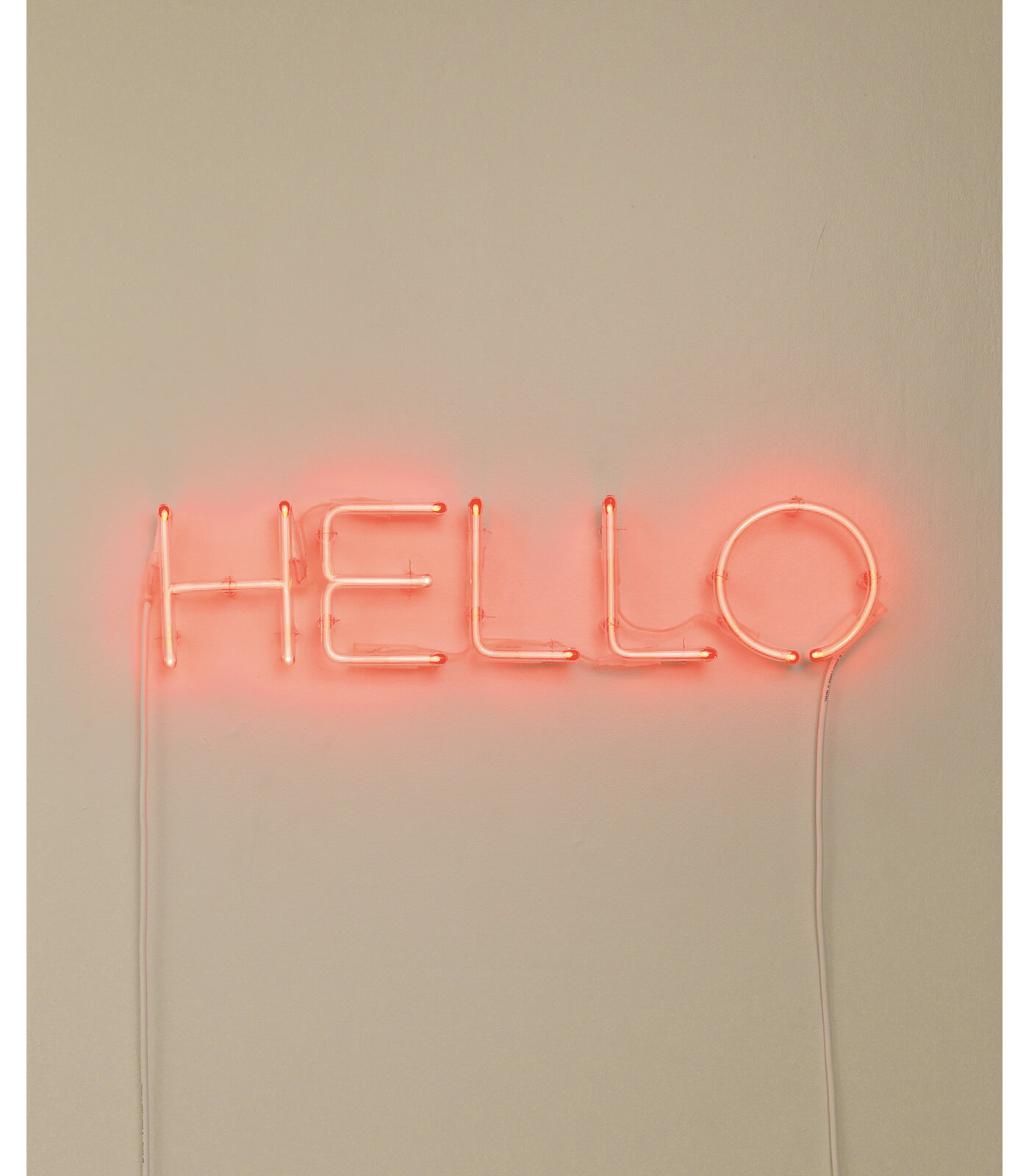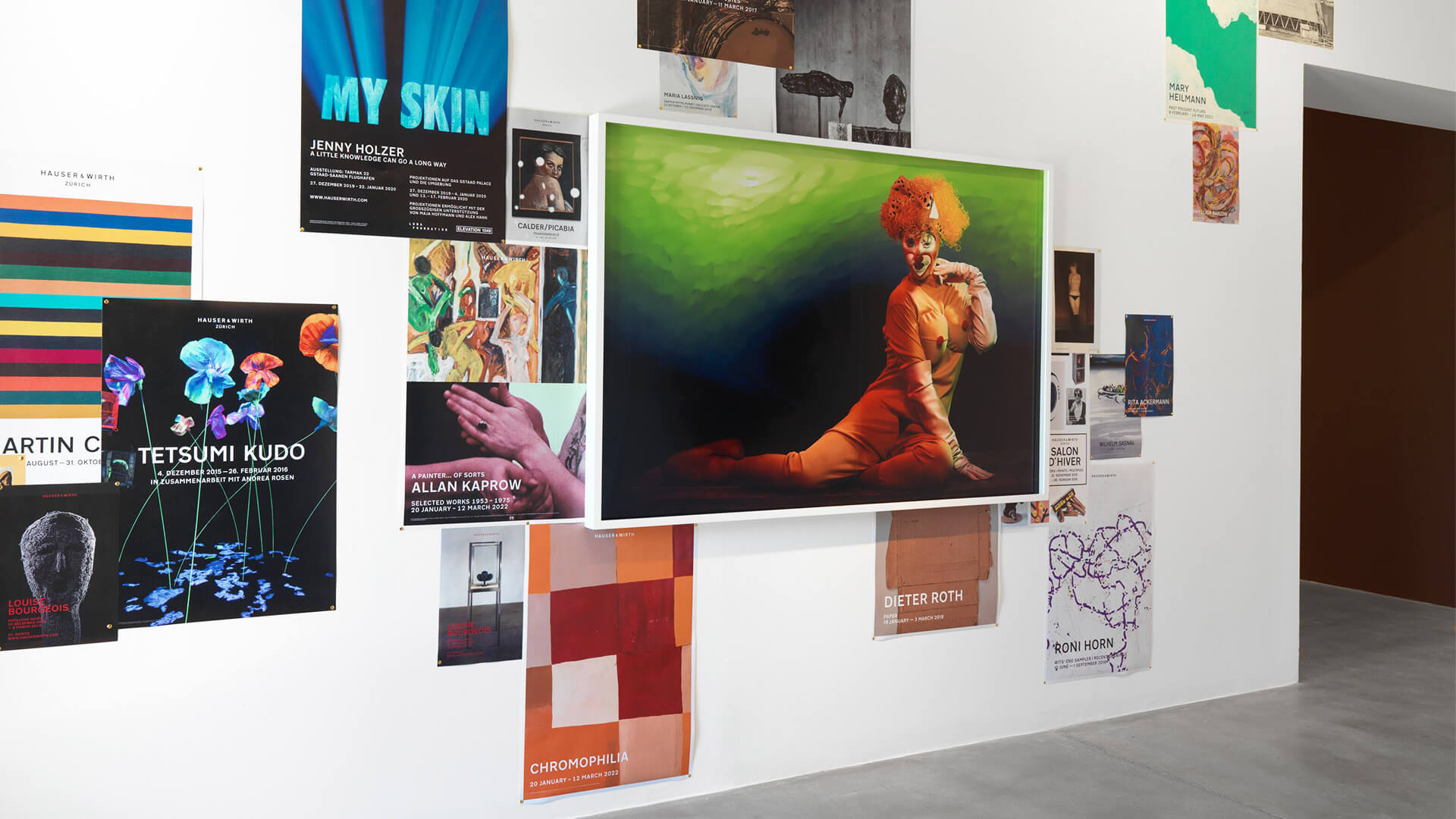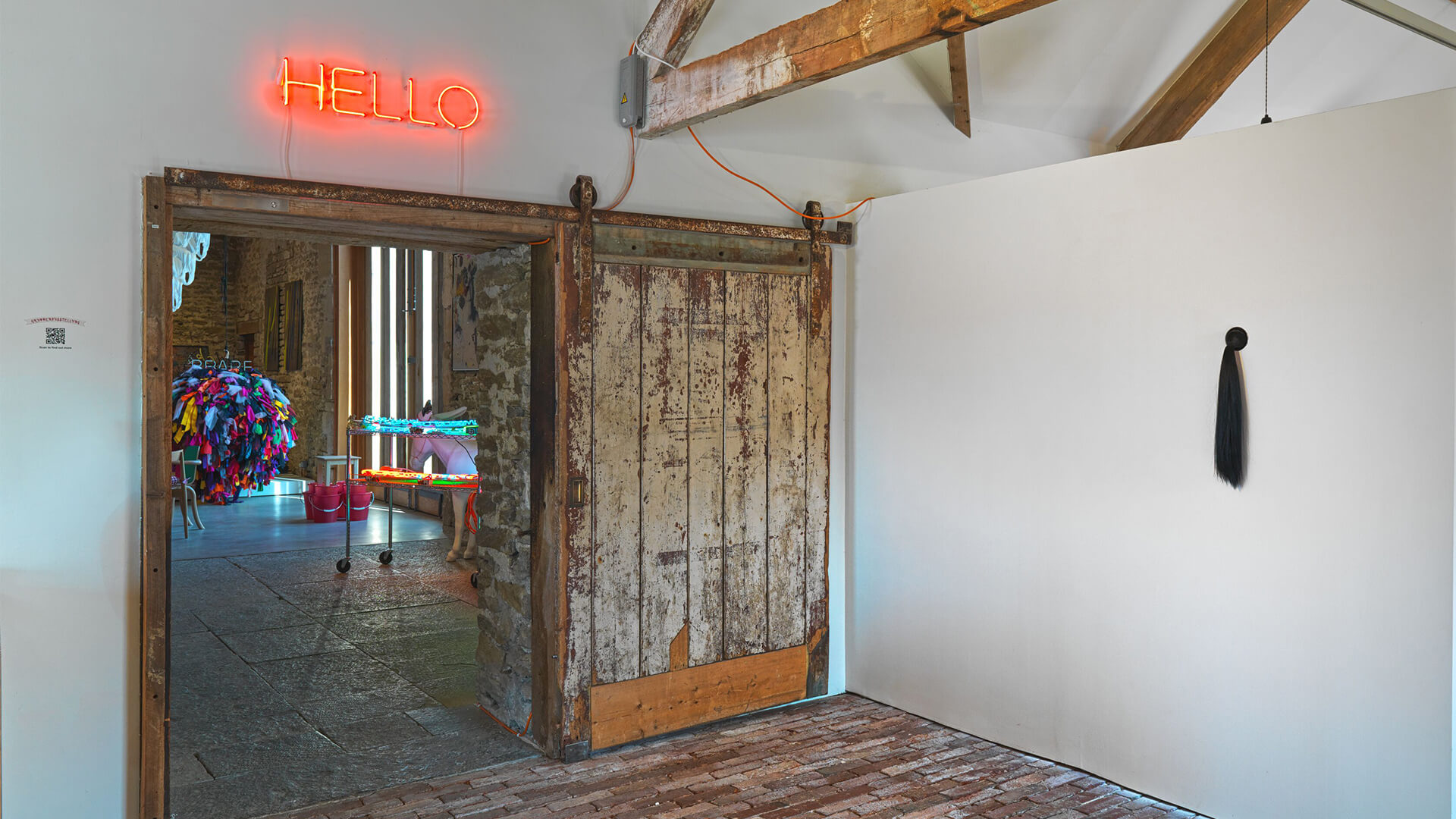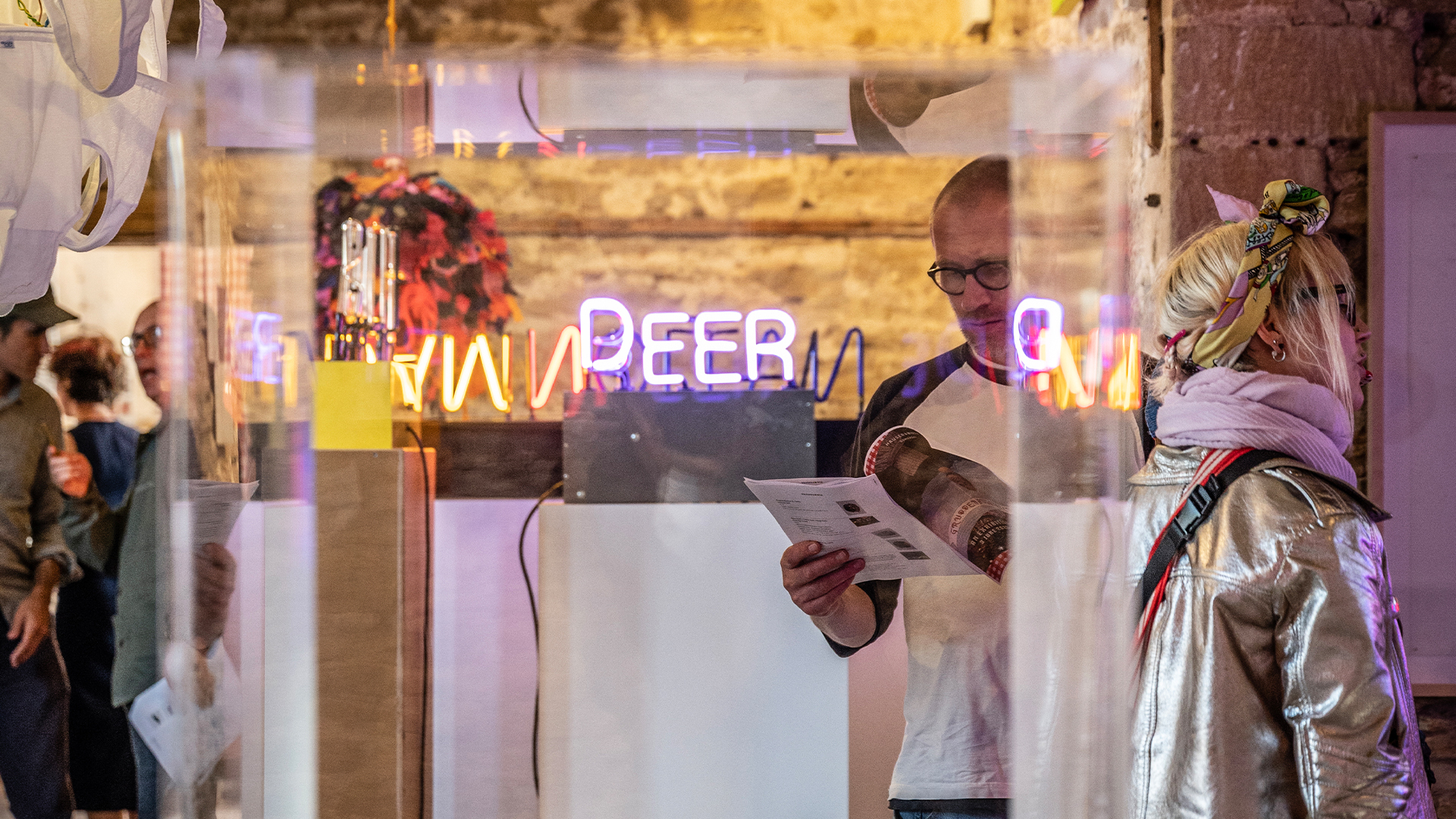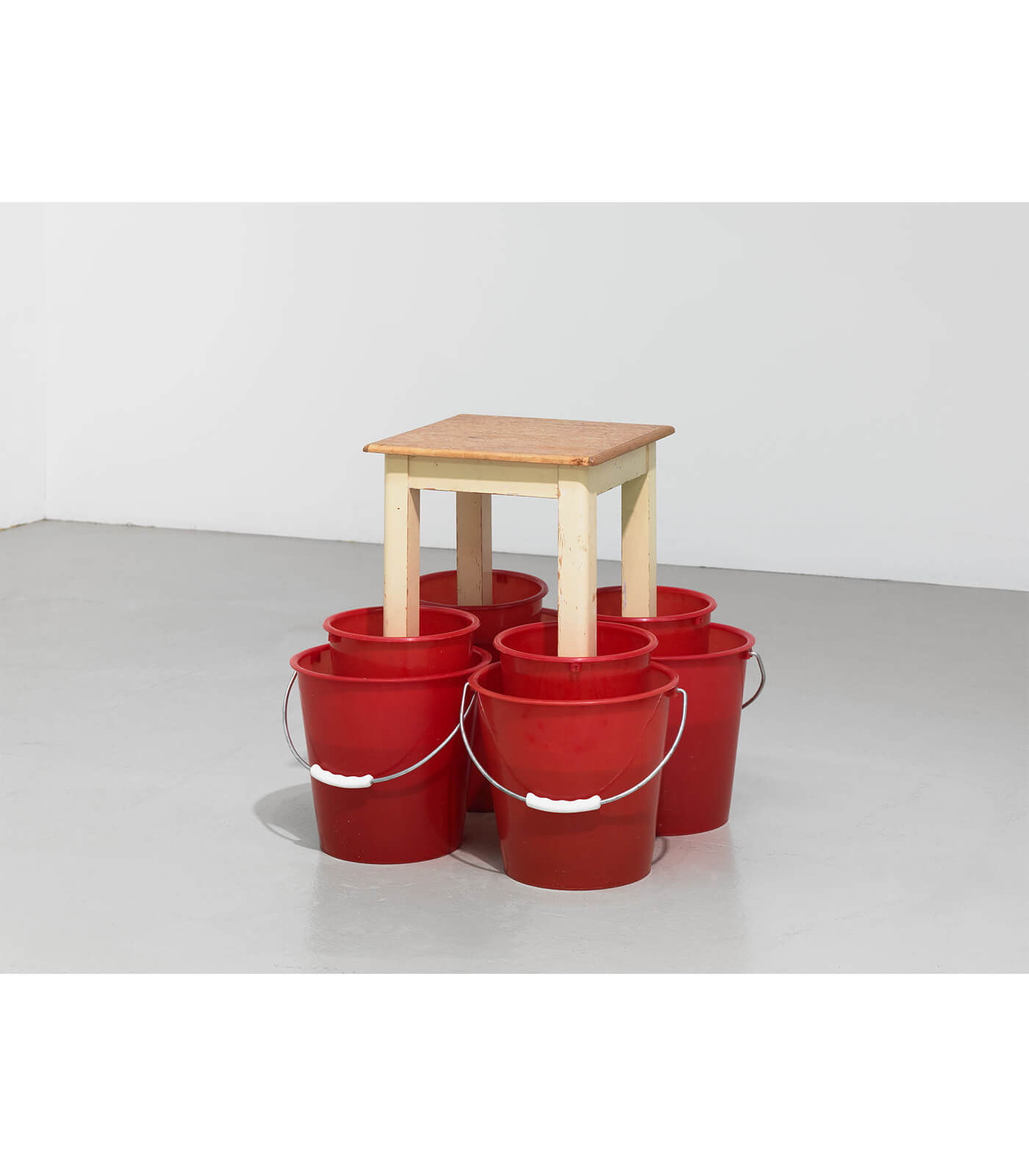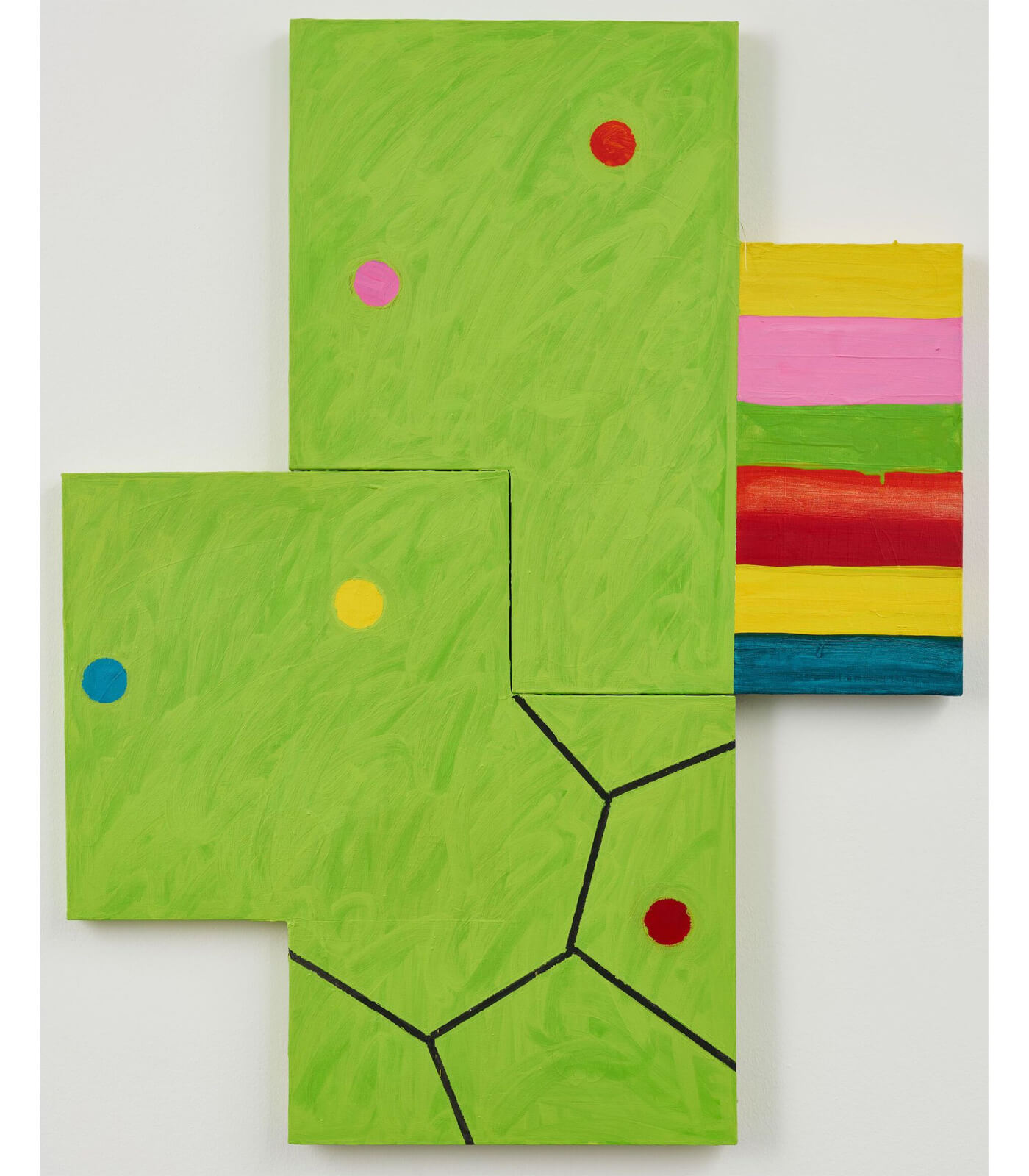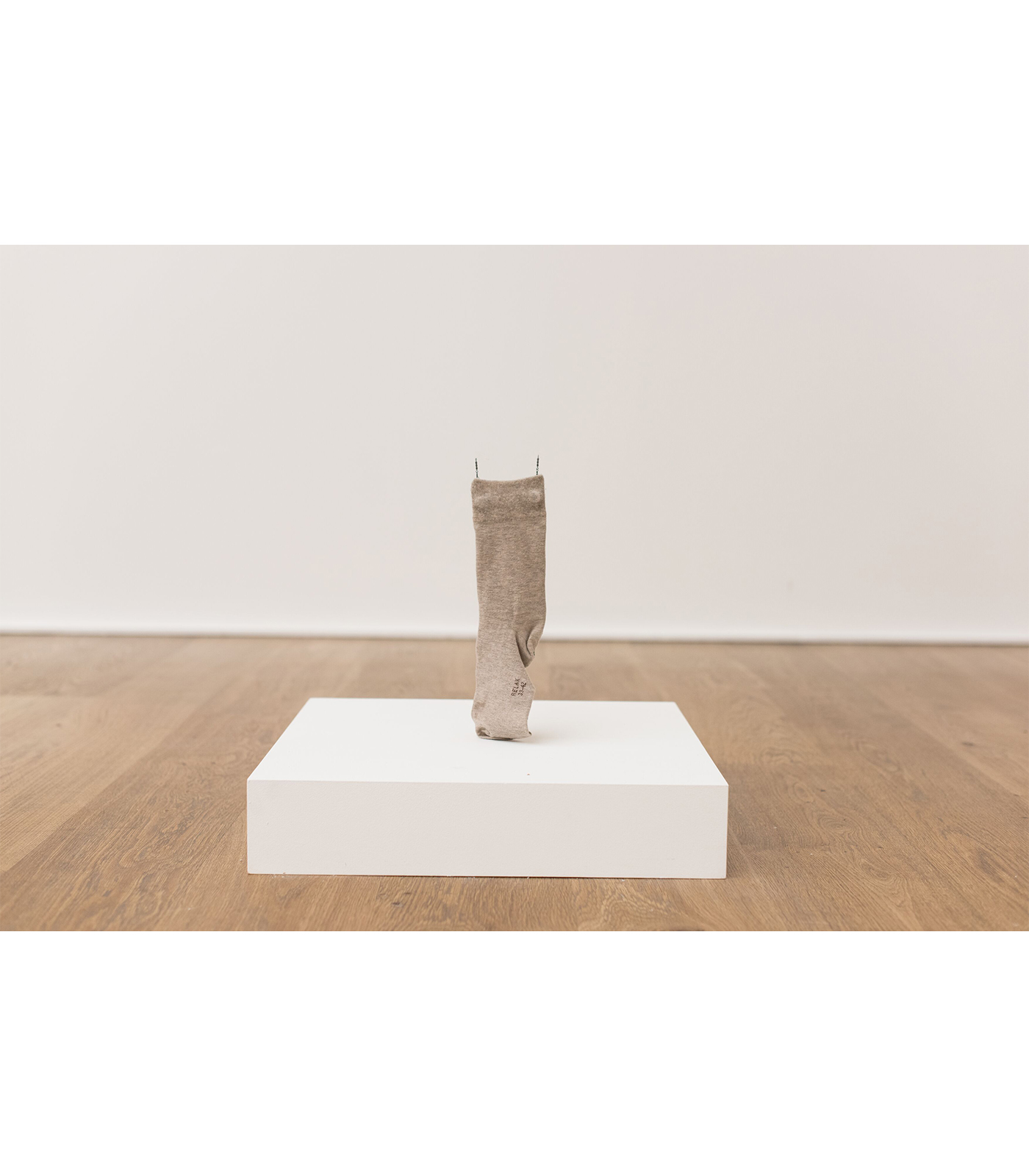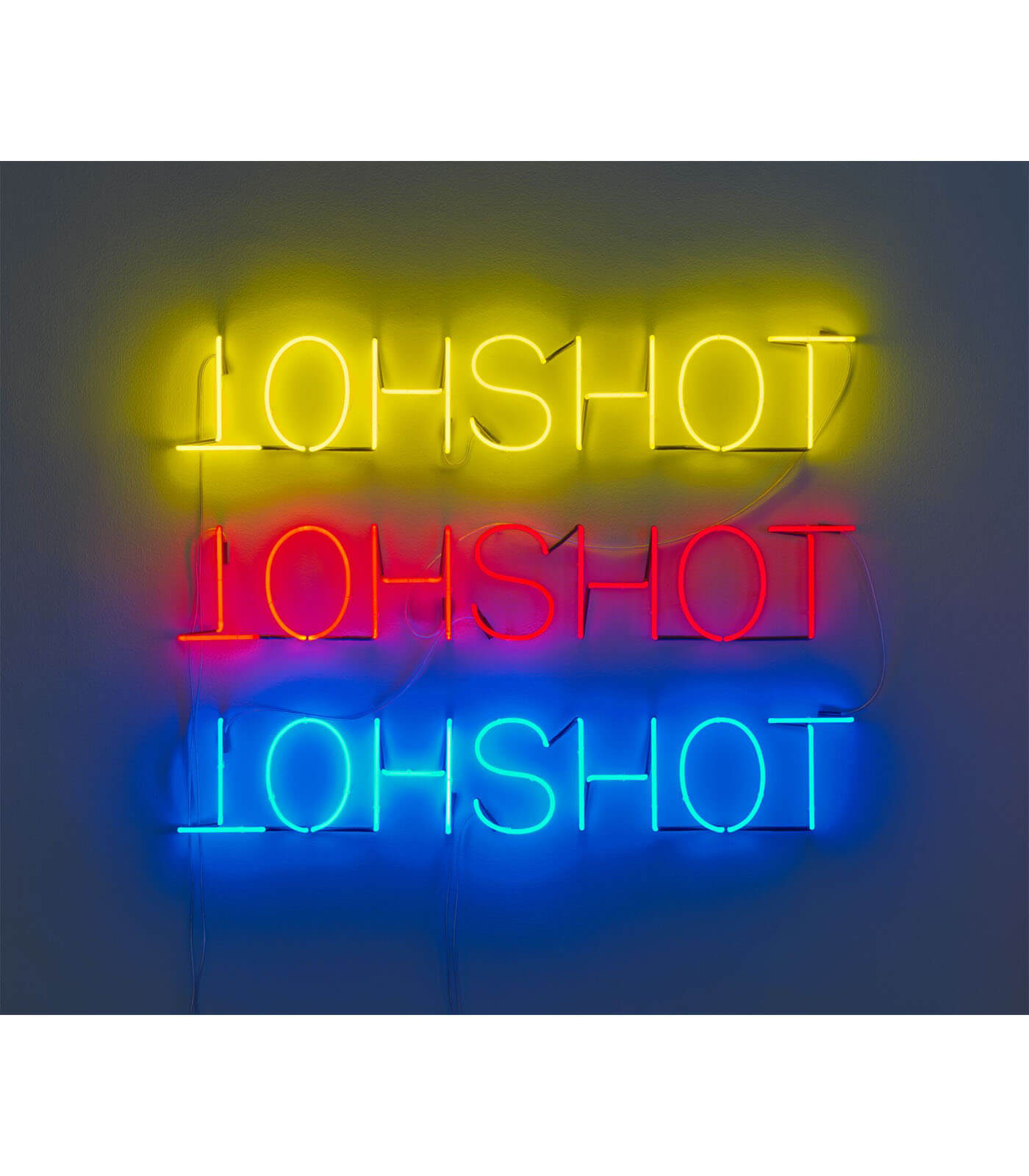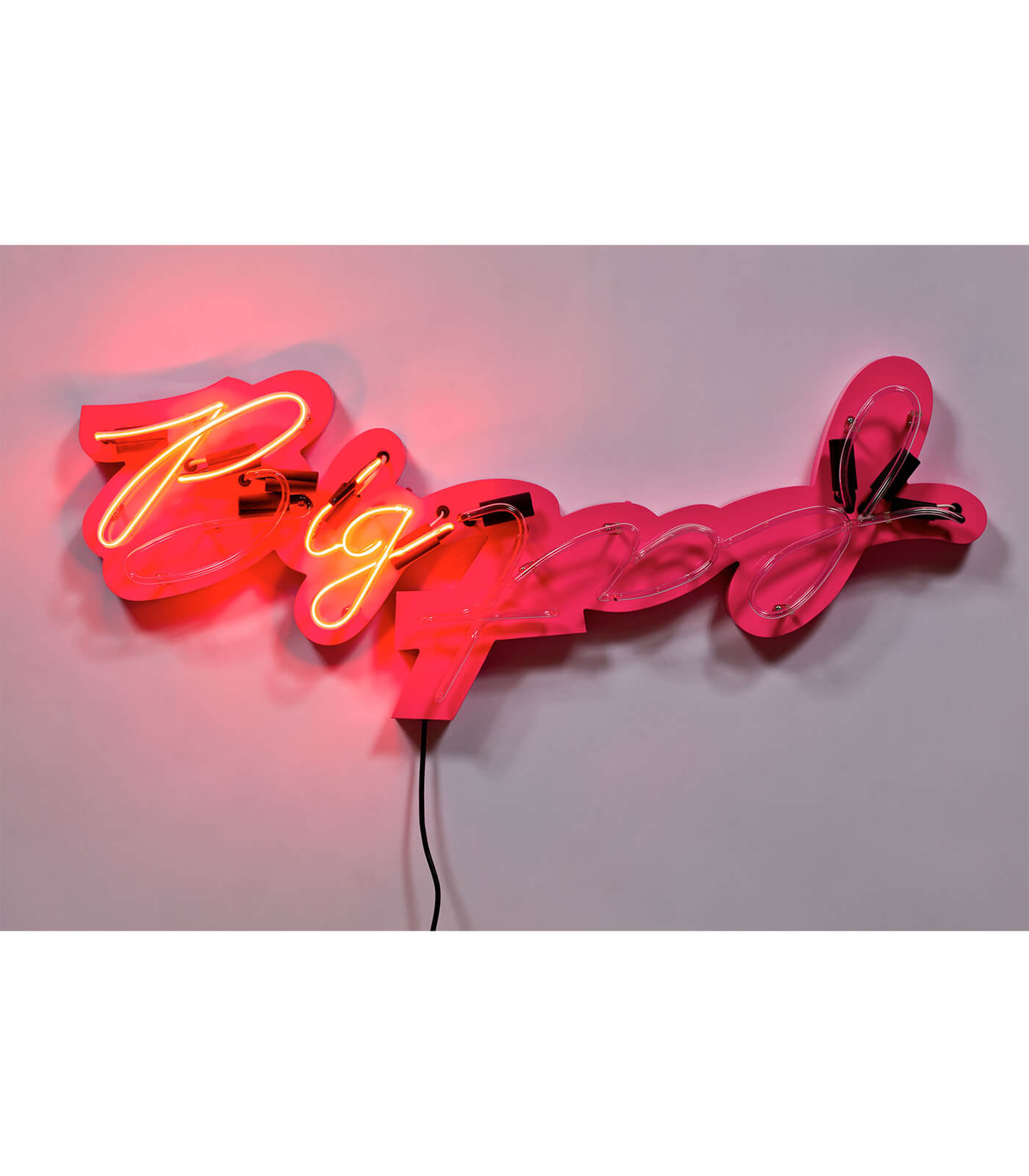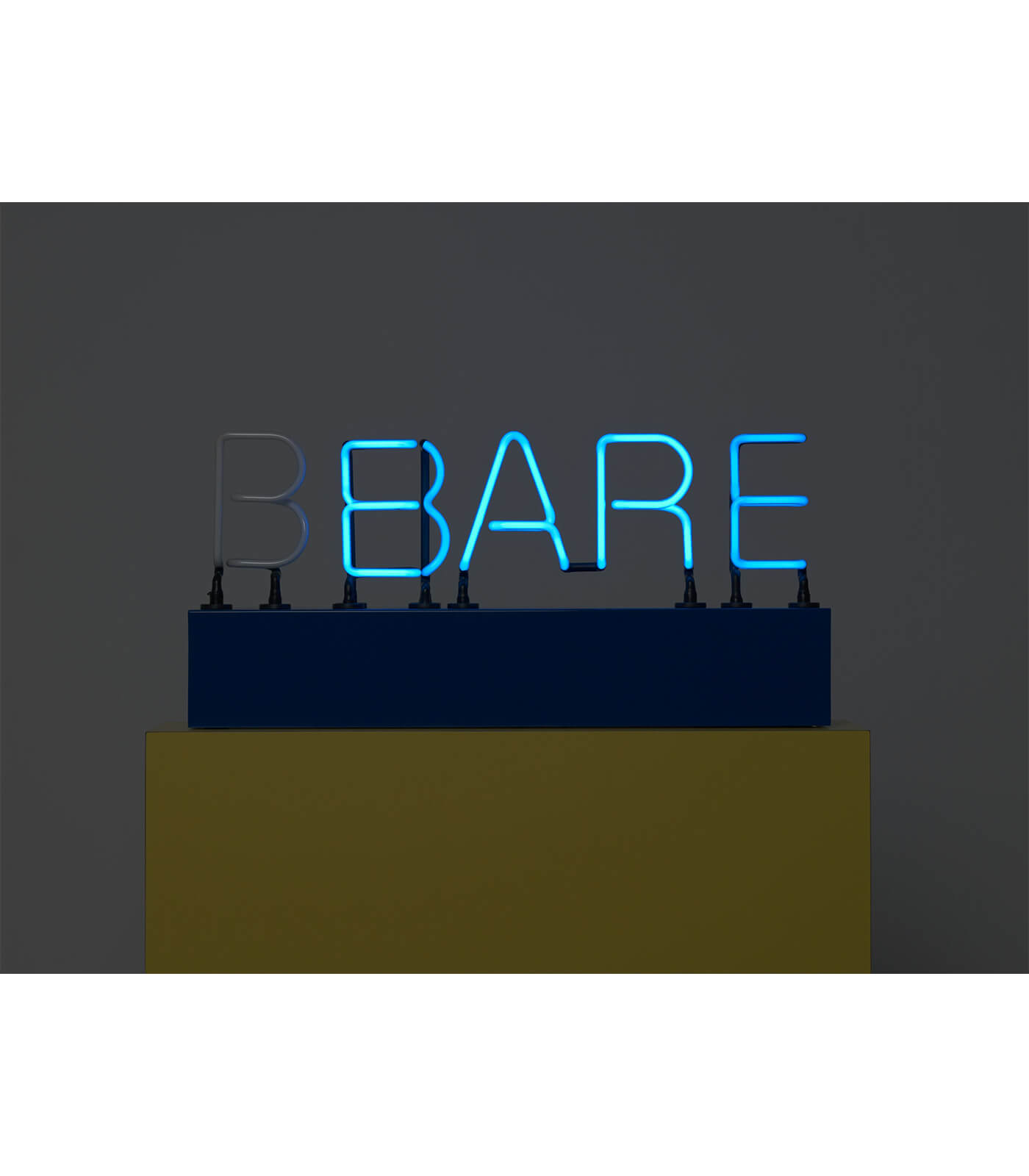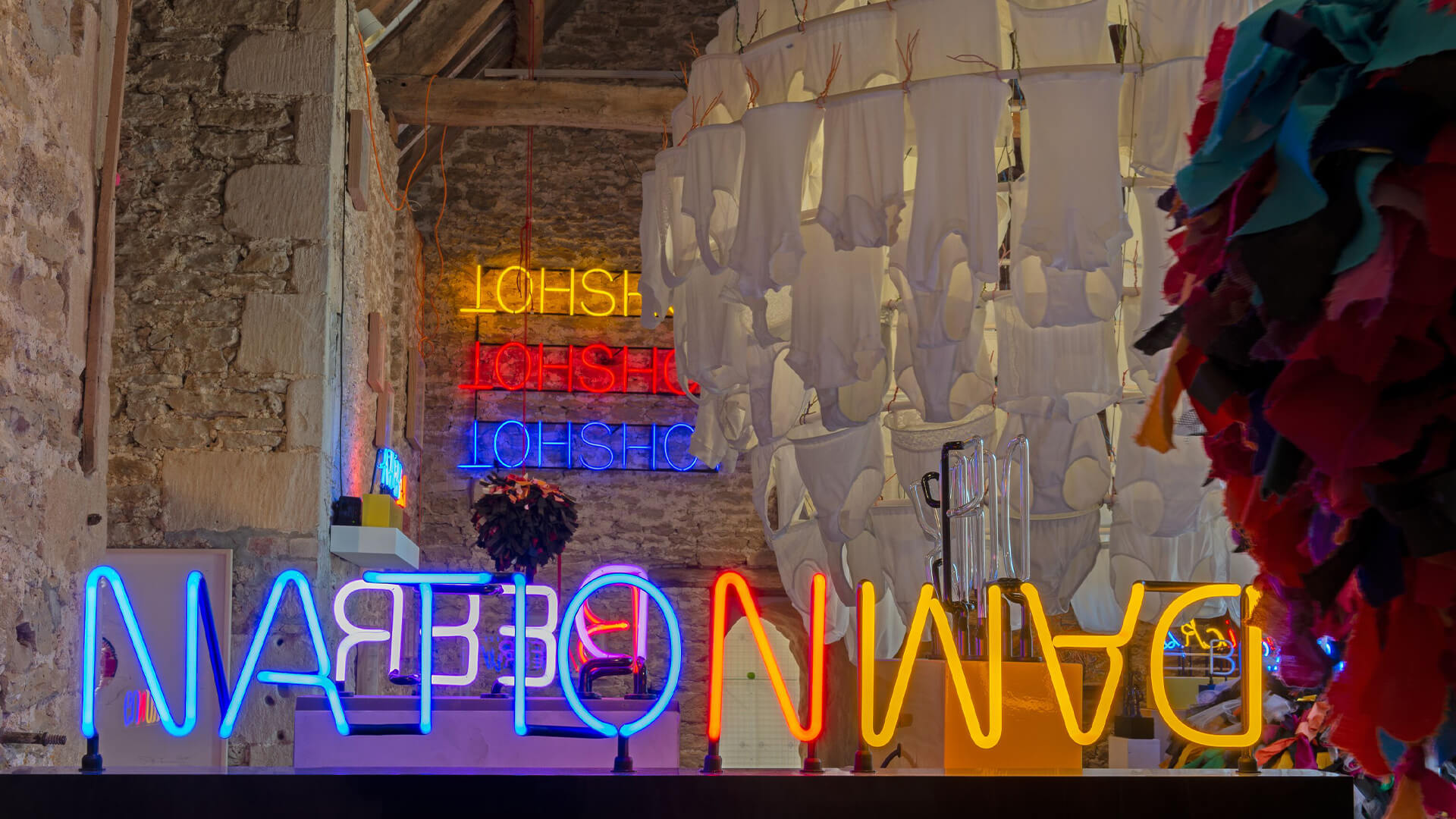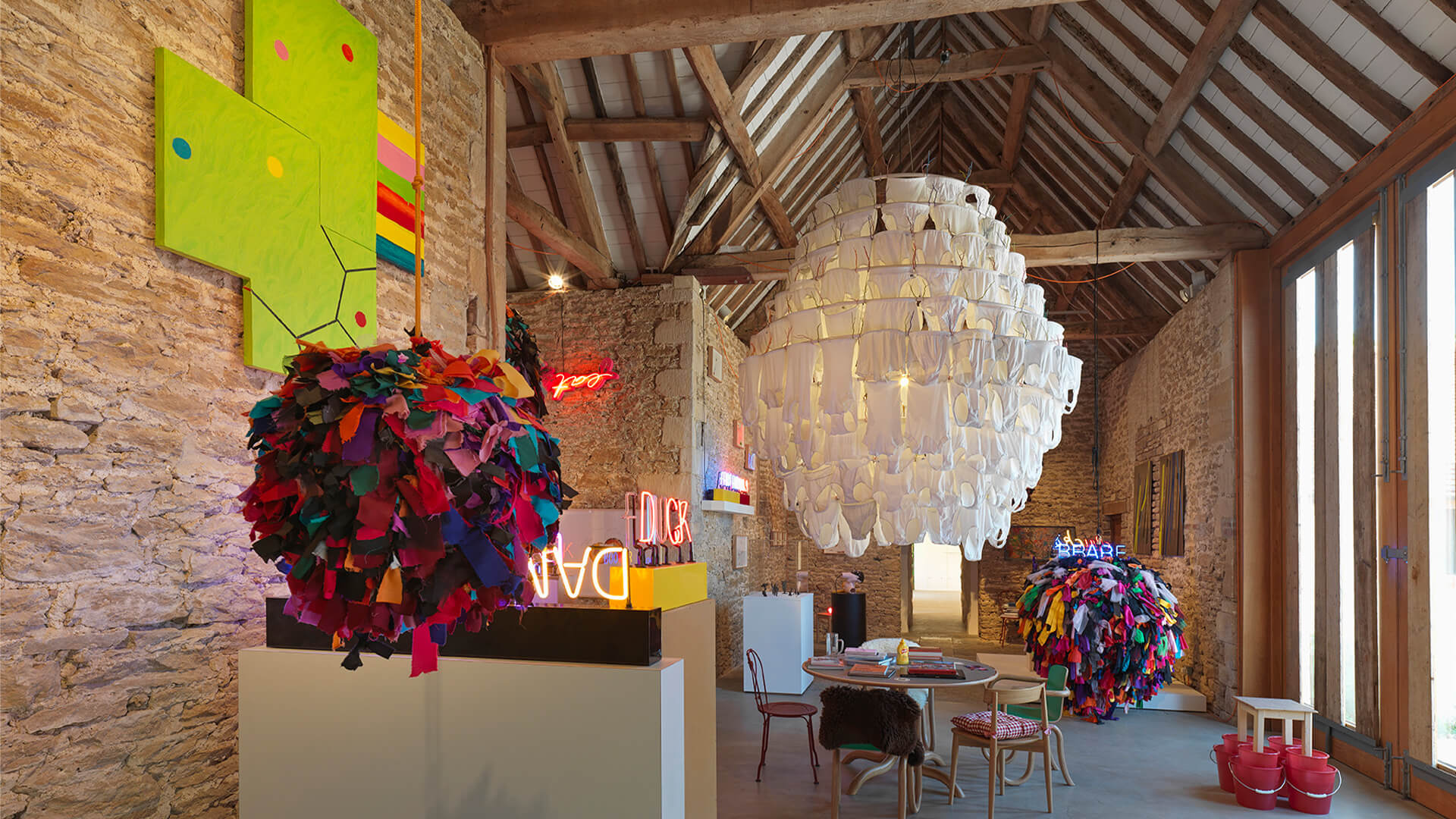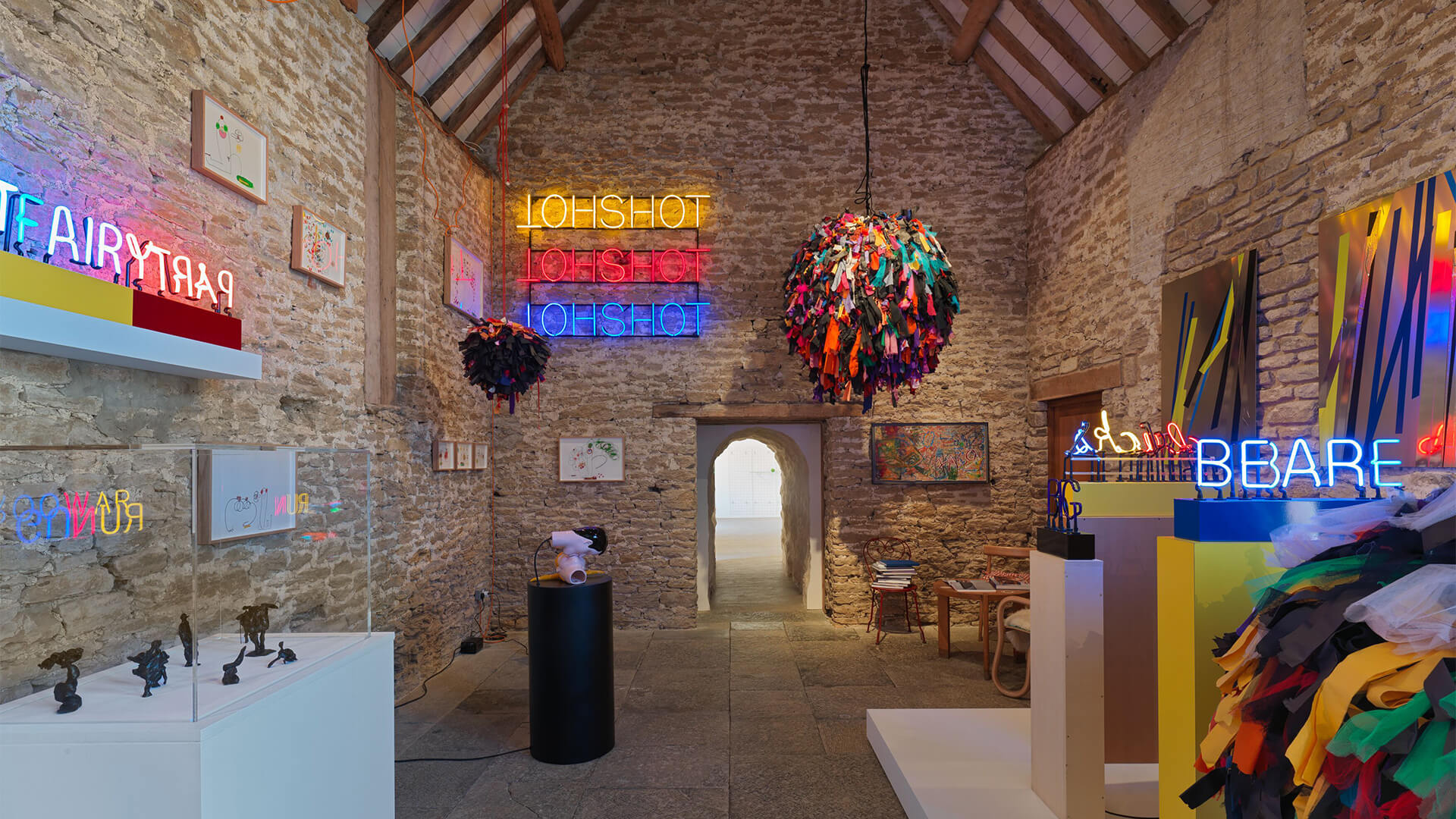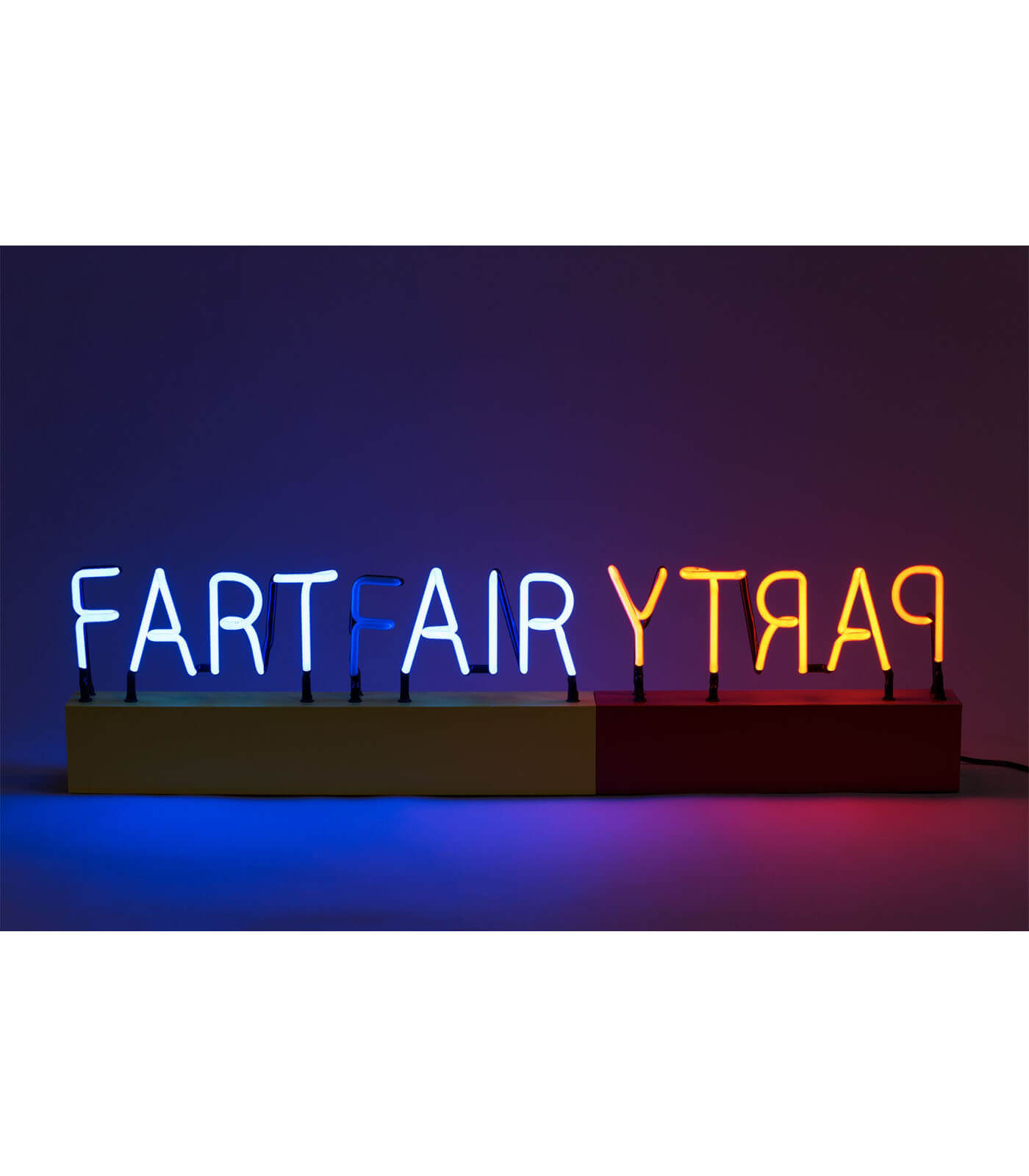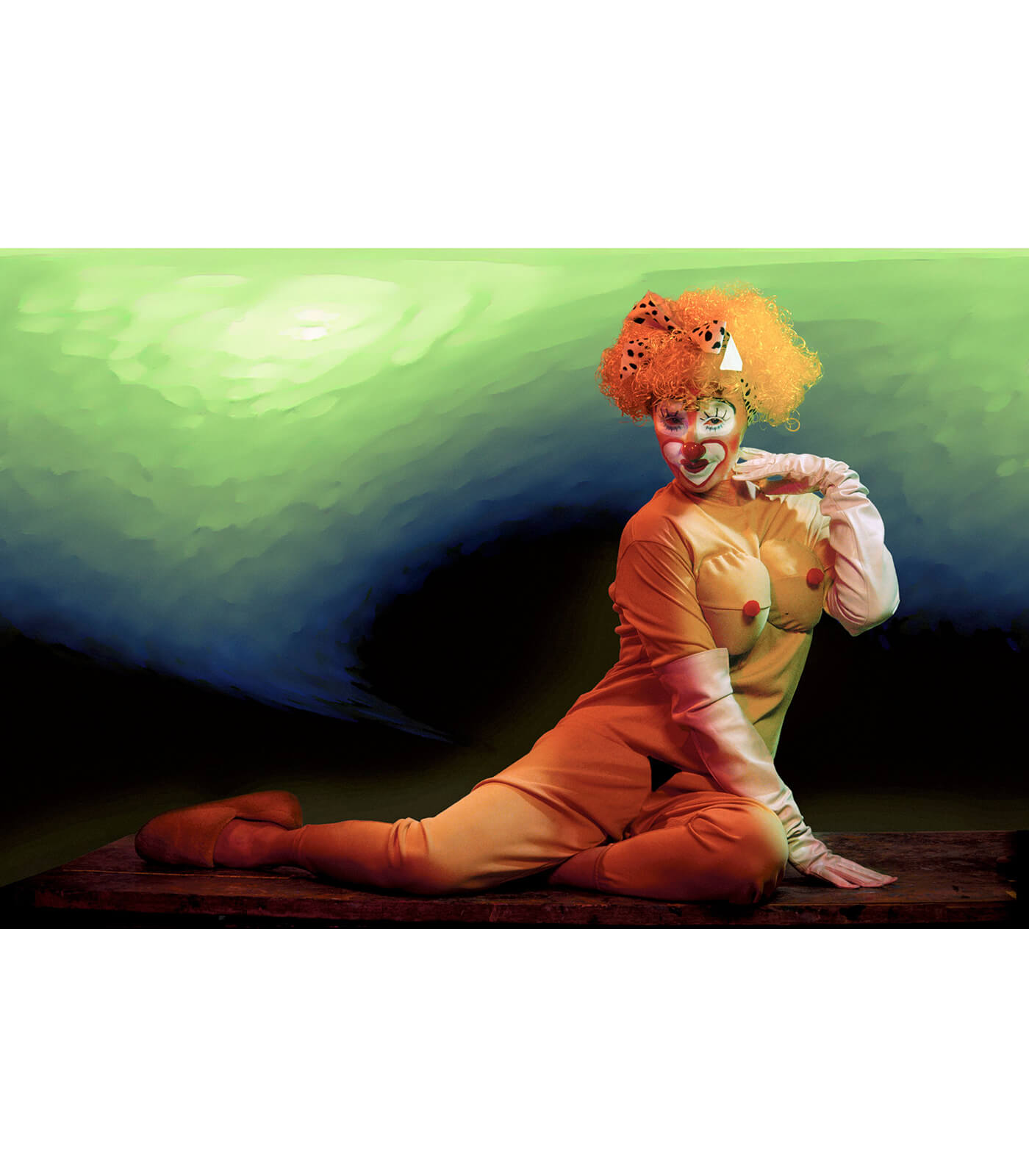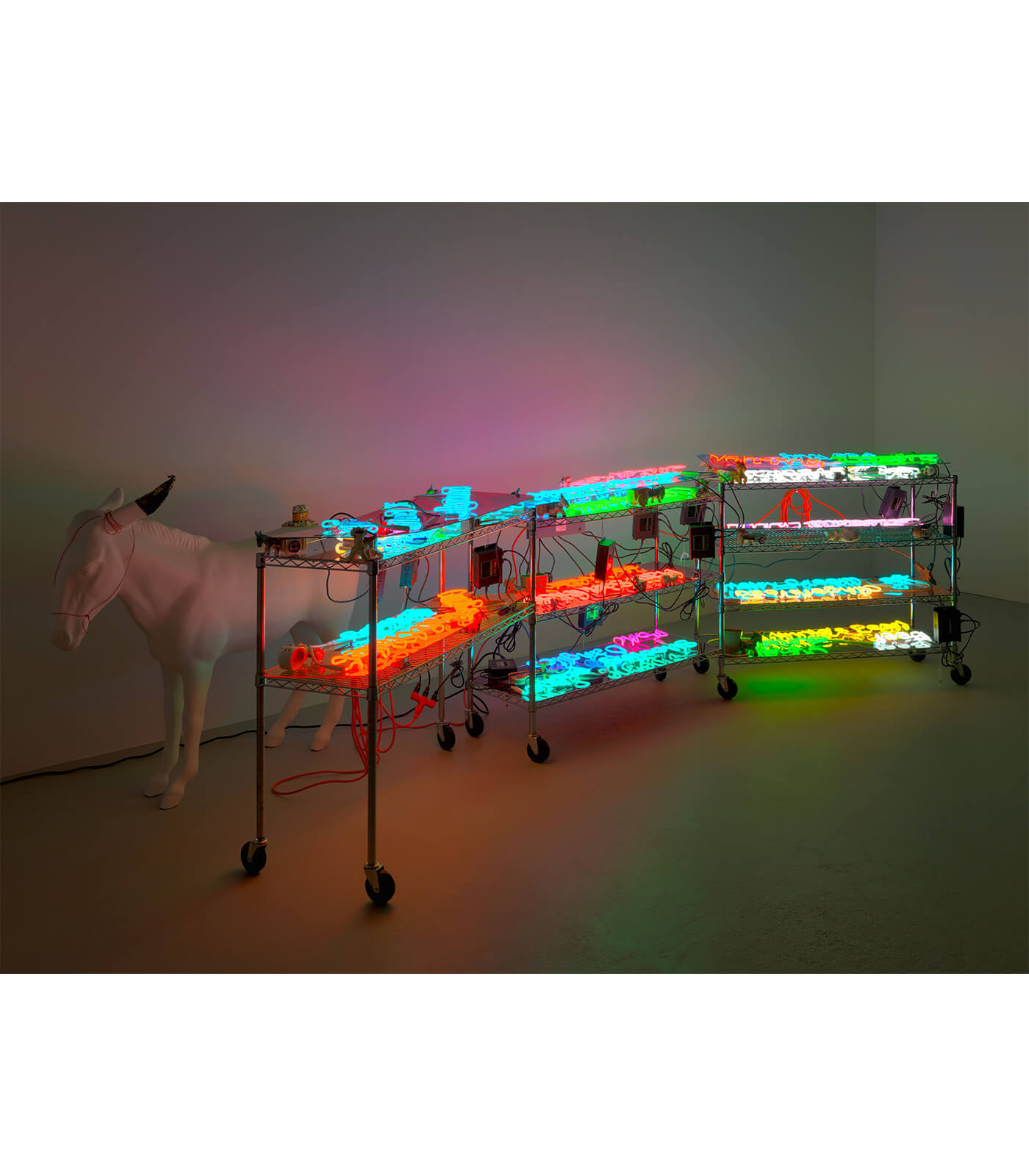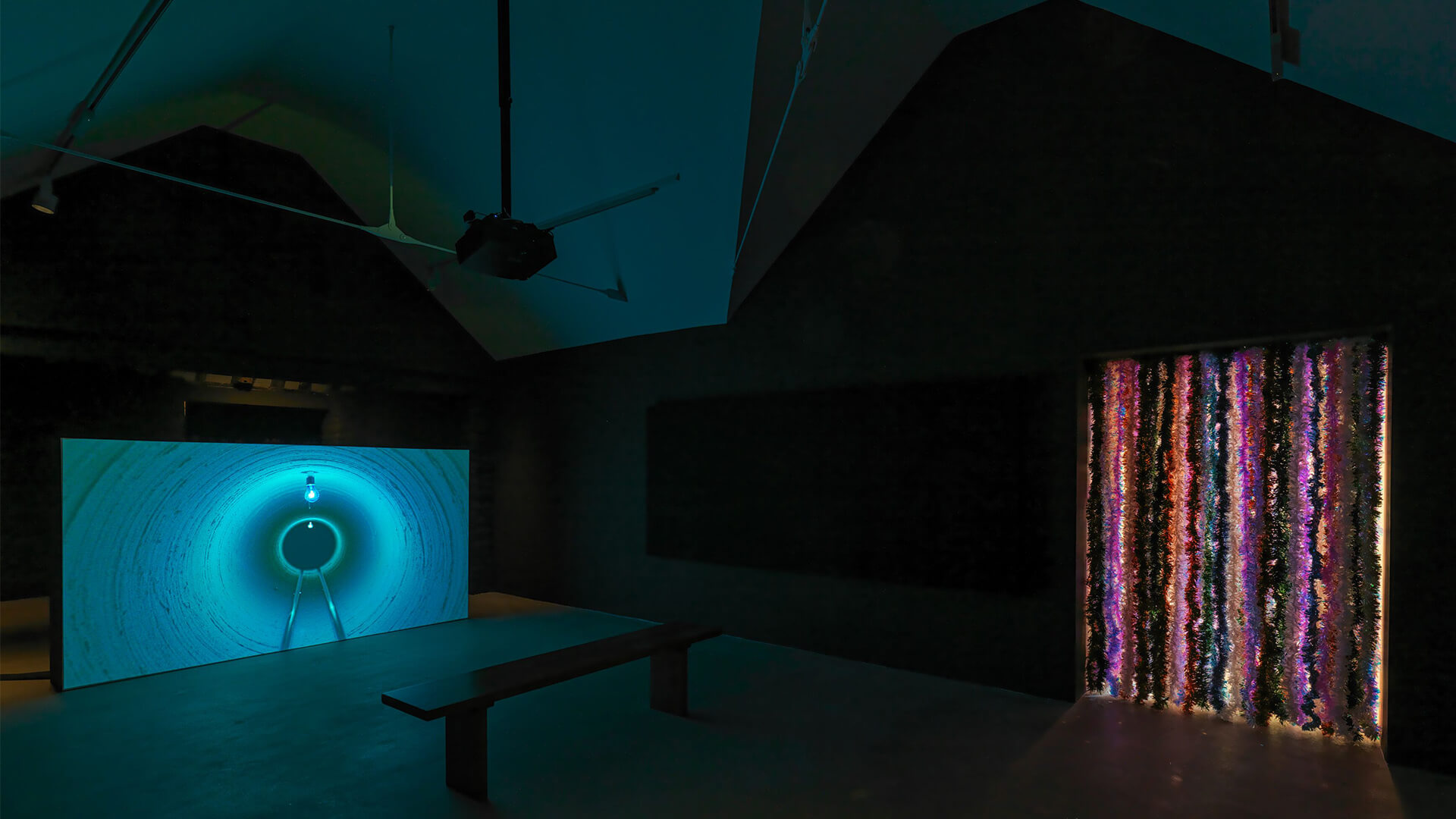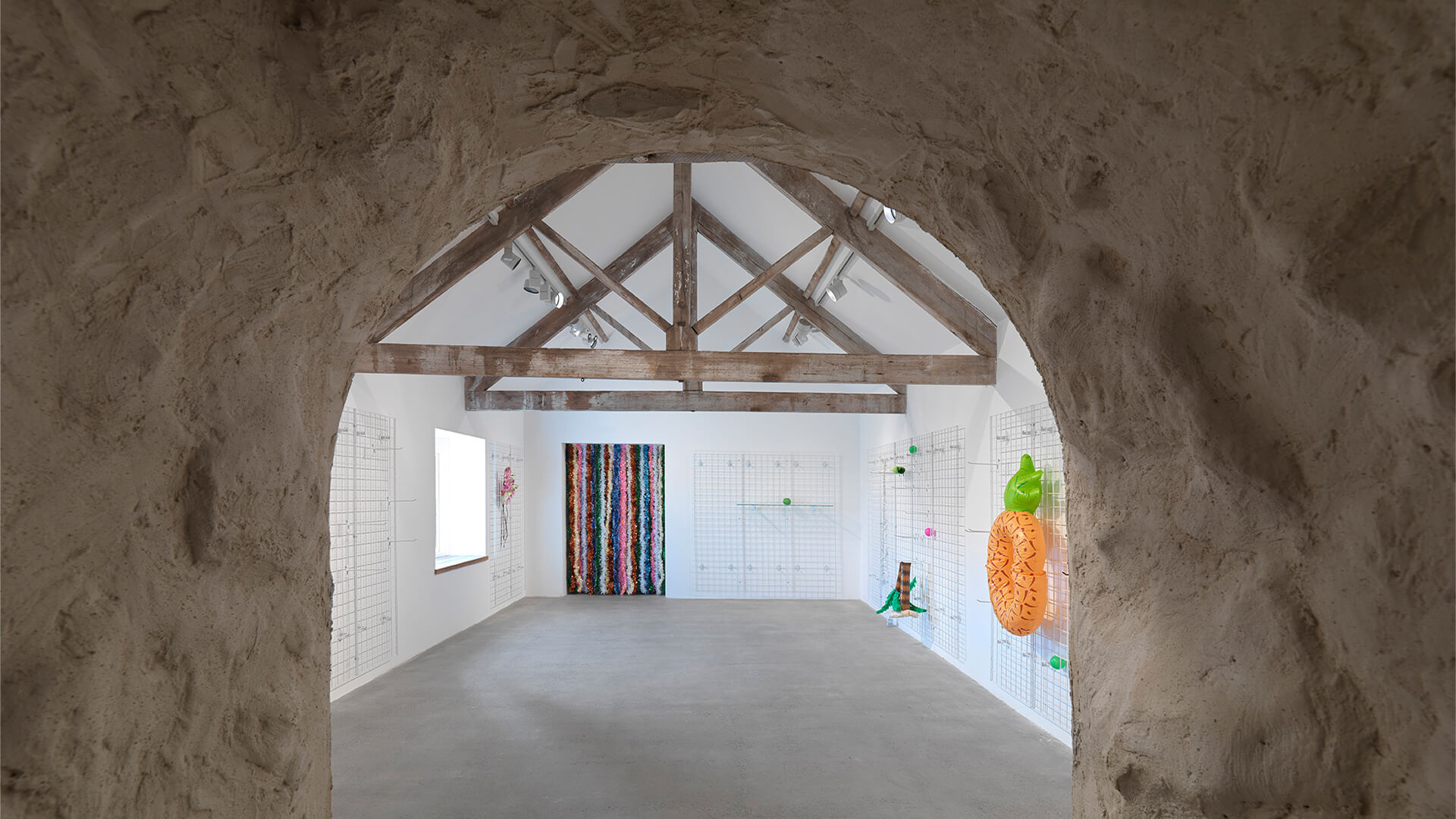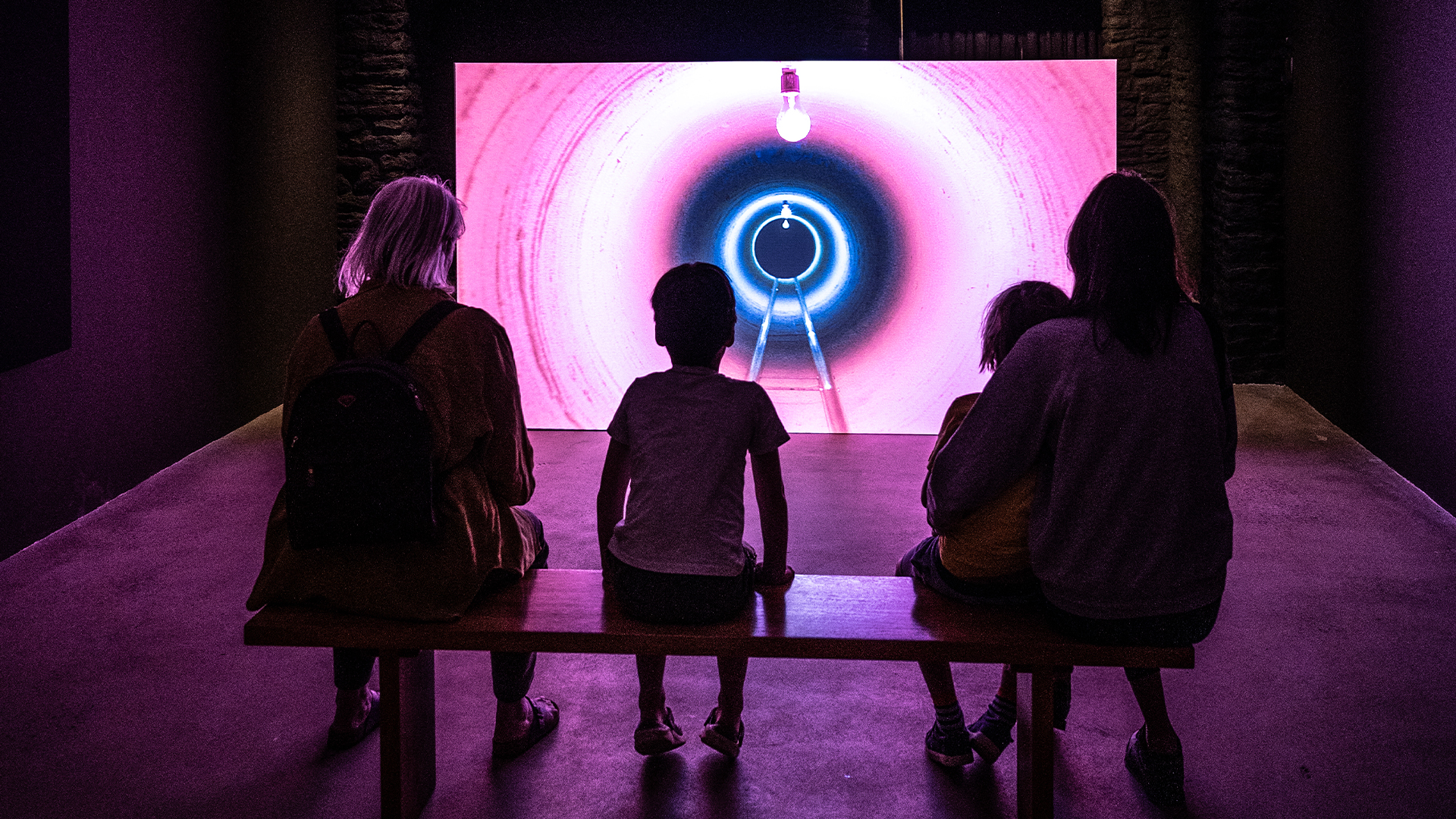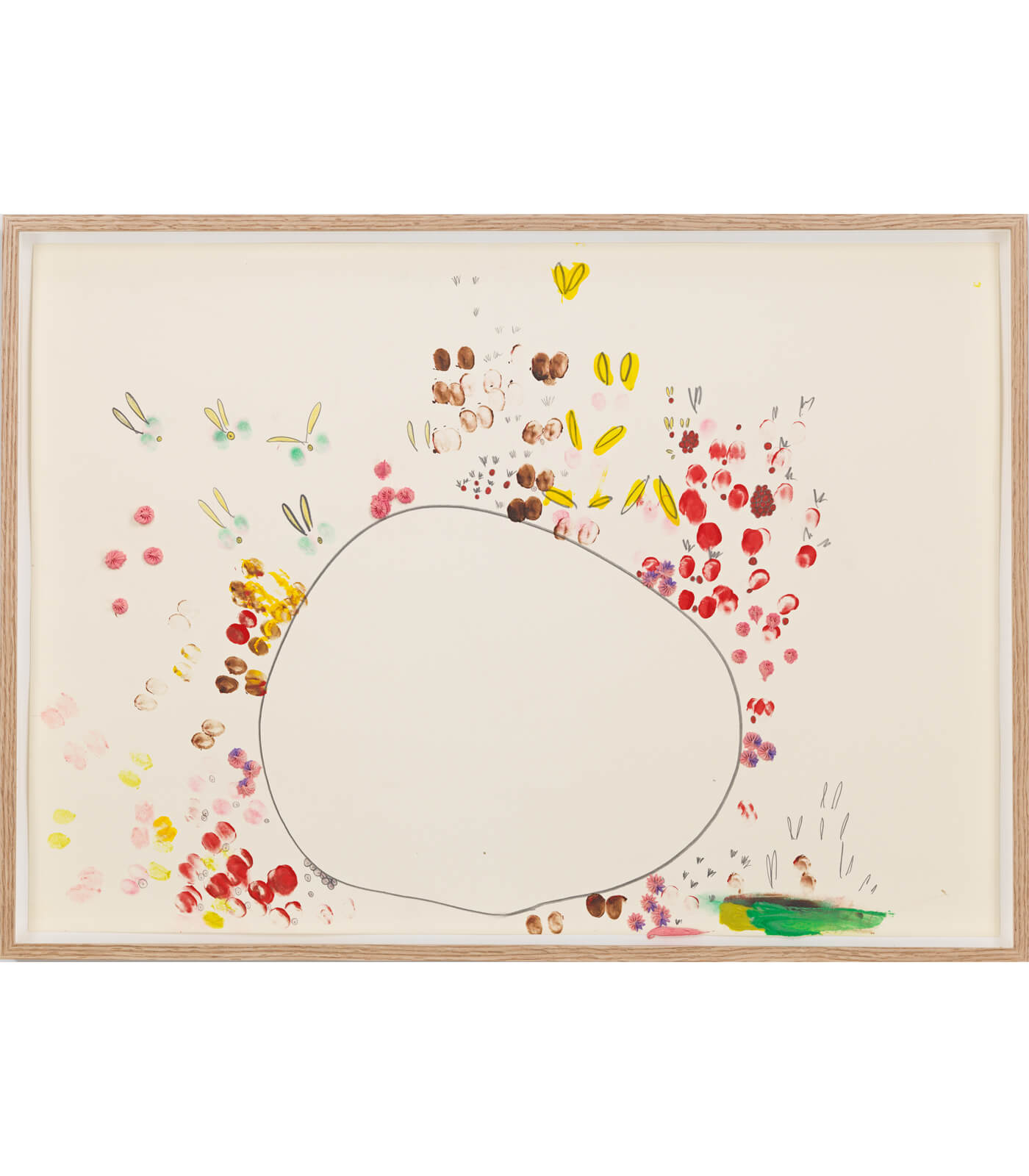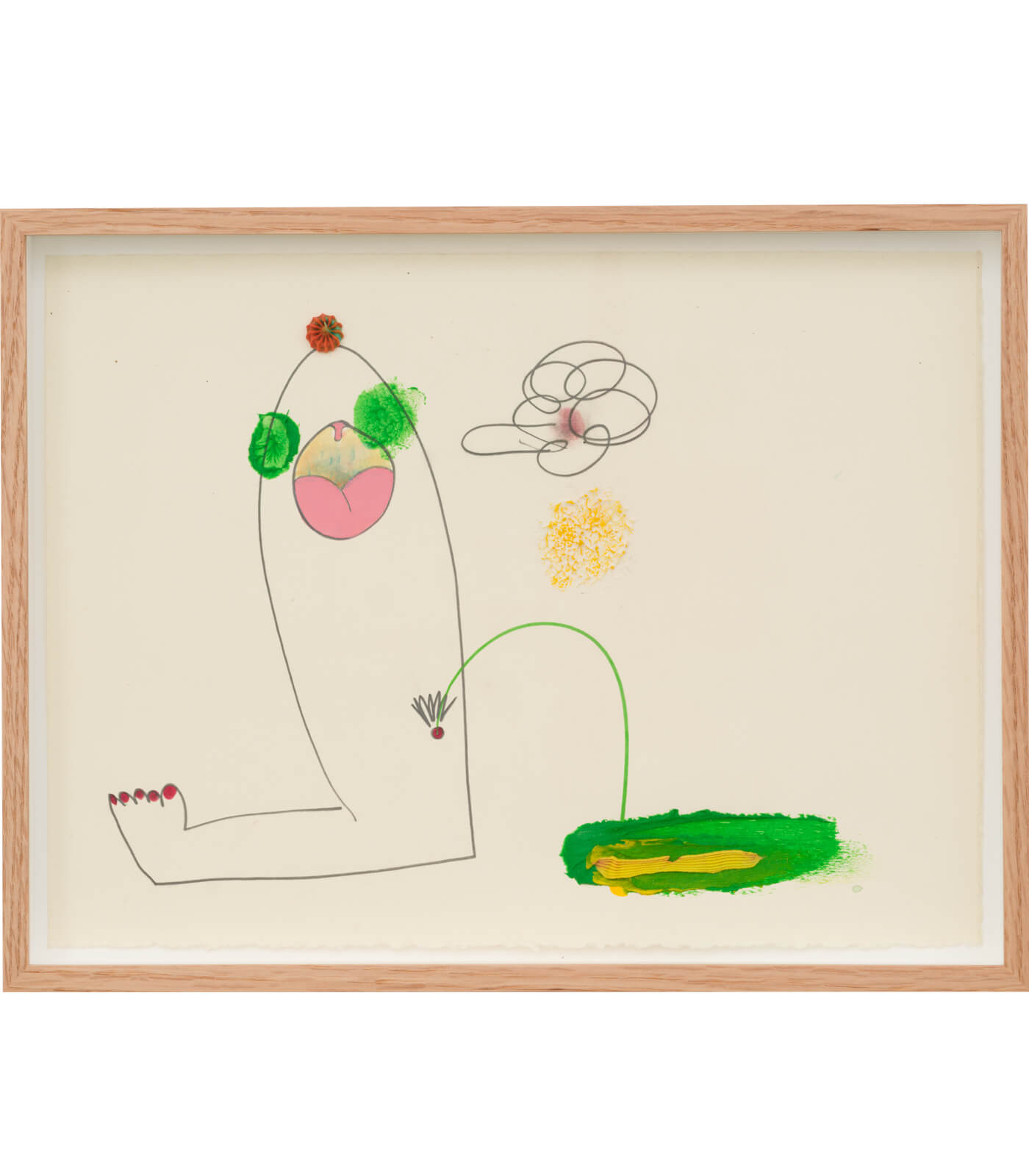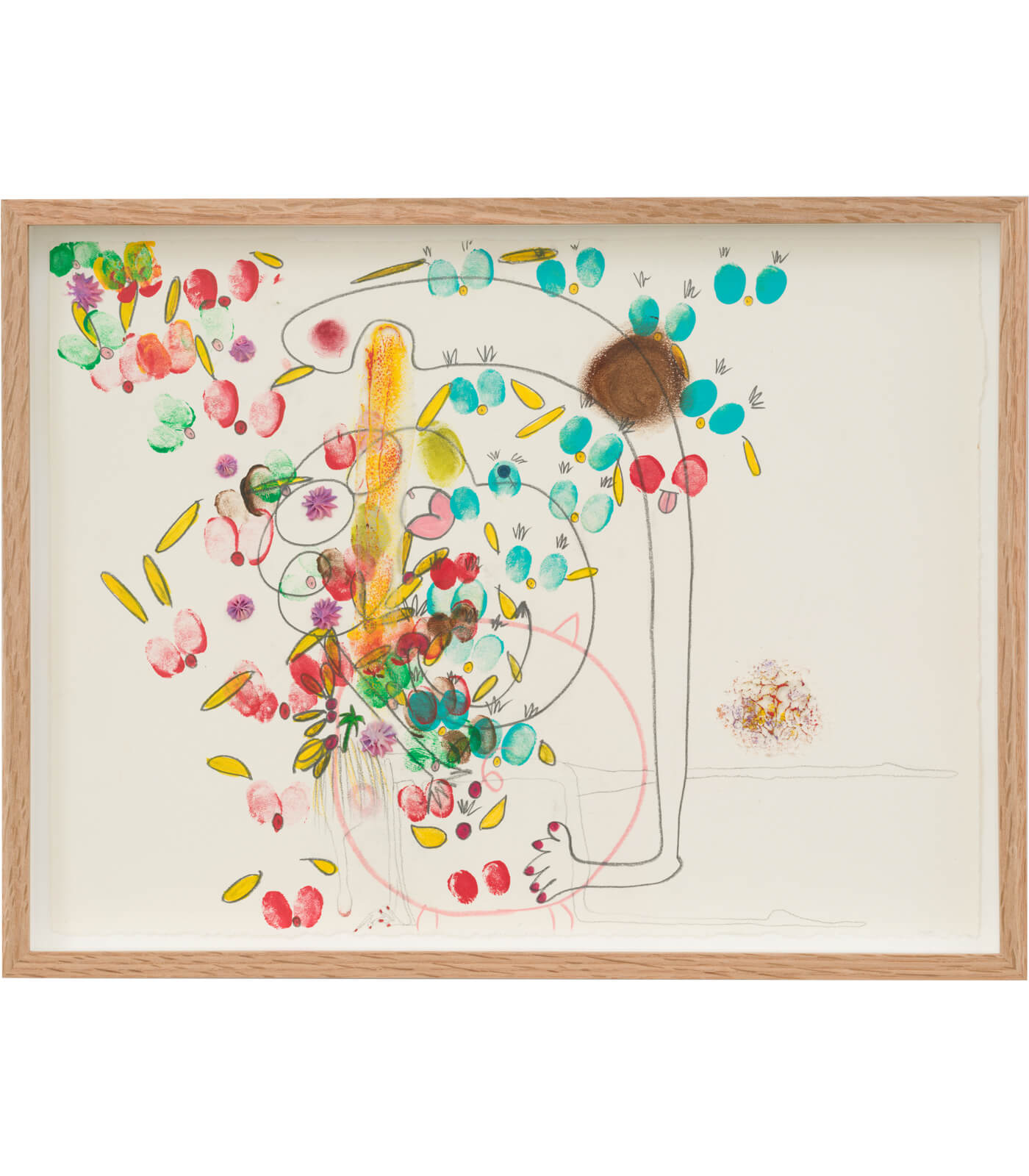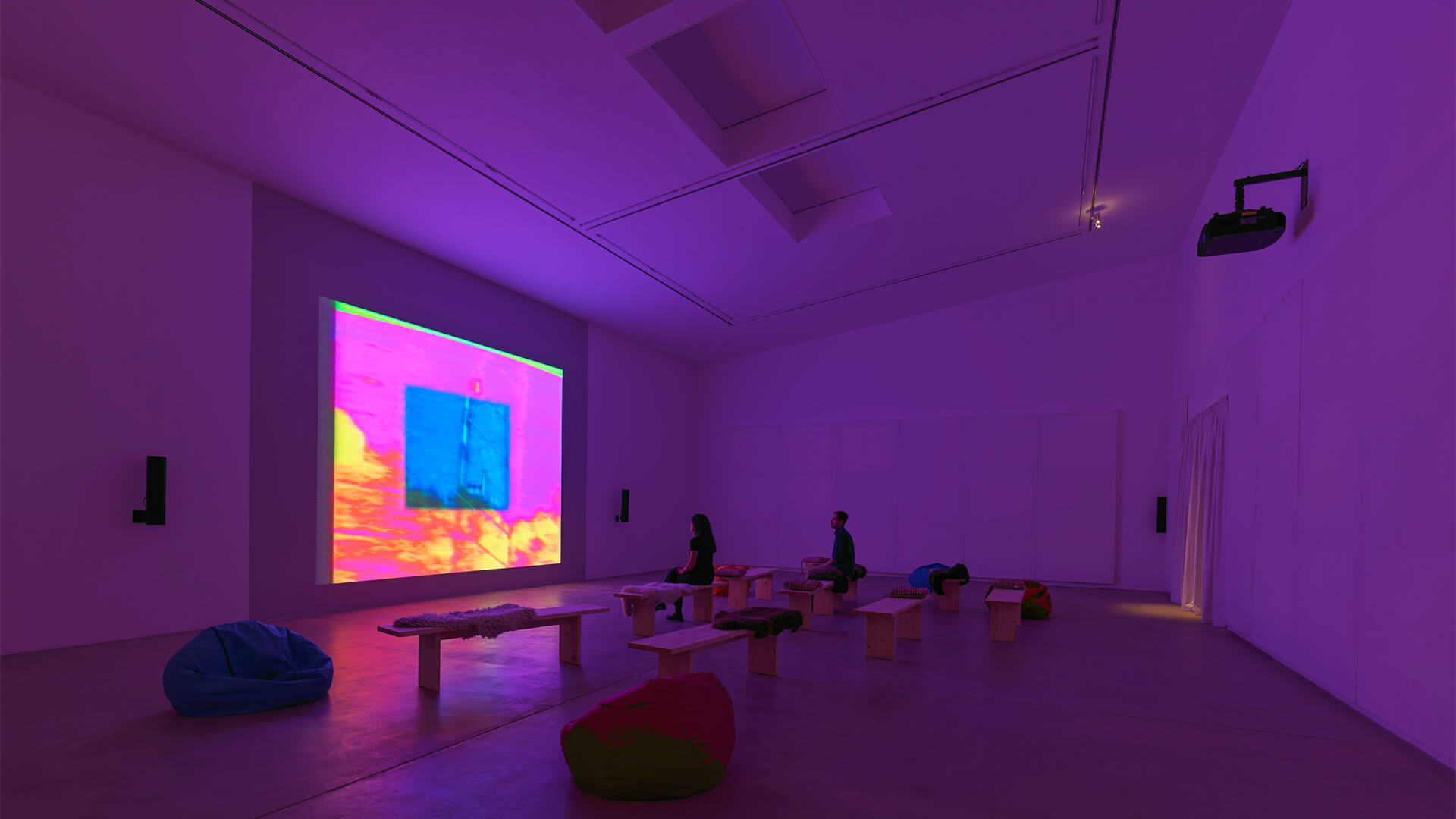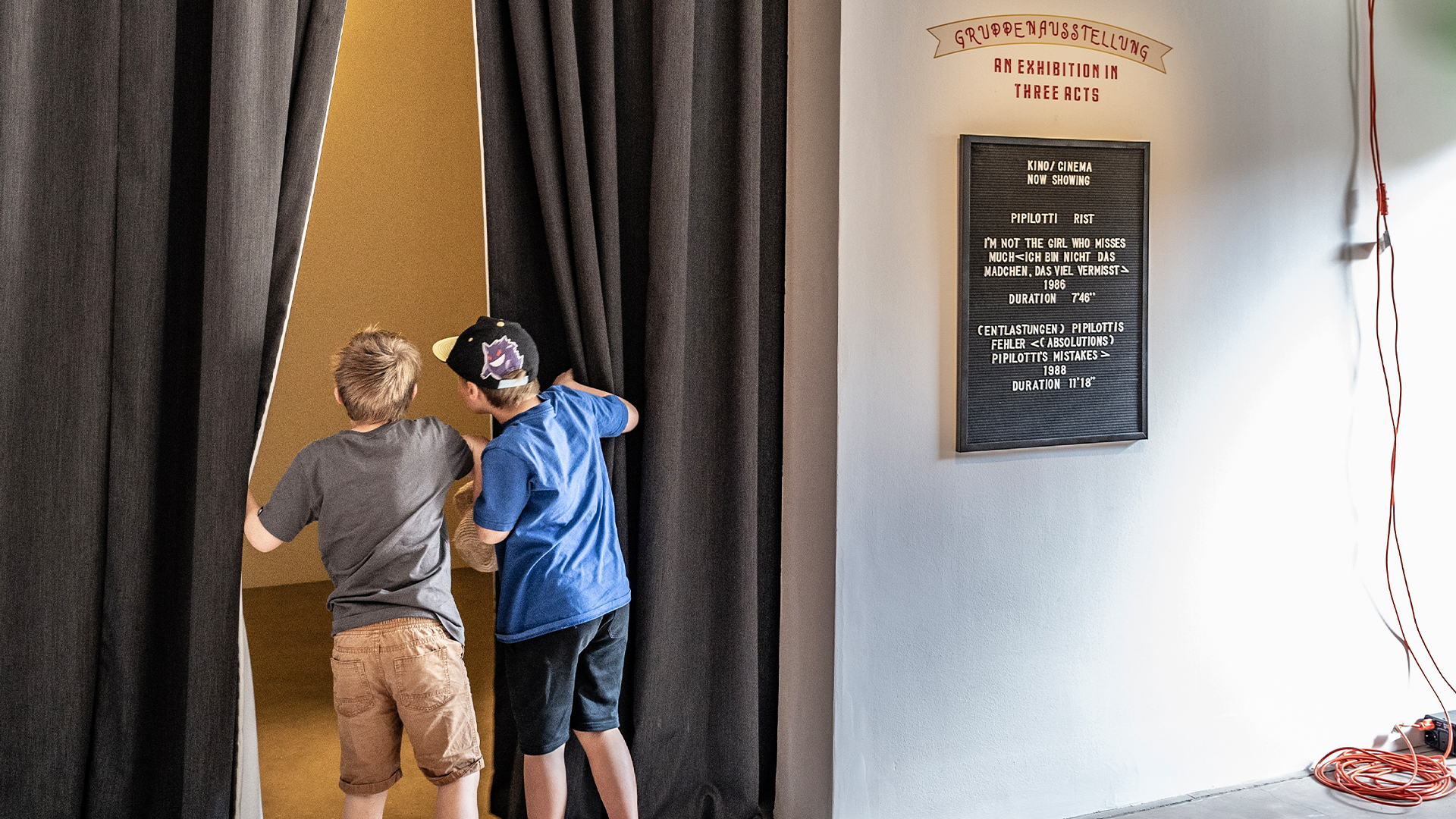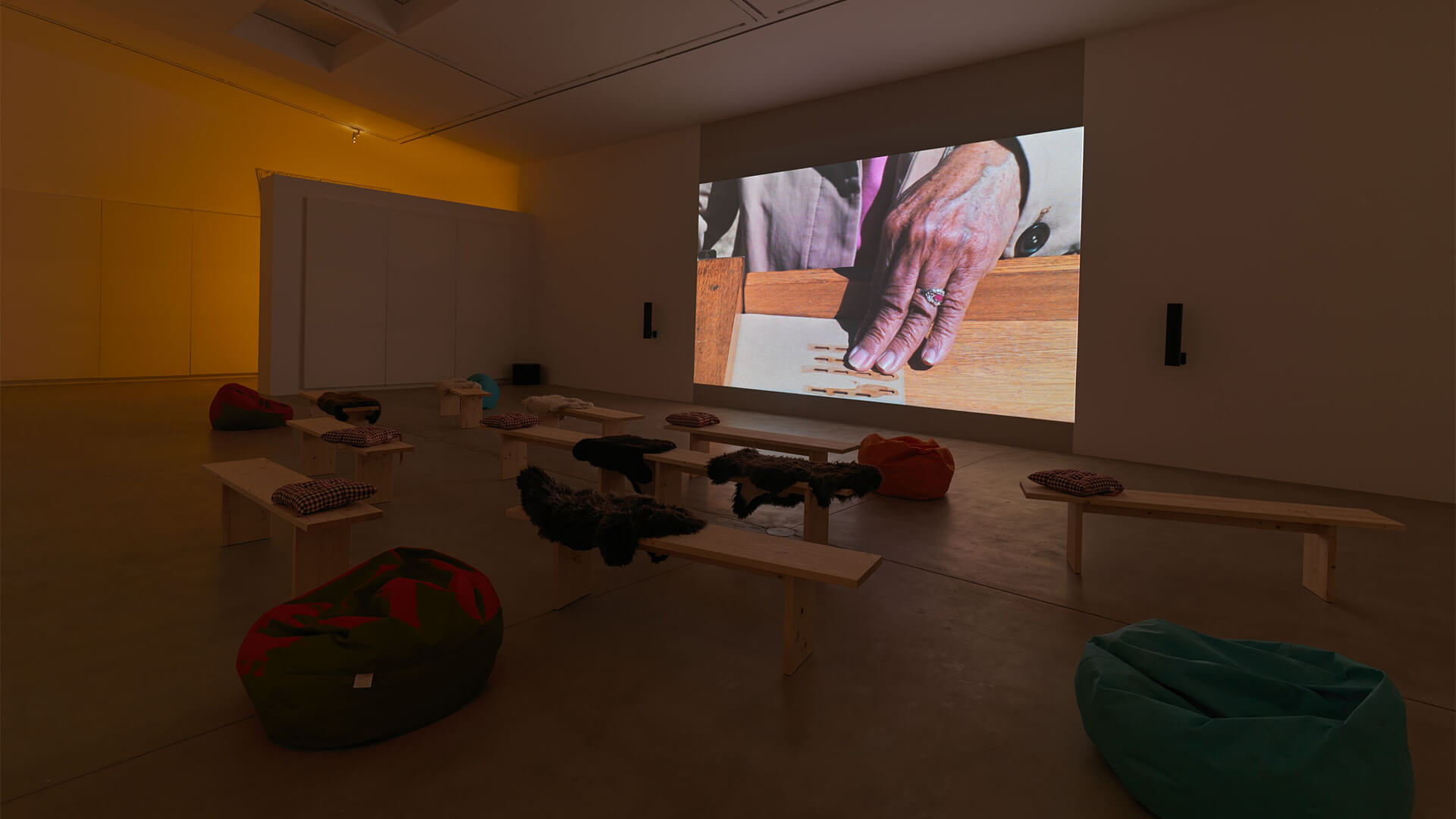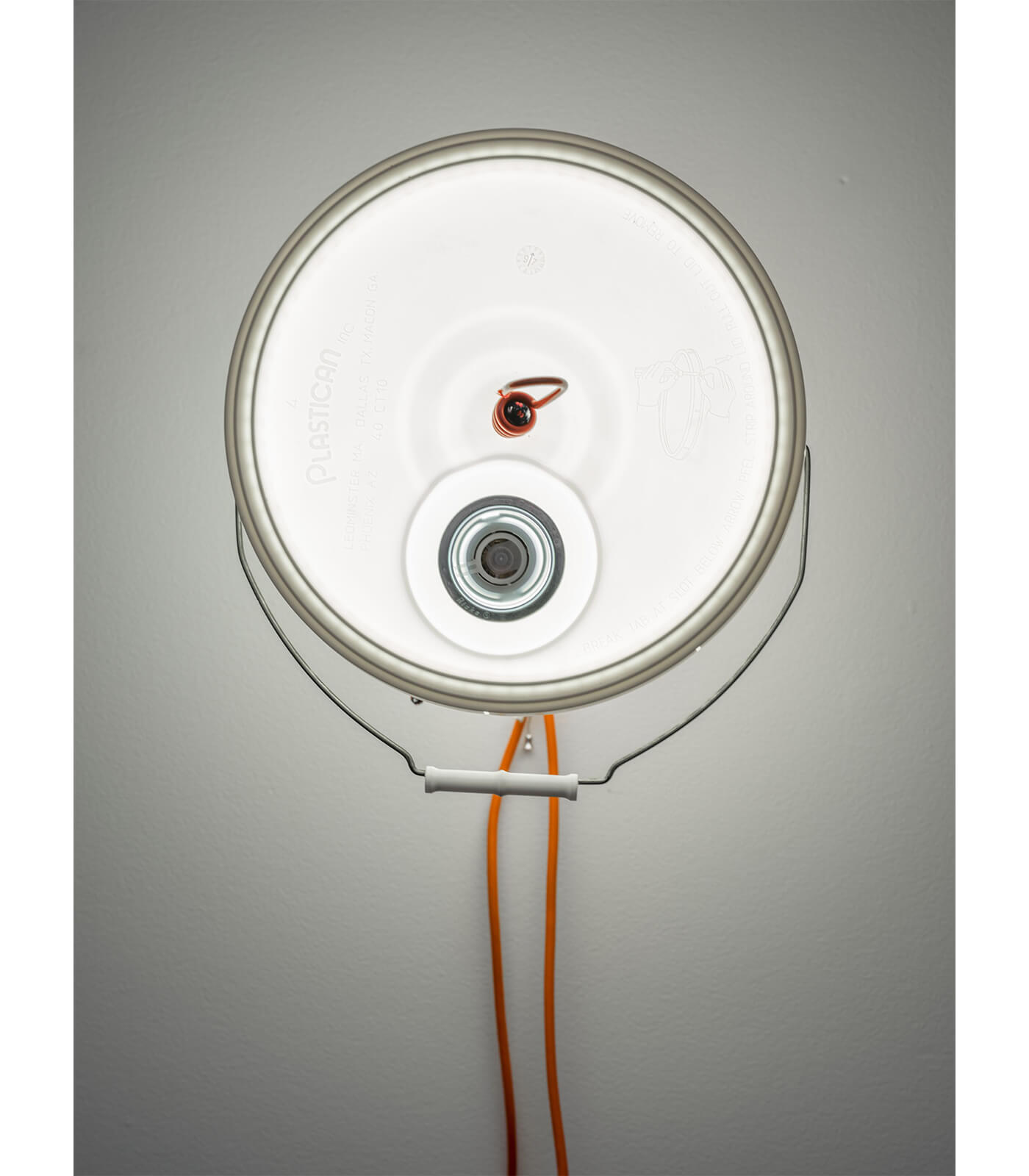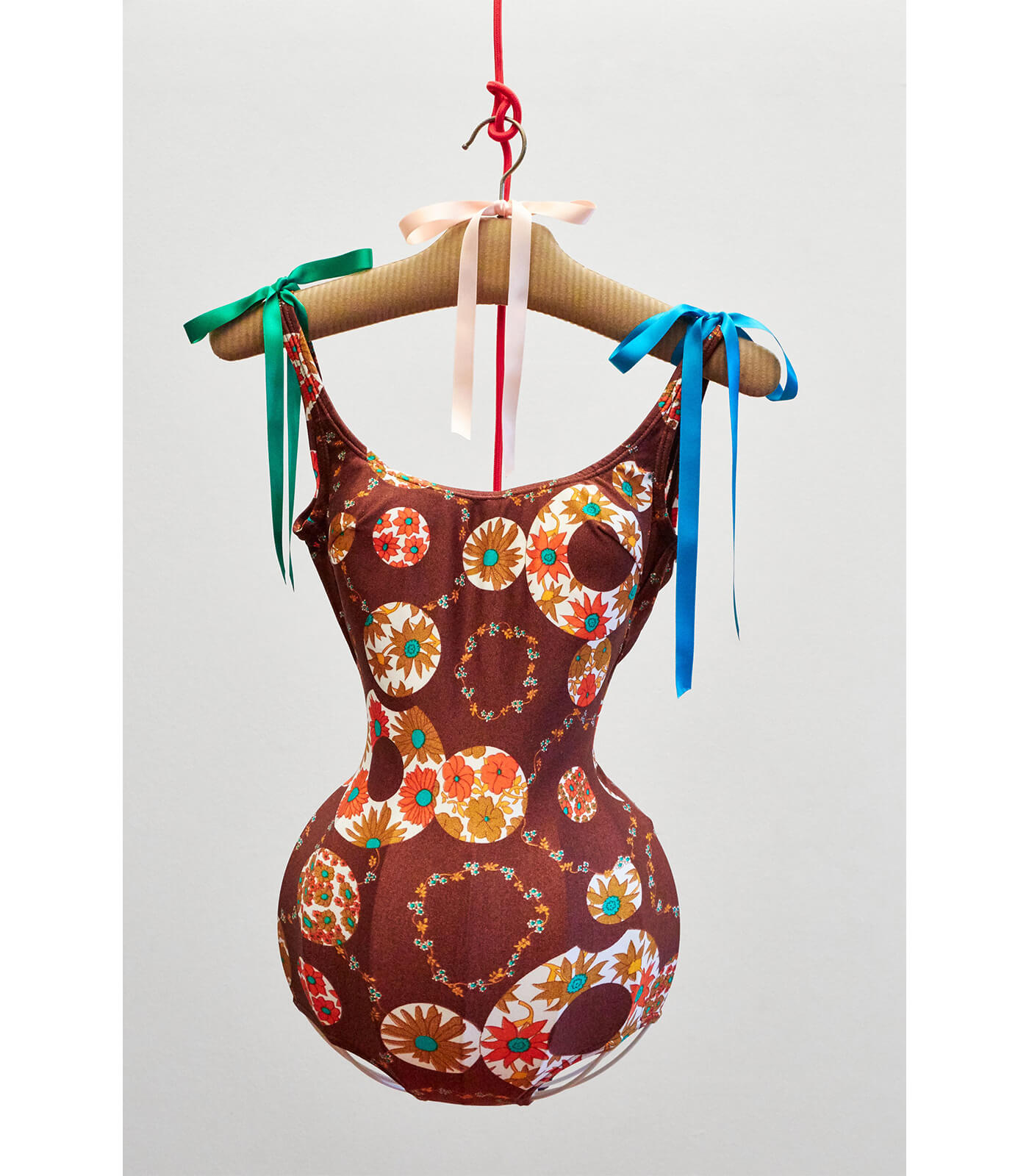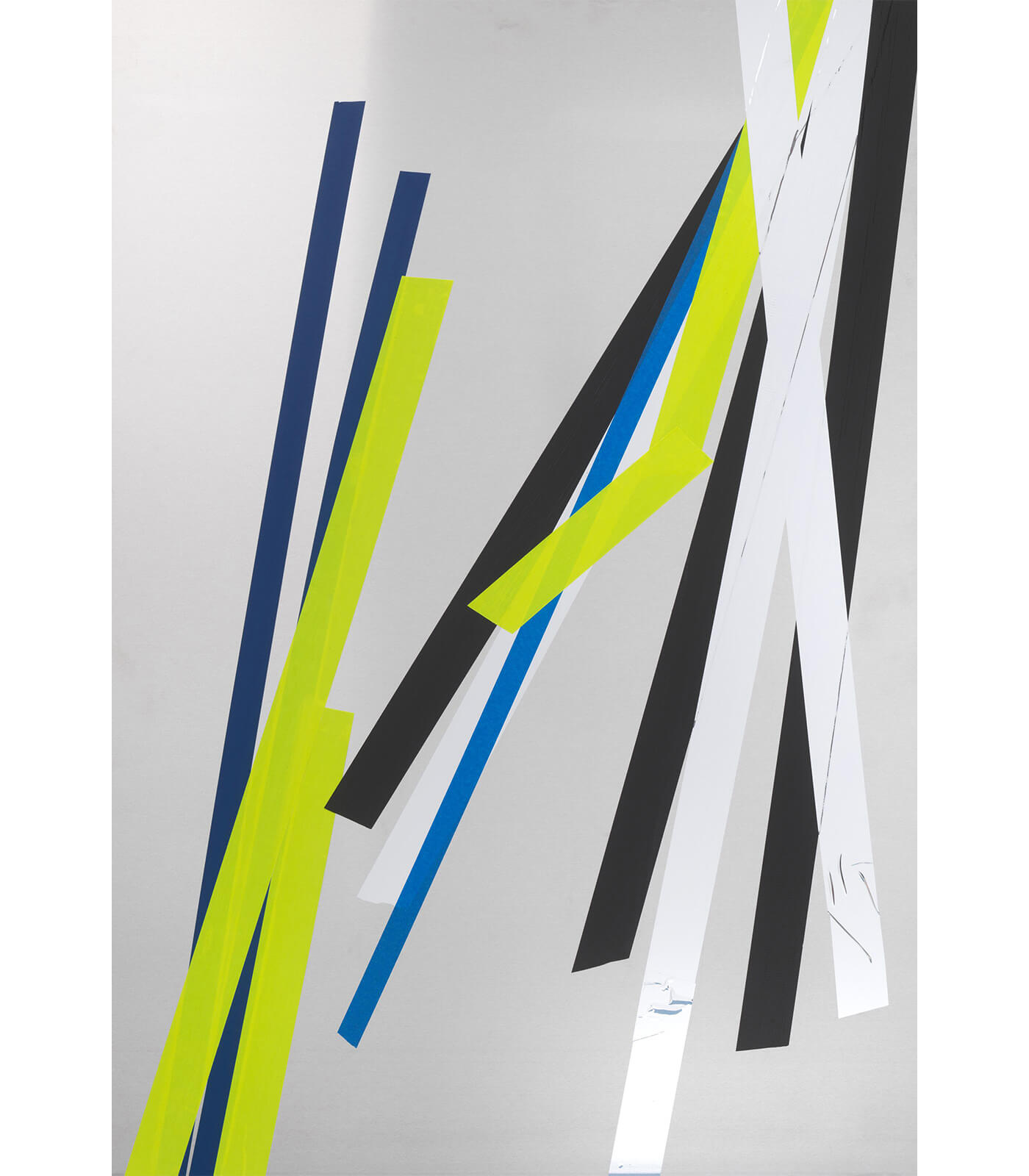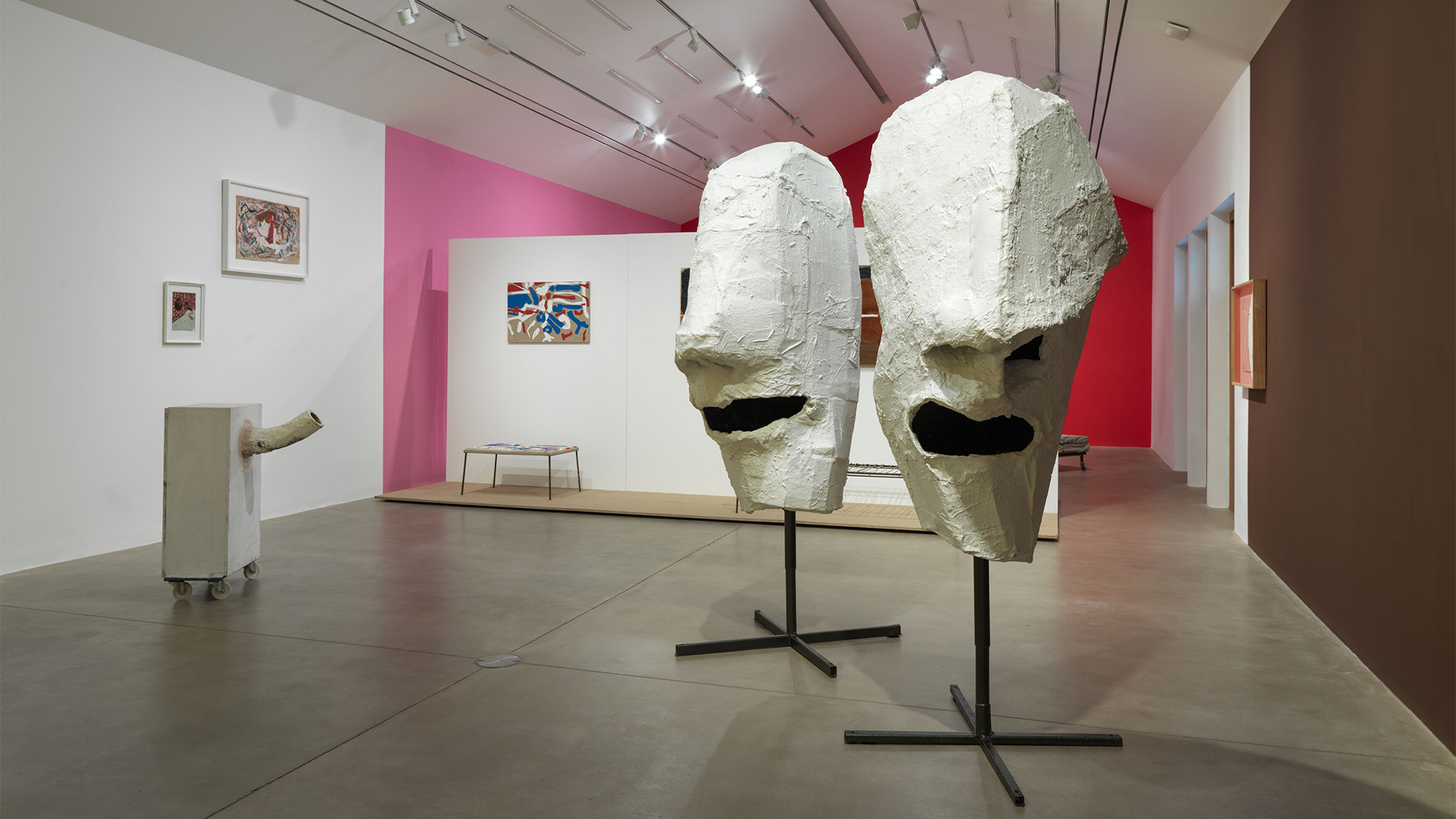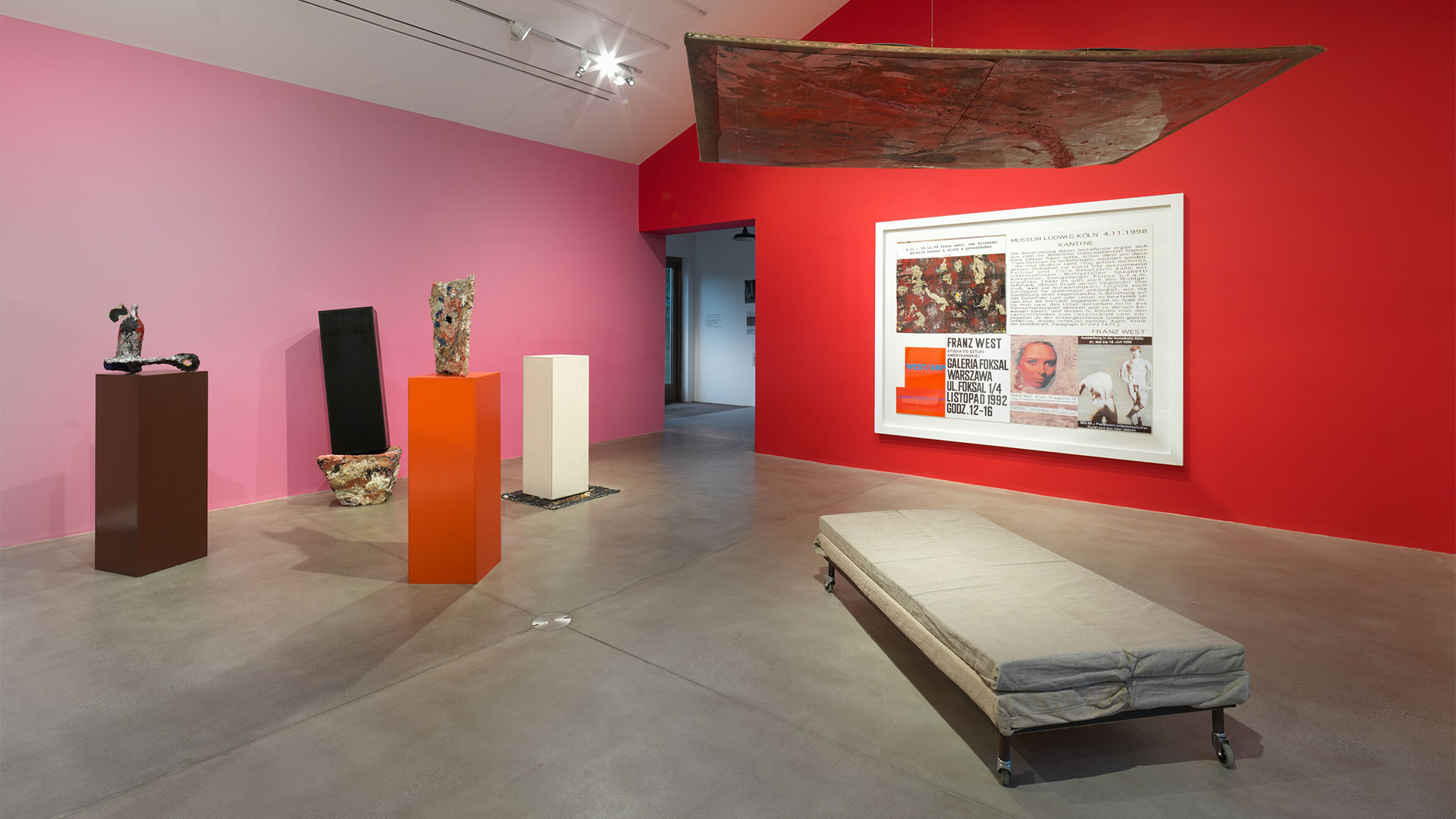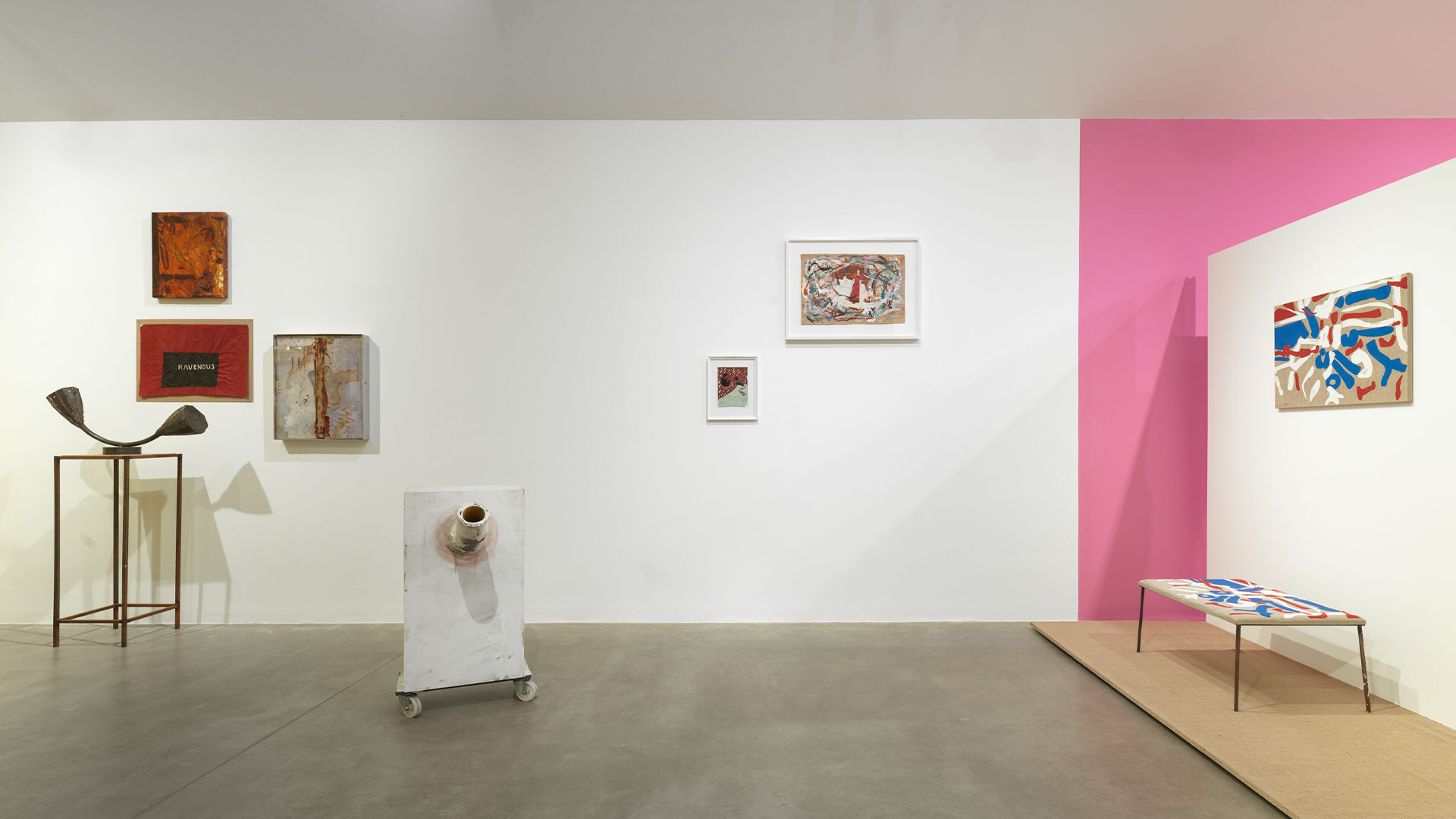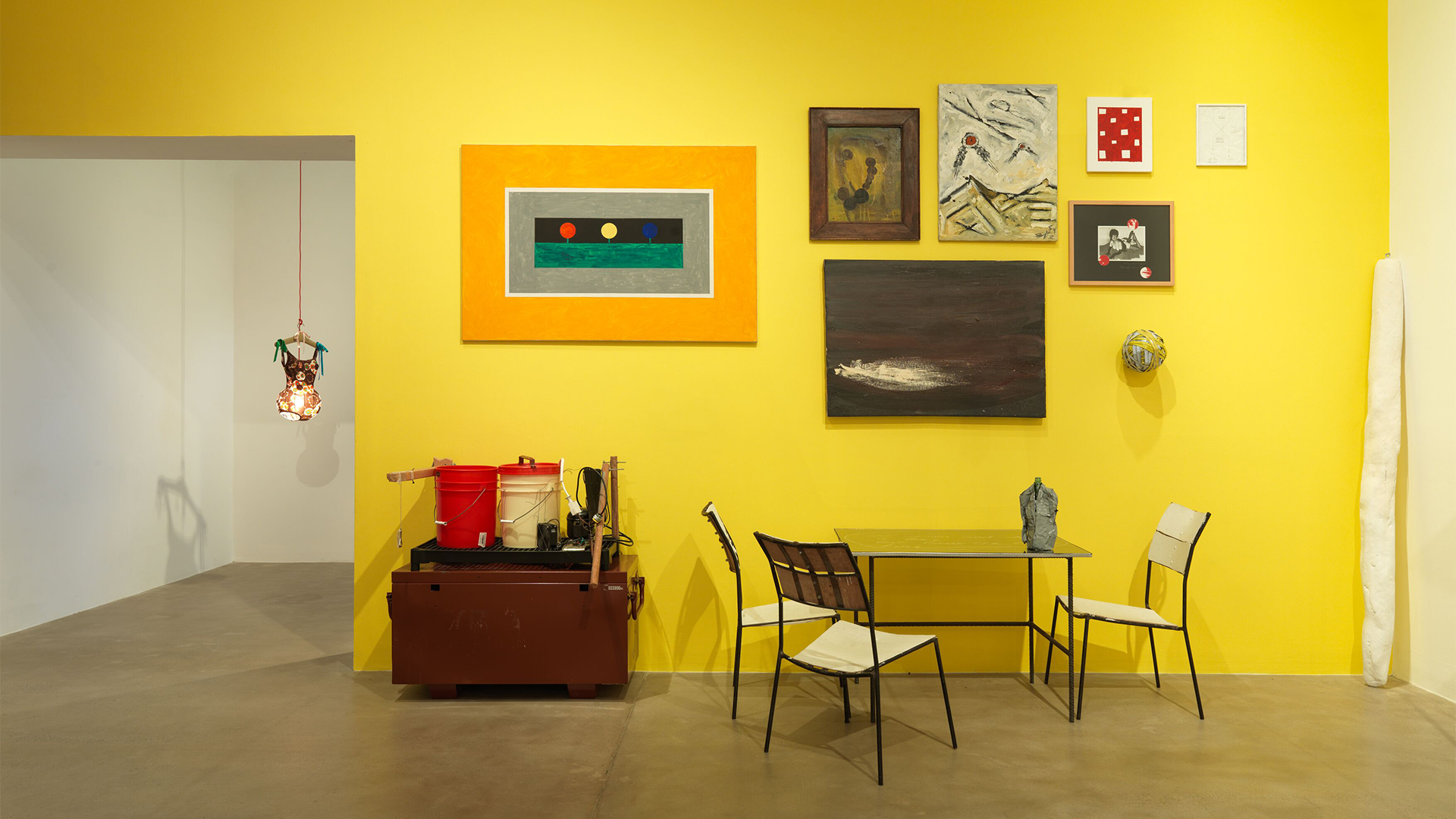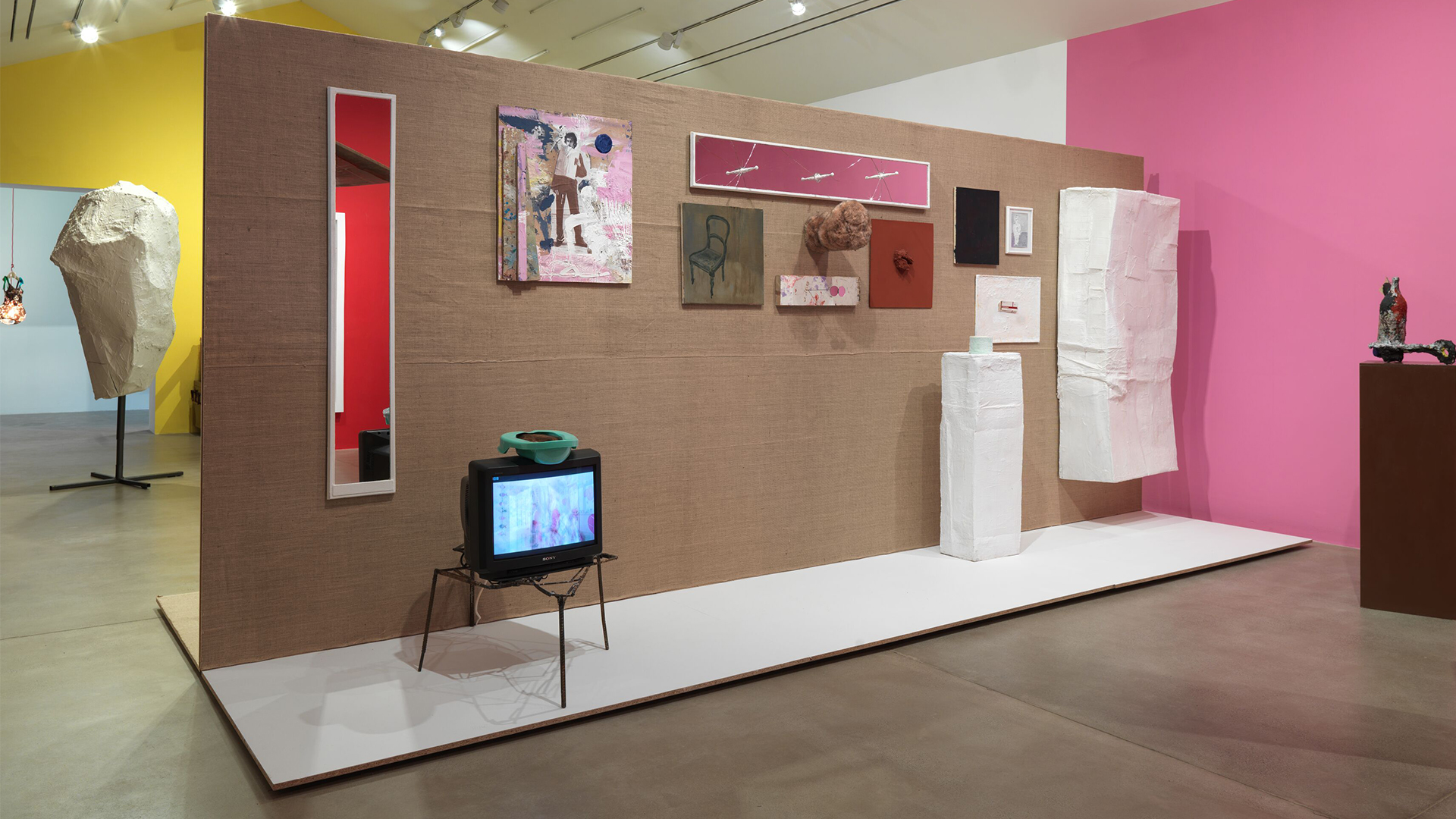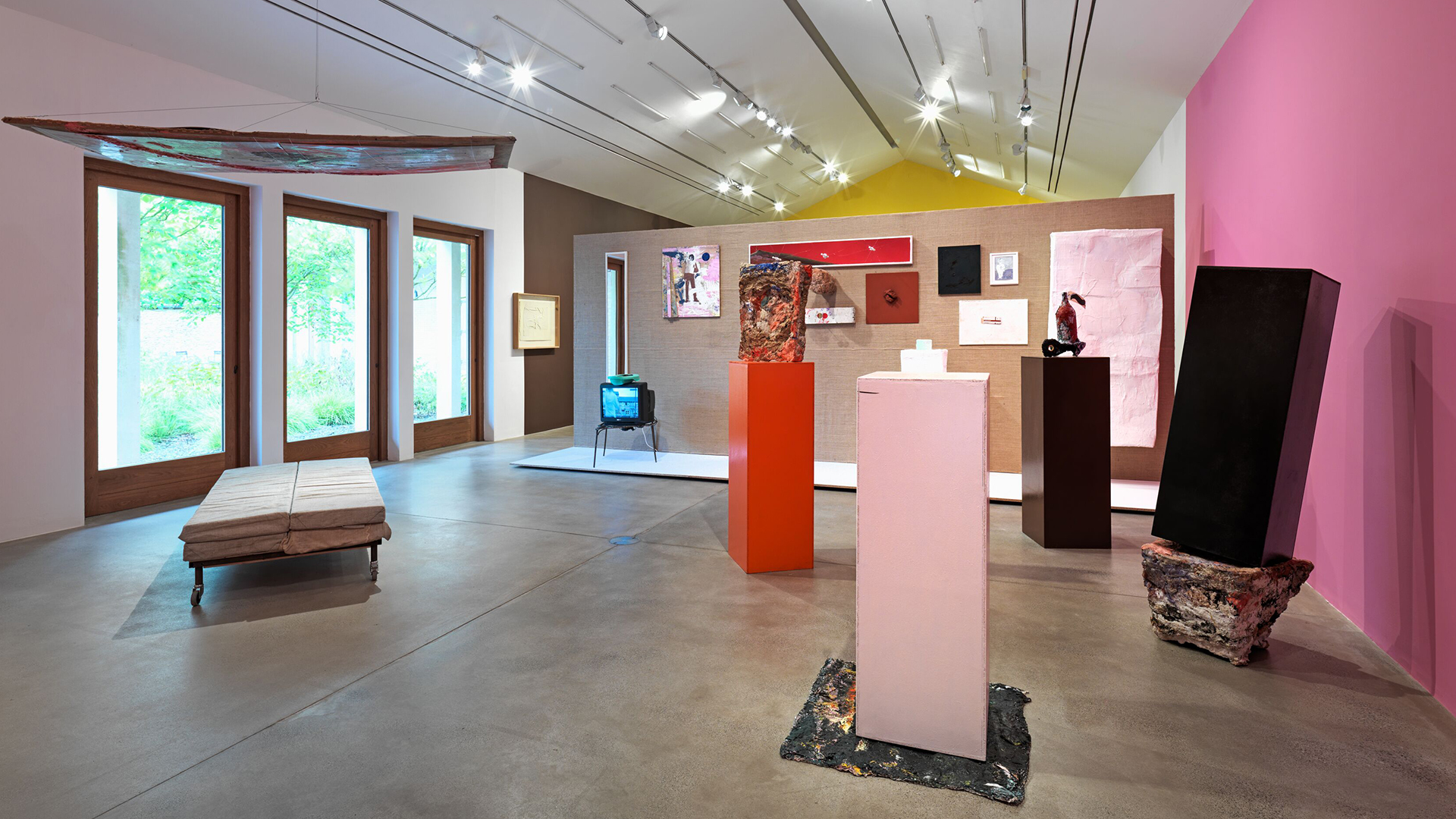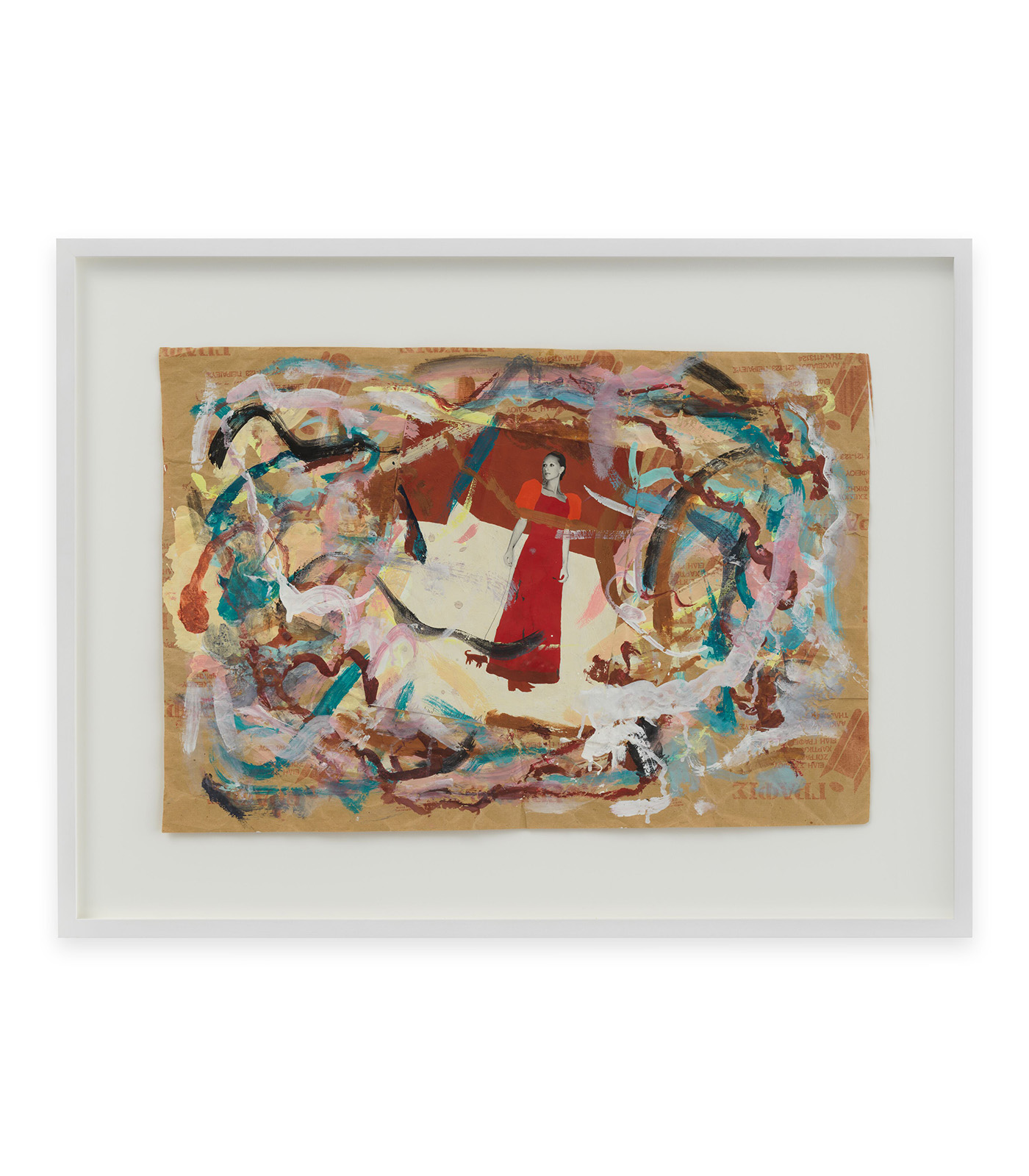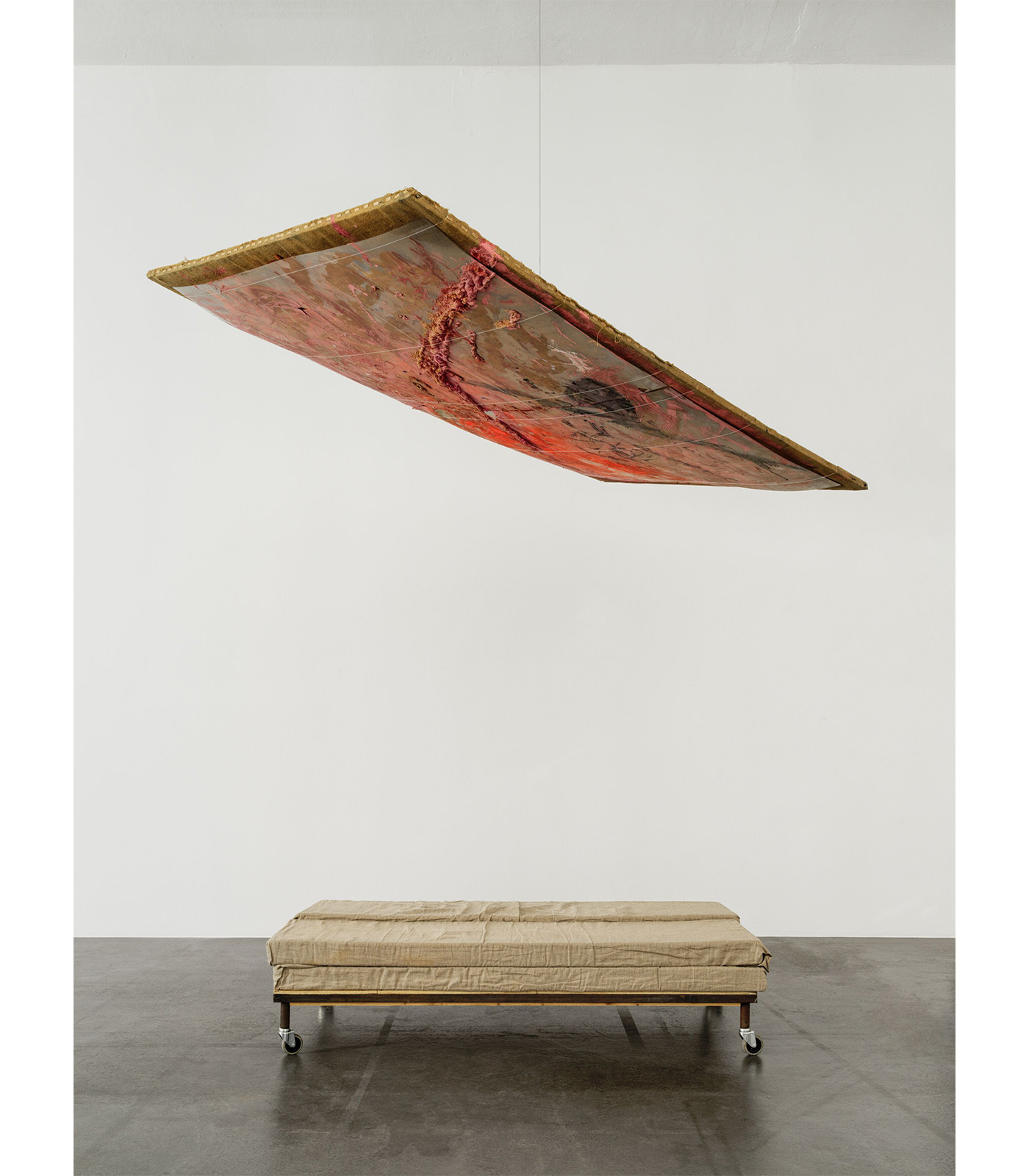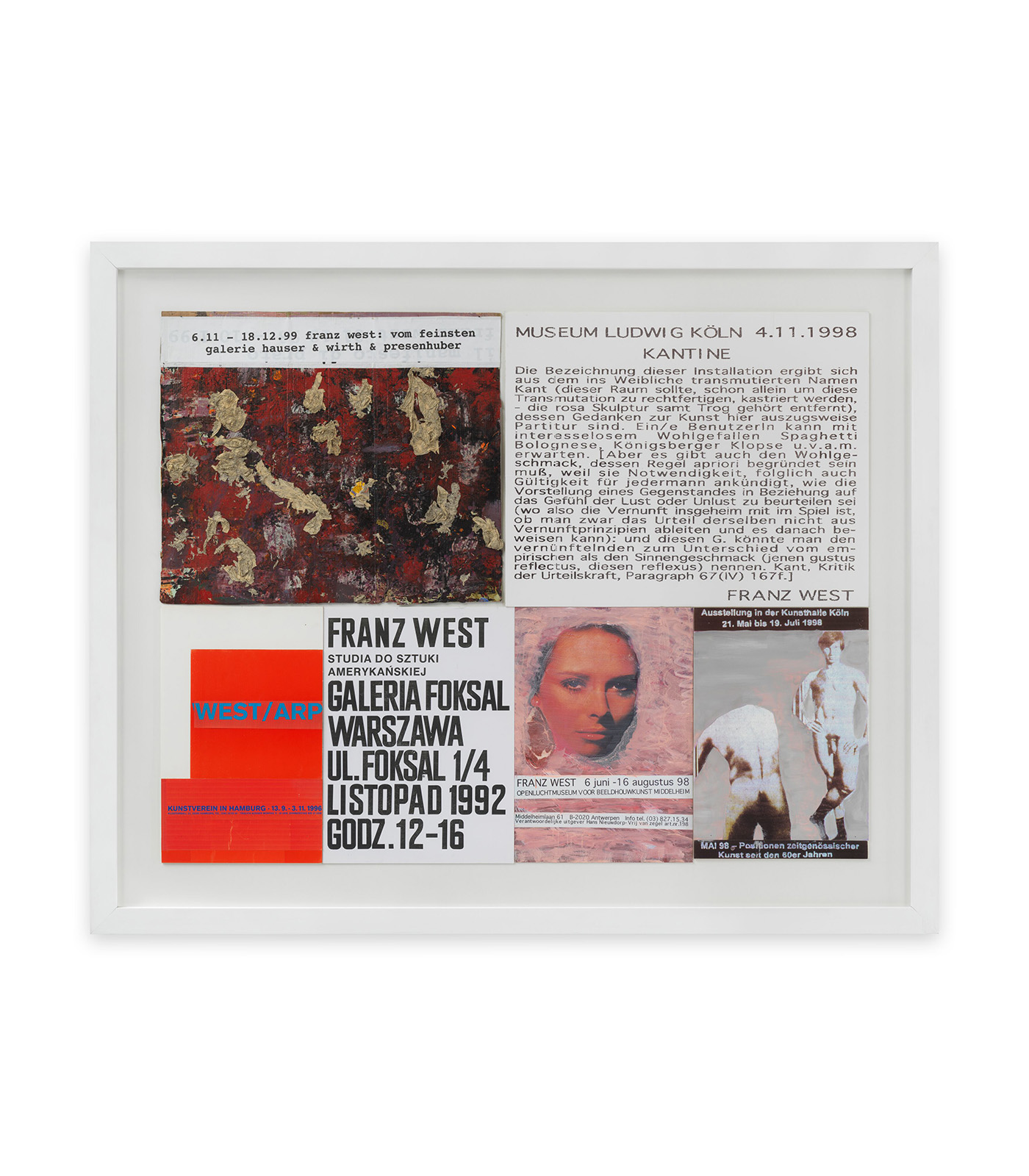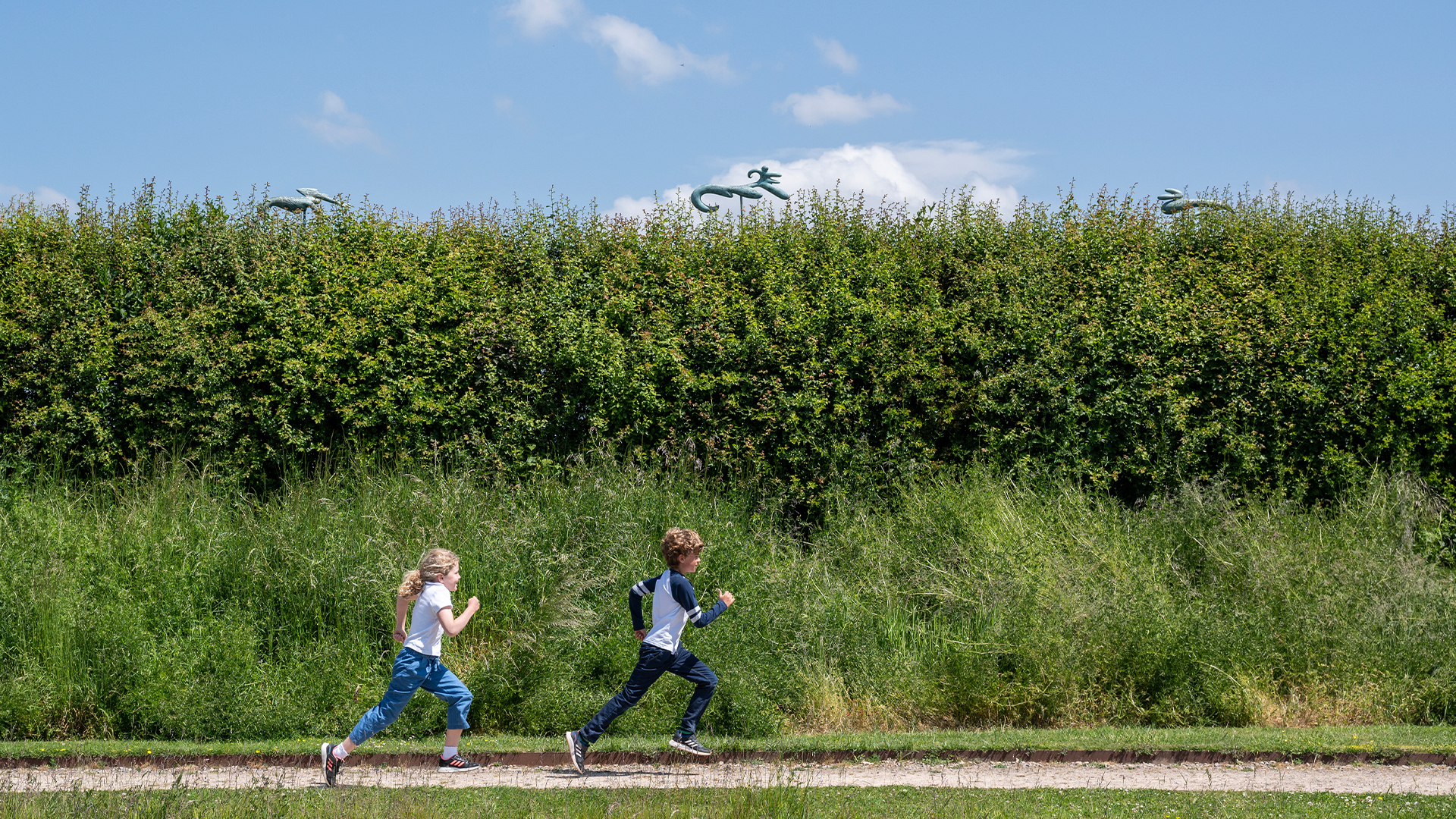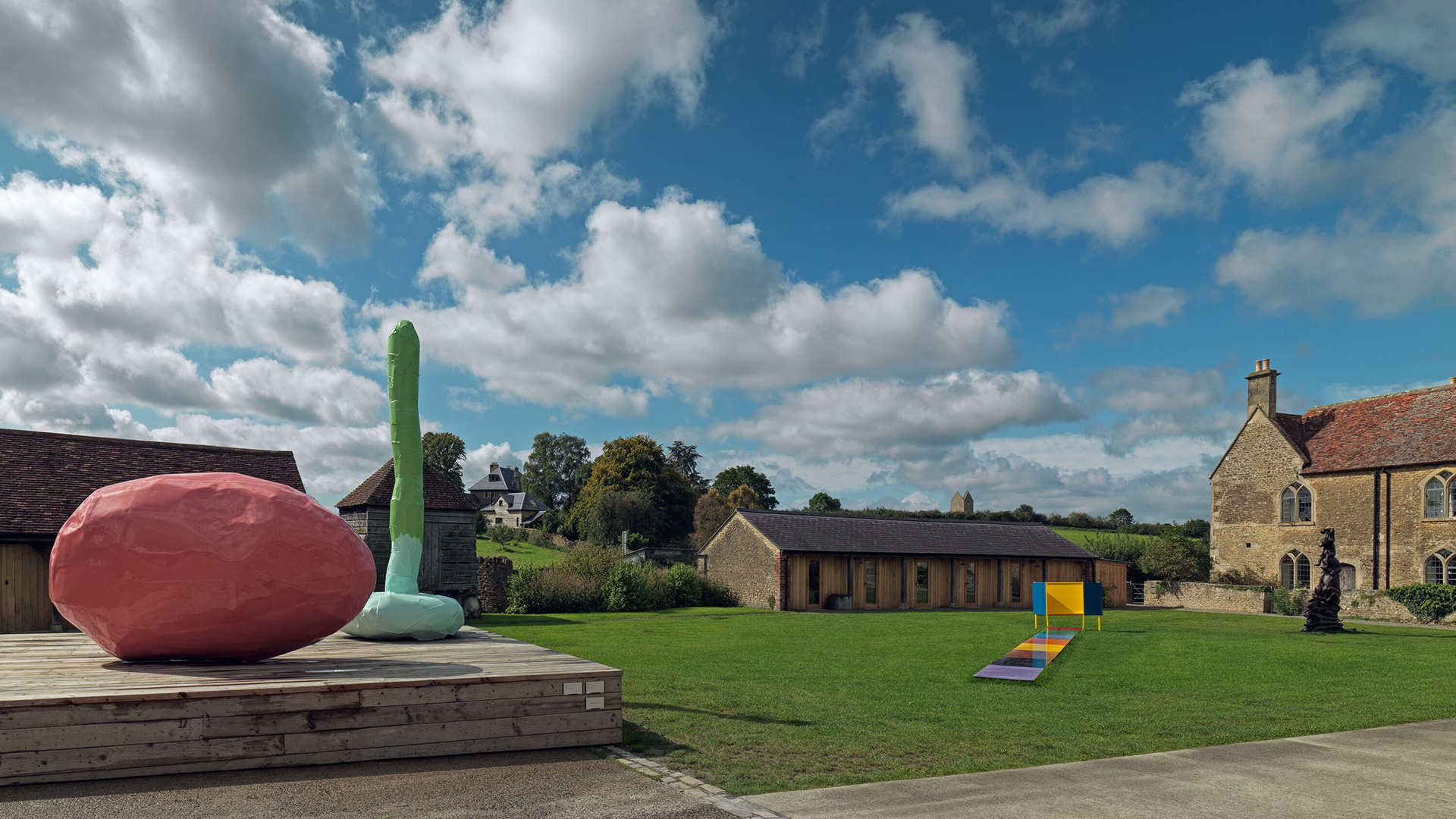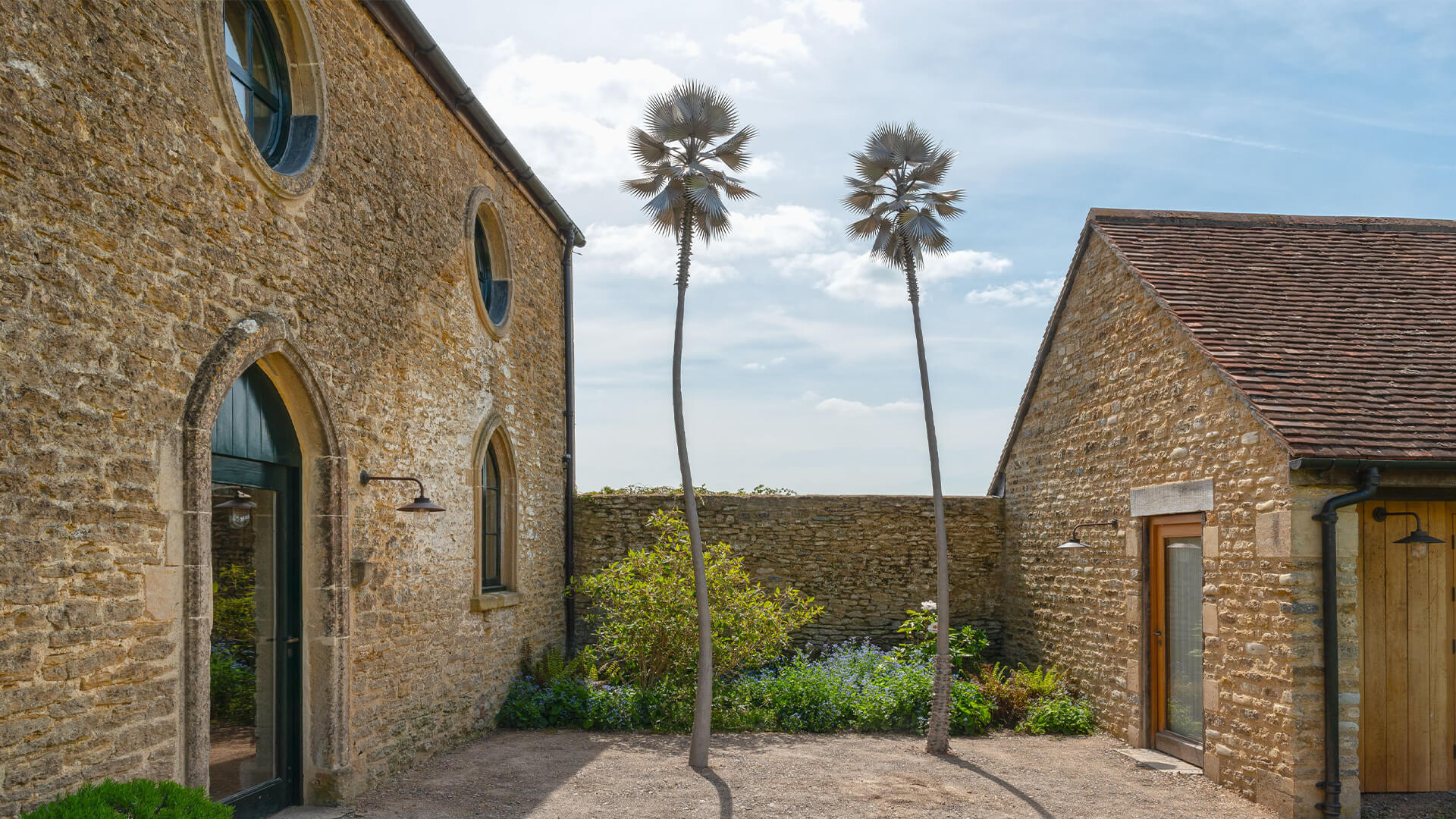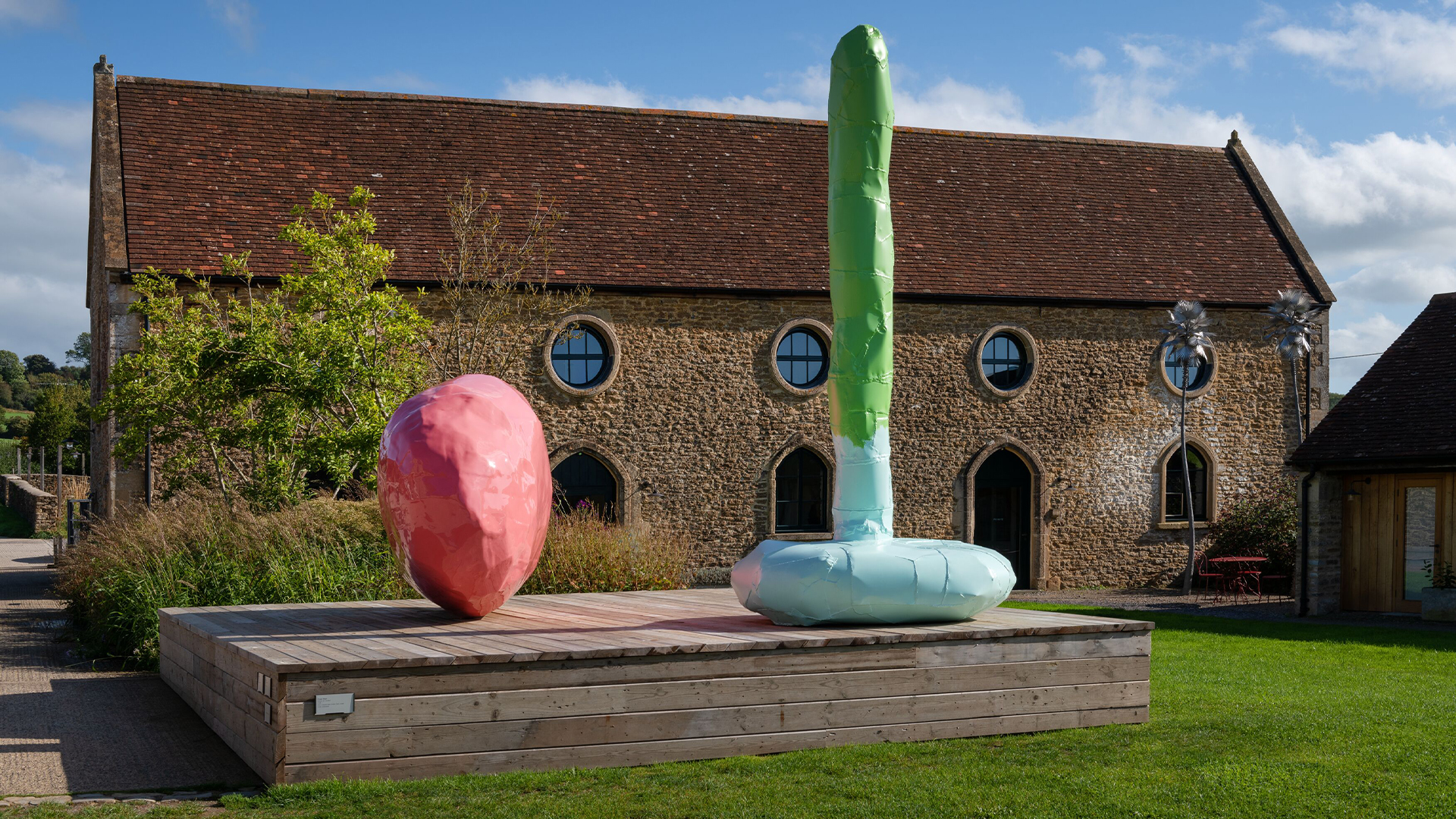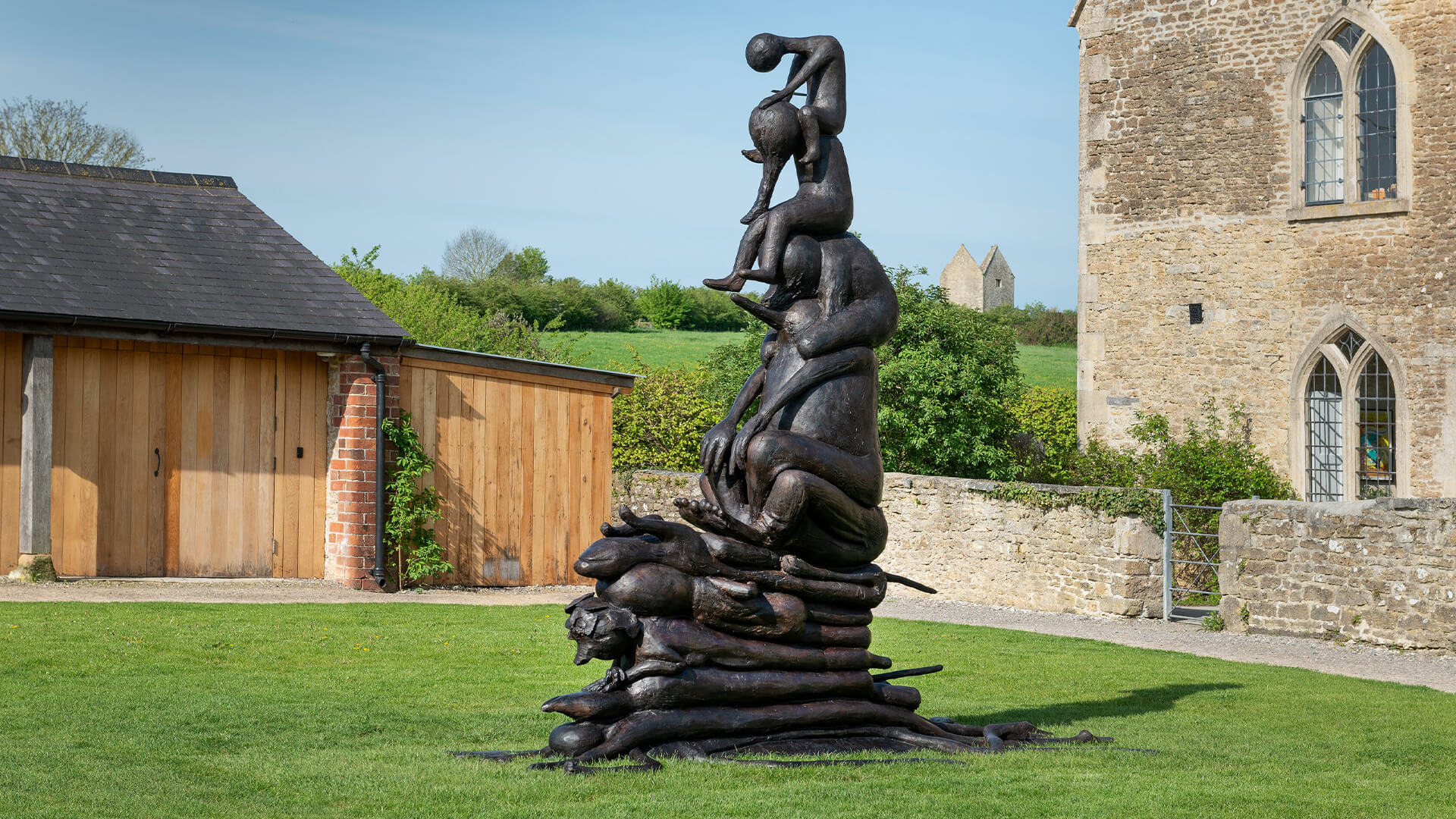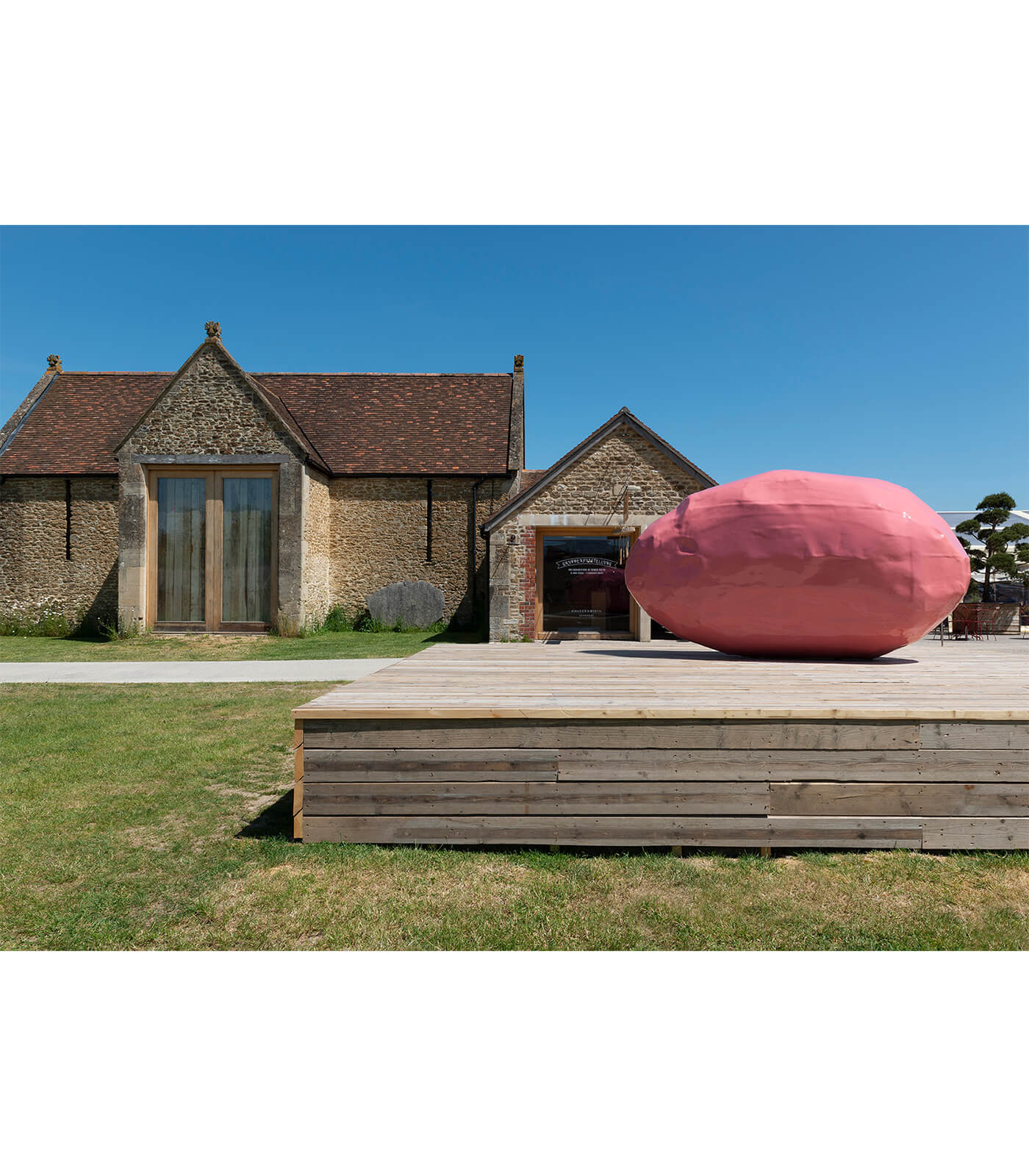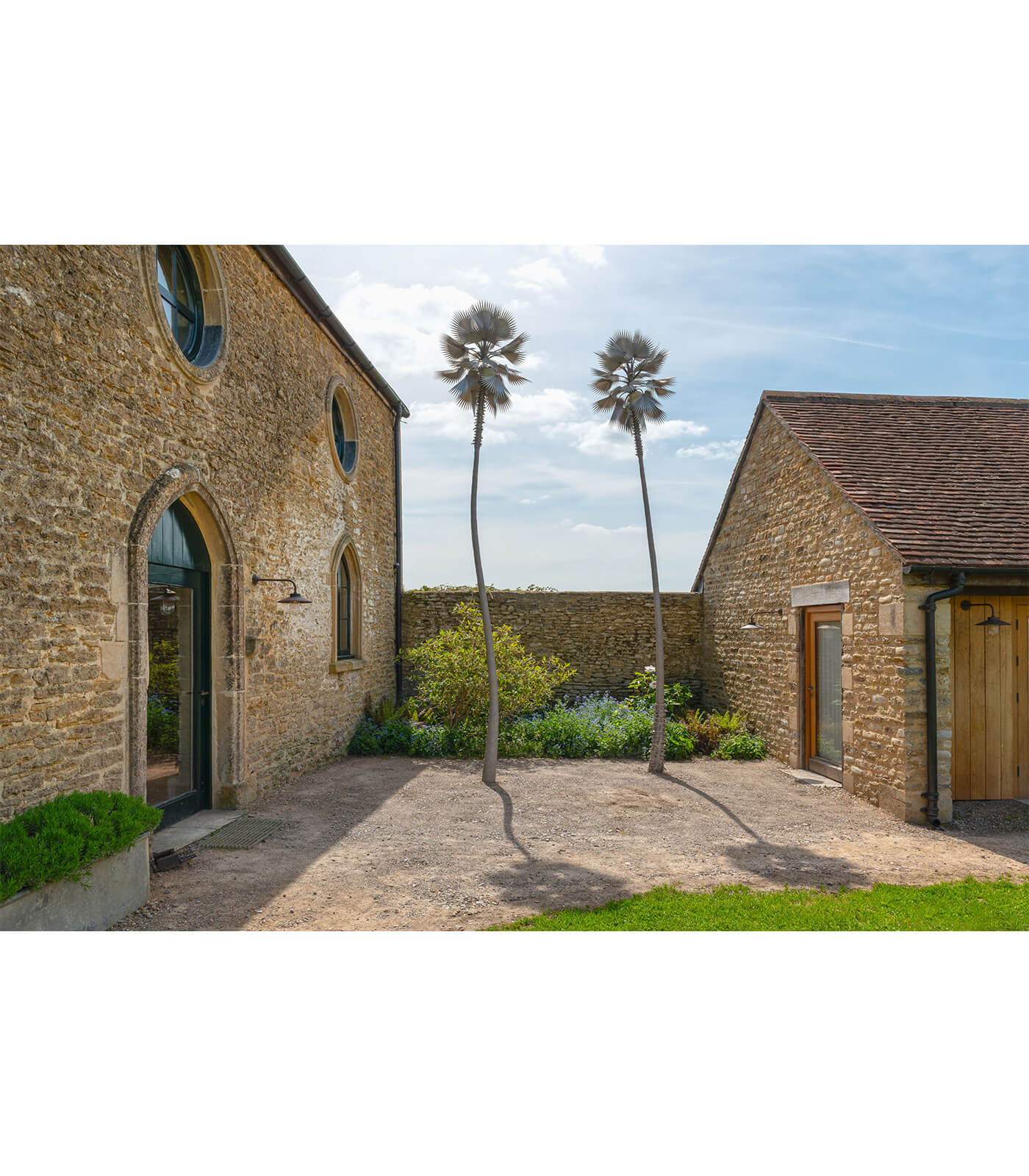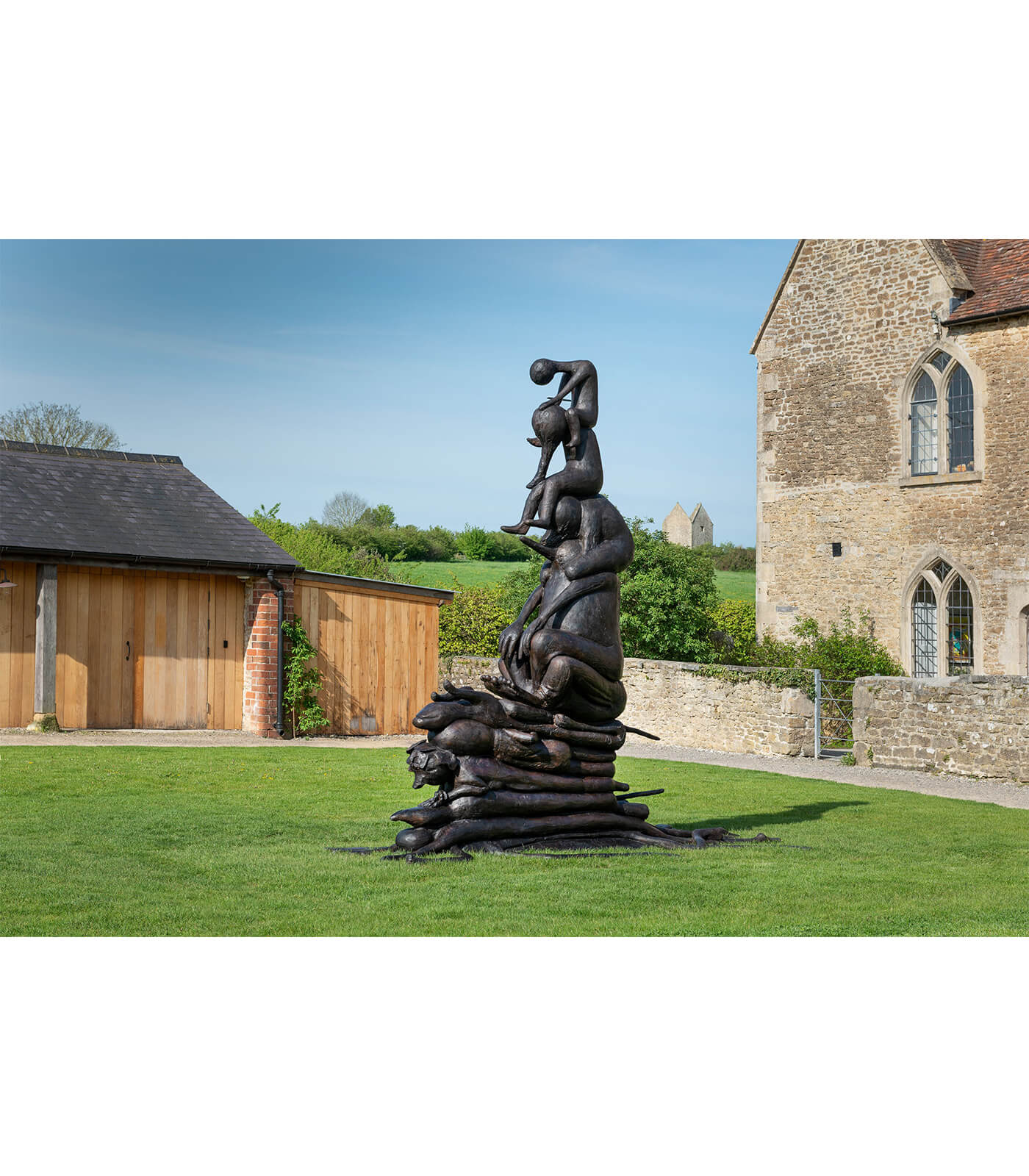A celebration of Hauser & Wirth’s Swiss heritage through a playful presentation of over 20 artists, including Phyllida Barlow, Martin Creed, Nicole Eisenman, Isa Genzken, Rodney Graham, Richard Hamilton, Mary Heilmann, Camille Henrot, Jenny Holzer, Richard Jackson, Rashid Johnson, Allison Katz, Paul McCarthy, Jason Rhoades, Pipilotti Rist, Dieter Roth, Björn Roth, Mika Rottenberg, Anri Sala, Cindy Sherman, Roman Signer, Lorna Simpson, Alina Szapocznikow, Franz West and David Zink Yi.
Explore the Exhibition
The multidisciplinary exhibition is inspired by the notion of a traditional Kunsthalle, conceived as a place to showcase groundbreaking art and explore contemporary issues with a broad audience. The entire site takeover provides a platform for discovery and interaction, extending to all five galleries, outdoor sculpture and a collaborative events program with the Roth Bar & Grill. The exhibition will evolve in three parts over the course of seven months, featuring immersive installations, solo presentations and iconic video works.
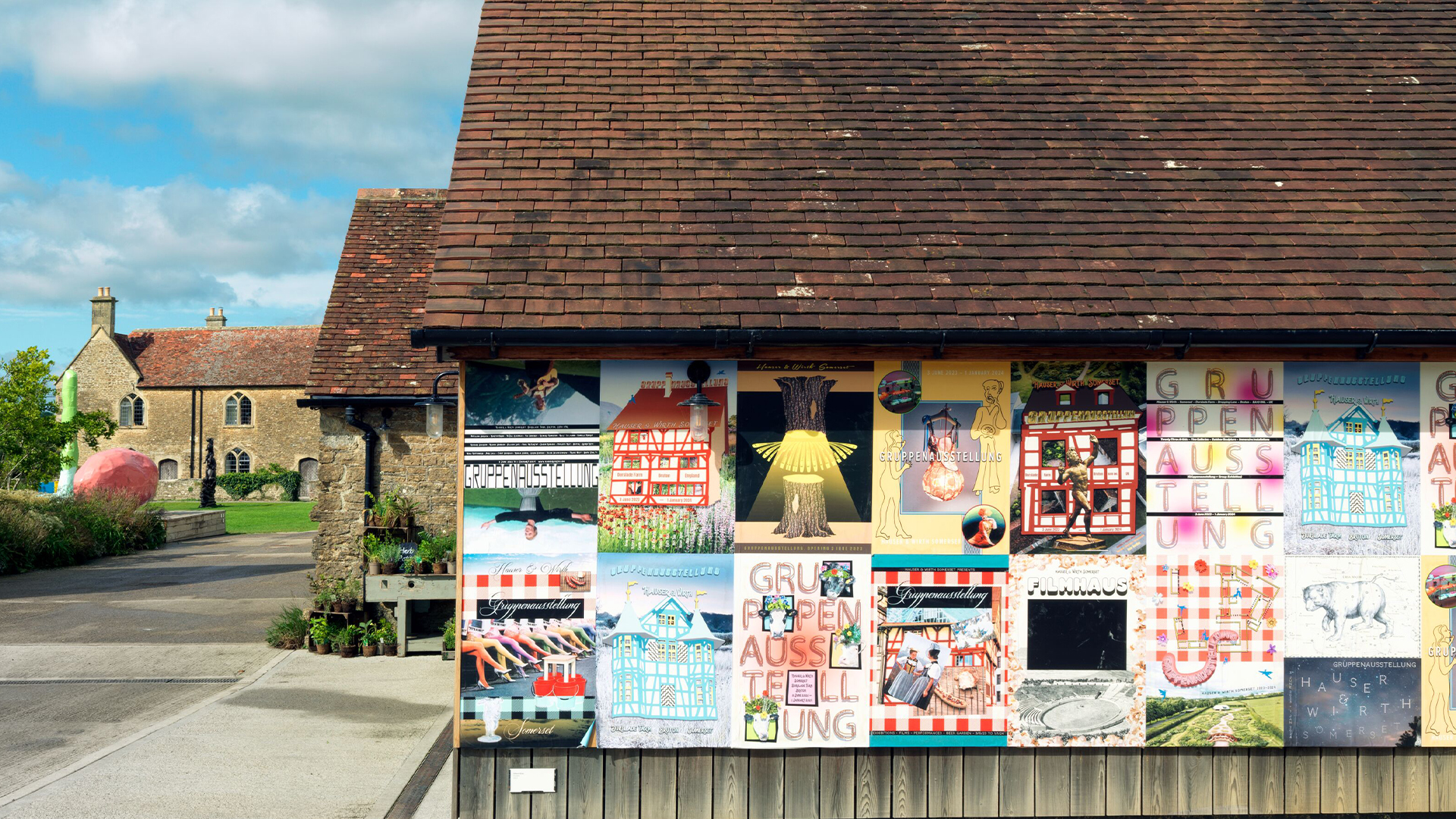
Artists are central to the experimental ethos of Hauser & Wirth Somerset, fostering new points of connection and inclusive approaches to experiencing art. Many of the artists featured within the exhibition, such as Martin Creed, Rashid Johnson and Pipilotti Rist, have lived and worked in Bruton as part of the gallery’s longstanding residency program, drawing inspiration from Durslade Farm, the local community and surrounding Somerset landscape. Our recent artist-in-residence, Allison Katz, has created a series of new exhibition posters that are displayed across the site. For Katz, designing posters is a way of playfully exploring protocols of typography, language and graphics, whilst addressing themes of consumption, desire and memory.
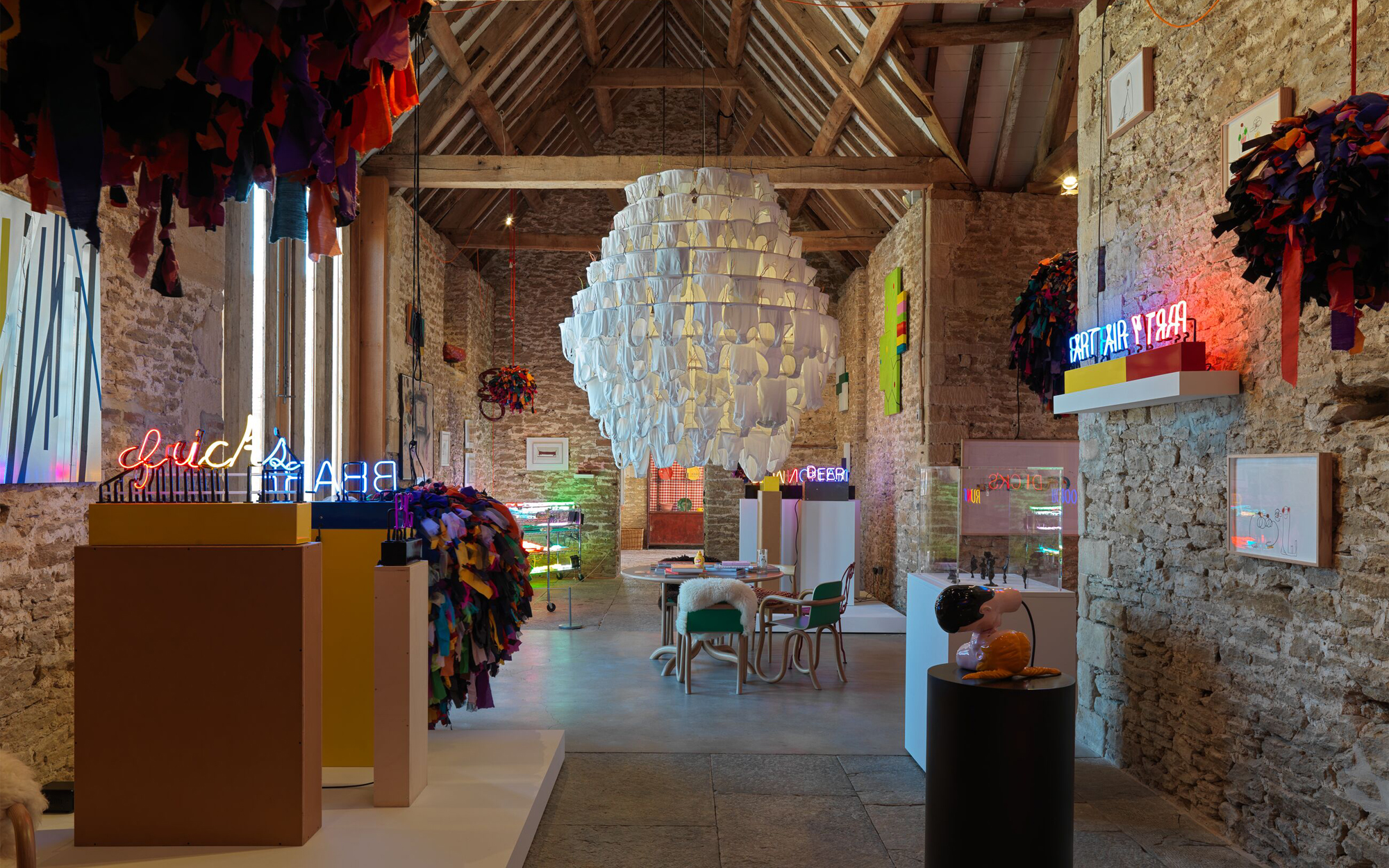
Martin Creed’s ‘Work No. 243 HELLO’ (2000) greets visitors as they enter the Threshing Barn. A true polymath, Creed’s work blurs the distinction between art and life, bringing the world into his work with fascinating transparency and humor. Stand out sculptures and video installations by Phyllida Barlow and Pipilotti Rist are centrepieces within the multisensory spectacle that fill the space from floor to ceiling. A pioneer of spatial video art, Rist’s ‘香港中環吊燈 (Central Hong Kong Chandelier)’ (2021) draws on the inner and outer worlds of kaleidoscopic wonderment. Rist encourages her viewers to recline, inviting them to contemplate, and at the same time, share a collective experience with their fellow spectators.
Richard Jackson’s neon signs flash with evocative puns and statements that engage with the artist’s interest in hunting culture and its vernacular, seen in works such as ‘HOTSHOT’ (2022), ‘BIG FAT PIG’ (2010) and ‘BARE BEAR’ (2008). Jackson’s work offers an ironic comment on the heroic pretensions associated with the medium, with works such as ‘Art Fair Party’ (2014), a direct and humorous critique of the structure of the commercial art world. Jason Rhoades’ neon installations, such as ‘Shelf (Mutton Chops) with Unpainted Donkey’ (2003), continue to signpost social commentary whilst pushing against the safety of cultural conventions. The unbridled, brazenly maximalist works attract, repulse and mystify the viewer, igniting questions that only multiply with prolonged exposure.
The Workshop and Pigsty Galleries have transformed to showcase Mika Rottenberg’s seminal video installation, ‘Cosmic Generator (Loaded #2)’ (2017 – 2018). This surreal and subversive video work explores globalisation, labor and spectacle, and is perhaps the best introduction to Rottenberg’s oeuvre. Filmed on-site at a market for plastic goods in Yiwu, China and in Mexicali, Mexico, a town near the US border, which is home to a large Chinese population, the video installation forms connections among seemingly disparate geographies. The video mixes scenes of real locations with elements of magical realism shot in a studio. The distinction between fantasy architecture and real space is further blurred by a fabricated tunnel surrounding the video installation, through which viewers enter the space, and a curtain of coloured tinsel through which they exit.
The ‘Kino / Cinema’ presents a changing weekly schedule of important film and video works over the course of the exhibition, featuring Martin Creed, Nicole Eisenman, Rodney Graham, Camille Henrot, Richard Jackson, Rashid Johnson, Paul McCarthy, Mika Rottenberg, Pipilotti Rist, Anri Sala and Lorna Simpson. Pipilotti Rist’s video works ‘I’m Not The Girl Who Misses Much’ (1986) and ‘(Entlastungen) Pipilottis Fehler’ <(Absolutions) Pipilotti’s Mistakes> (1988) launched the program. Both of these works appropriate and subvert the language of music videos, with the latter juxtaposing images of Rist collapsing to the ground with bursts of wildly scrambled electronic distortion. At the time, Rist was seen to be making a feminist and ironic comment on the representations of women in 1980s popular culture.
From September, the Bourgeois Gallery presents a collection of works by Austrian artist Franz West as ‘Act Two’ of ‘GRUPPENAUSSTELLUNG’. A modern master of the late 20th Century, West is best known for his tactile sculptures and interactive installations, employing everyday materials to rupture the boundaries between an ‘art object’ and the outside world. The elevation of audience participation in his artmaking often invited elements of chance, accidents and multiple interpretations. West did not believe in an isolated creative genius and instead looked to connection and community as a driving force, overturning conventional ideas of authorship. The installations ‘Kasseler Rippchen (Kassel-Style Spare Ribs)’ (1991/1996), ‘Synchronie (Abriss)’ (1997) and ‘Guest Bed (with Rudolf Polansky)’ (1999) is a demonstration of this, creating an environment within the gallery to experience work by multiple artists.
A new outdoor sculpture presentation is interspersed throughout the site, including works by Camille Henrot, Jenny Holzer, Rashid Johnson, Franz West and David Zink Yi. Camille Henrot’s bronze sculptures emphasize the delicate equilibrium between thing and object, and the mutual generation of bodies, words and shapes. Henrot’s ‘Family of Men’ (2022), on view in the farmyard in front of Durslade Farmhouse, offers an image of the crushing power of authority and ancestry, with the figures squashing each other in their quest for elevation and growth. Franz West’s colorful and bold work ‘Autostat’ (1996) is displayed on the plinth in front of the gallery’s entrance, alongside ‘Gartenpouf (Garden Pouf)’ (2006), and David Zink Yi’s stainless steel replicas of ‘Washingtonia robusta’ palms continue to experiment with perspective and idealised artificiality, nature and architecture, also on view in the farmyard.
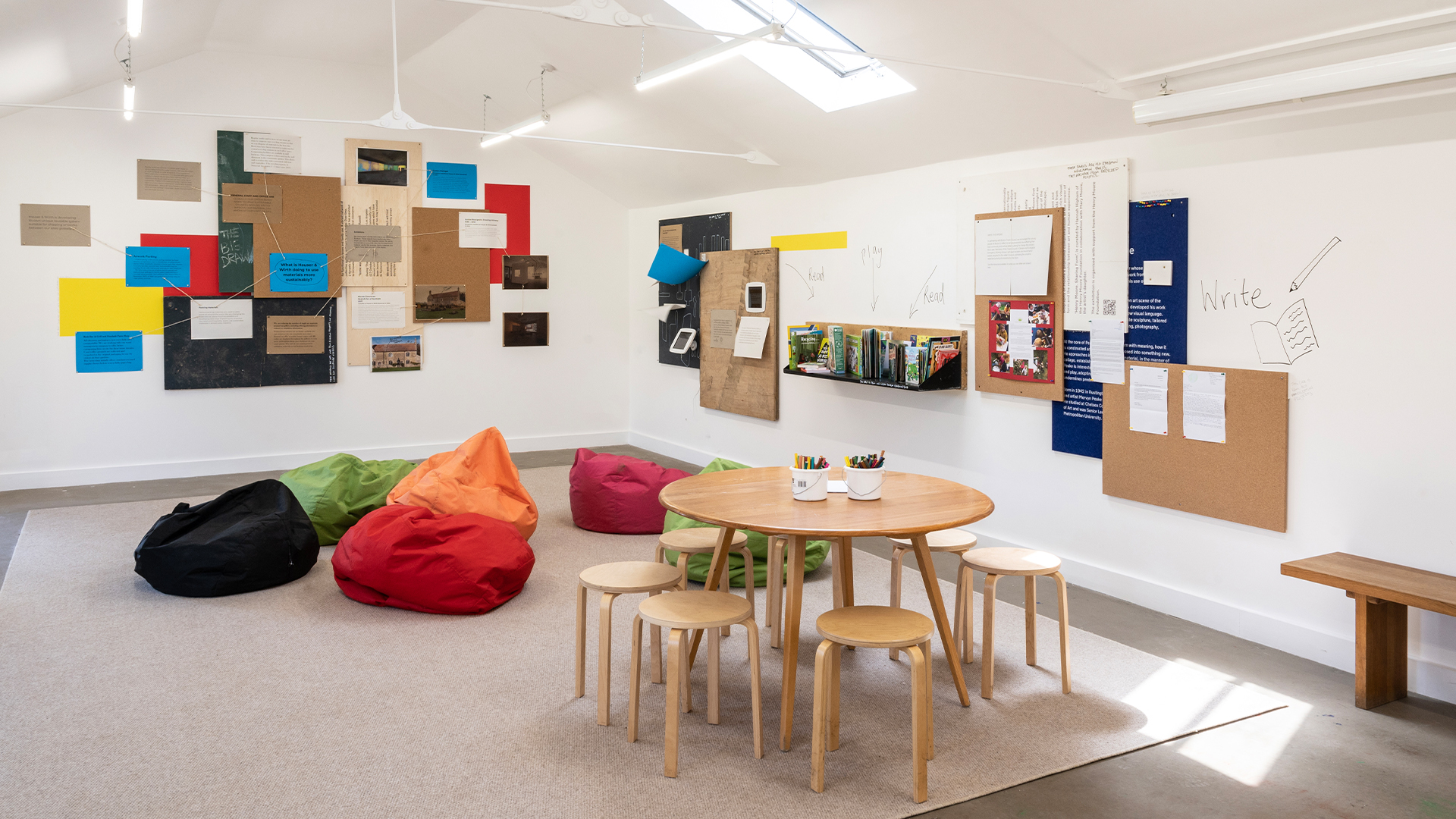
Education Lab: ‘Turning the Inside Outside: Sustainable Actions in the Art World’
Inspired by artists Mika Rottenberg and Pipilotti Rist, this interactive learning space provides a dynamic platform for collaboration across the gallery’s green teams globally. Visitors are invited to take part in the activation of the space, to engage with themes of environmental sustainability, to be inspired and to collaborate and create change in this area.
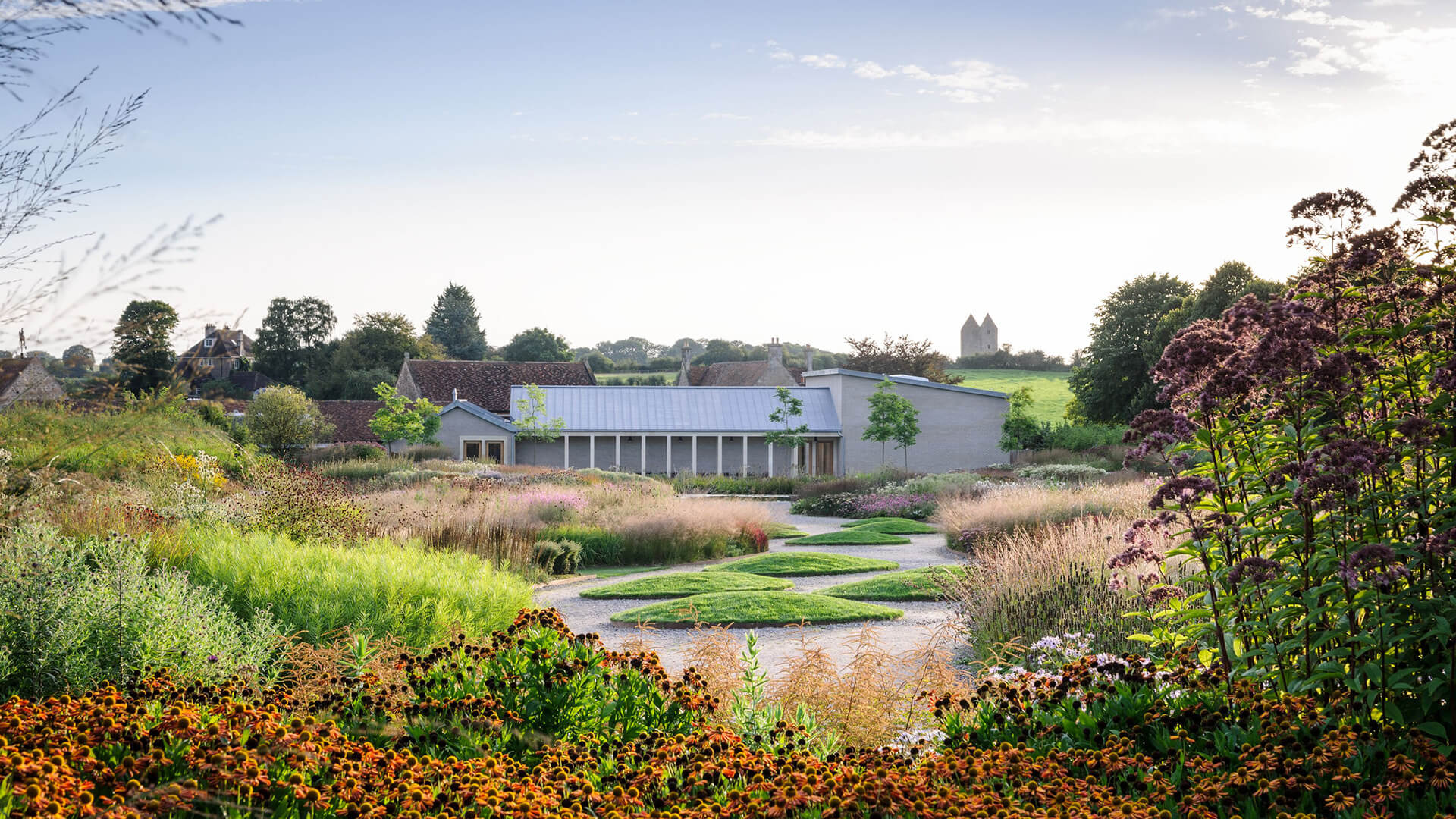
The gallery is open Tuesday – Sunday, 10 am – 5 pm.
About the Artists
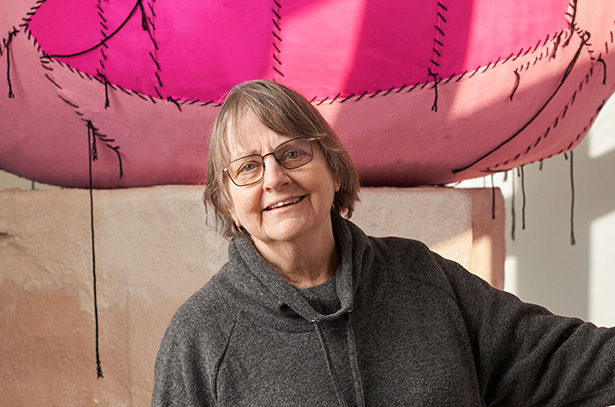
Phyllida Barlow
For almost 60 years, British artist Phyllida Barlow took inspiration from her surroundings to create imposing installations that can be at once menacing and playful. She created large-scale yet anti-monumental sculptures from inexpensive, low-grade materials such as cardboard, fabric, plywood, polystyrene, scrim, plaster and cement. These constructions were often painted in industrial or vibrant colors, the seams of their construction left at times visible, revealing the means of their making.
Barlow’s restless invented forms stretch the limits of mass, volume and height as they block, straddle and balance precariously. The audience is challenged into a new relationship with the sculptural object, the gallery environment and the world beyond.
‘There’s something about walking around sculpture that has the possibility of being reflective, like walking through a landscape,’ Barlow has said. ‘The largeness of sculpture has that infinite possibility to make one engage beyond just the object itself and into other realms of experience.’
Barlow exhibited extensively across institutions internationally and in 2017 represented Britain at the Venice Biennale.
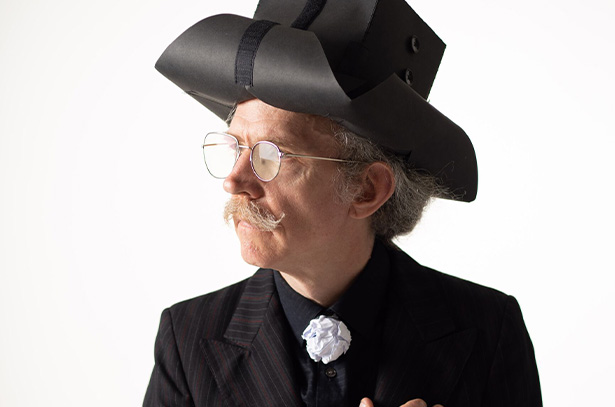
Martin Creed
‘Creed is a social artist; the true magic of his work lies in the way it interacts with people and places.’
—Jonathan Jones, ‘Martin Creed’s stairway to heaven,’ in The Guardian, London, UK, 1 August 2011, ill. (on Work No. 1059)

Nicole Eisenman
Nicole Eisenman lives and works in Brooklyn, New York. She is a MacArthur Foundation Fellow and was inducted into the American Academy of Arts and Letters in 2018. Her work was included in both the 2019 Venice Biennale and the 2019 Whitney Biennial. Solo exhibitions include 'What Happened' at the Museum Brandhorst, Munich, Germany (2023), traveling to Whitechapel Gallery, London, United Kingdom (2023) and MCA Chicago, Chicago, IL (2024); 'Heads, Kisses, Battles: Nicole Eisenman and the Moderns' at Kunsthalle Bielefeld, Bielefeld, Germany (2021), traveling to Aargauer Kunsthaus, Aarau, Switzerland (2022), Fondation Vincent Van Gogh, Arles, France (2022), and Kunstmuseum Den Haag, Netherlands (2022); 'Giant Without a Body' at the Astrup Fearnley Museet, Oslo, Norway (2021); 'Sturm und Drang' at the Contemporary Austin, Austin, TX (2020); and 'Baden Baden Baden', at the Staatliche Kunsthalle, Baden-Baden, Germany (2019). Having established herself as a painter, Nicole Eisenman has expanded her practice into the third dimension.
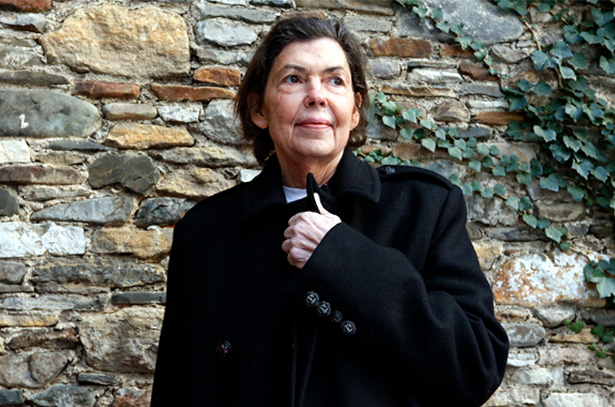
Isa Genzken
Isa Genzken has long been considered one of Germany’s most important and influential contemporary artists. Born in Bad Oldesloe, Germany, Genzken studied at the renowned Kunstakademie Düsseldorf whose faculty at the time included Joseph Beuys, Bernd and Hilla Becher, Benjamin H.D. Buchloh and Gerhard Richter. Since the 1970s, Genzken’s diverse practice has encompassed sculpture, photography, found-object installation, film, drawing and painting. Her work borrows from the aesthetics of Minimalism, punk culture and assemblage art to confront the conditions of human experience in contemporary society and the uneasy social climate of capitalism.Genzken is best known for her sculptures, gaining attention for her minimalist oriented Hyperbolos and Ellipsoids in the late 70s, and architecturally-inflected works such as her recent epoxy resin windows and skyscraper Columns from the 90s. Genzken’s practice is incredibly wide-ranging, but her work remains dedicated to challenging the viewer’s self-awareness by means of physically altering their perceptions, bringing bodies together in spaces and integrating elements of a mixed media into sculpture.
Genzken’s totemic columns, pedestal works and collages combine disparate aspects from her many sources in seemingly nonsensical, yet harmonious sculptural compilations. These sculptures take the form of precariously stacked assemblages of potted plant designer furniture, empty shipping crates and photographs, among other things, arranged with the traditions of modernist sculpture in mind. With this cacophonous array of objects, Genzken undermines the classical notions of sculpture, re-creating the architectural dimensions of her beloved skyscrapers and the riotous colors of the city streets. Devoid of the weightiness and overpowering scale seen in the sculptures of her Minimalist predecessors, her work abandons notions of order and power, allowing the viewer to relate to the works’ inherently human qualities of fragility and vulnerability.
Inspired by the stark severity of modernist architecture and the chaotic energy of the city, Genzken’s work is continuously looking around itself, translating into three-dimensional form the way that art, architecture, design and media affects the experience of urban life, and the divides between public and private. There is an intuitive and consistent manner to Genzken’s work, not only in dramatising aspects of space and scale for the audience, but in creating new dialogues and contact with surfaces of material. The socio-political content is evident and central to her oeuvre.
In 2017, Genzken was awarded the prestigious Goslarer Kaiserring (or Emperor’s Ring) by the city of Goslar, Germany.
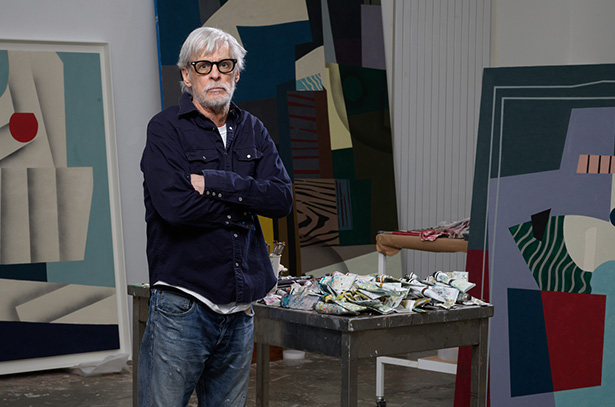
Rodney Graham
With a practice spanning five decades, Canadian artist Rodney Graham (1949 – 2022) operated through systems of quotation, reference and adaptation. From the 1980s, Graham expanded his diverse oeuvre to encompass photography, painting, sculpture, film, video and music. As actor, performer, producer, historian, writer, poet, sound engineer and musician, Graham’s art examined the complexities of Western culture through strategies of disguise, as he shifted seamlessly into different roles and characters. Casting himself as a succession of motley characters, Graham inhabited different personae, genres and art forms for the duration of his career. ‘It may be a burden to reinvent oneself every time,’ Graham said, ‘but it makes things more interesting.’
Often, Graham’s works revolve around a central absurdity, with his characters caught up in inescapable loops as if by a curse. In this sense, the central themes of Graham’s work are the relationship between civilization and nature and the transformation of traditional genres and linear narrative models into banality and irony, with displacement and duplication his favorite artistic strategies. His inspirations included such varied sources as Sigmund Freud, Mallarmé, Richard Wagner, Edgar Allan Poe, Ian Fleming and the Brothers Grimm. He emulated Donald Judd and Nirvana’s Kurt Cobain, or reconstructed Albert Hoffmann’s experiments with LSD. There is a gentle humor and a certain sense of nostalgia about the artist’s melancholy observations of modernity.
Graham’s signature photographic lightbox works are elaborate, allegorical and witty compositions focused on his use of the self-portrait to explore scenarios from our collective cultural memory. Each image is a fictional self-portrait with the artist in costume but always recognizable, portraying a vast array of characters. From the props and their placement within the frame, to the elaborate costumes and stage sets, each scene—either created in his former Vancouver studio or in public facilities around the city—is purposefully constructed and executed with an exceptional degree of technical expertise and humor.
In 1997, Graham represented Canada at the 47th Venice Biennale with his film work ‘Vexation Island’ (1997), which bought him to international recognition. He was subsequently awarded the Kurt Schwitters Prize in 2003, the Gershon Iskowitz Prize in 2004 and the DAAD Scholarship in 2001. In 2011, Graham was given The Audain Prize for Lifetime Achievement in Visual Arts, British Columbia, Canada. He was appointed as an Officer of the Order of Canada in 2016 for his contributions to Canadian contemporary art.
Graham’s work has been the subject of numerous major solo exhibitions internationally, among them a 2004 retrospective that toured the US and Canada, including, among other venues, MoCA Los Angeles, ICA Philadelphia, Vancouver Art Gallery. Other institutional exhibitions include Serlachius Museum Gösta, Mänttä, Finland (2020); Museum Frieder Burda, Baden-Baden, Germany (2017); Museum Voorlinden, Wassenaar, Netherlands (2017); BALTIC Centre for Contemporary Art, Gateshead, UK (2017); Le Constortium, Dijon, France (2016); Sammlung Goetz, Munich, Germany (2015); Charles H. Scott Gallery, Emily Carr University of Art and Design, Vancouver, Canada (2014); Vancouver Art Gallery, Canada (2012); Museum der Moderne, Salzburg, Austria (2011); Museu D’Art Contemporani de Barcelona, Spain (2010); Jeu de Paume, Paris, France (2009); Whitechapel Art Gallery, London, UK (2002); Hamburger Bahnhof, Berlin, Germany (2001); and Kunsthalle Wien, Vienna, Austria (1999).
His work is included in collections worldwide, such as Musée national d’art moderne – Centre Pompidou, Paris; Tate, London; The Museum of Modern Art, New York; Vancouver Art Gallery, Vancouver; National Gallery of Canada, Ottawa; MACBA, Barcelona; Nationalgalerie – Staatliche Museen zu Berlin, Berlin.
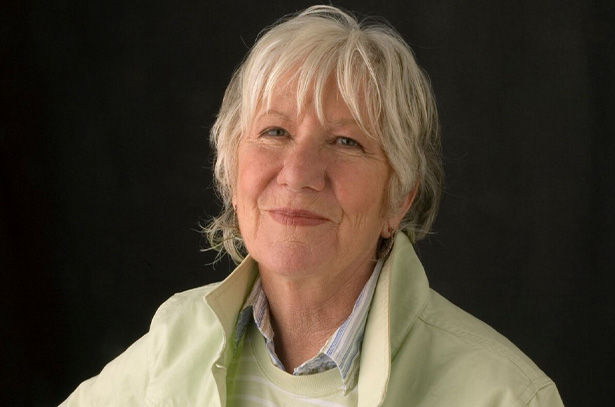
Mary Heilmann
Influenced by 1960s counterculture, the free speech movement, and the surf ethos of her native California, Mary Heilmann ranks amongst the most influential abstract painters of her generation. Considered one of the preeminent contemporary Abstract painters, Heilmann’s practice overlays the analytical geometries of Minimalism with the spontaneous ethos of the Beat Generation, and are always distinguishable by their often unorthodox—always joyful—approach to color and form.
Raised in San Francisco and Los Angeles, Heilmann completed a degree in literature, before she studied ceramics at Berkeley. Only after moving to New York in 1968 did she begin to paint. While most artists at that time were experimenting with the concept of dematerialization and demanding that painting should avoid any references to experience outside the material presence of the work itself, Heilmann opted for painting, rebelling against the accepted rules. ‘Rather than following the decrees of modern, non-representational formalism, I started to understand that the essential decisions taken during the creative process were more and more related to content. The Modern movement was over…’
Since then, Heilmann has created compositions that evoke a variety of associations. Her work may be non-representational and based on an elementary, geometrical vocabulary—circles, squares, grids and stripes—but there is always something slightly eccentric, casual about them. The simplicity of the forms is played down by a deceptive form of nonchalance: the contours are not clearly defined. In some paintings, amorphous forms appear to melt into each other like liquid wax. Splashes of color can be discerned, sharp edges bleed for no apparent reason, and the ductus of the brushstrokes is always perceptible. Heilmann’s casual painting technique conceals a frequently complex structure that only gradually reveals itself to the viewer.
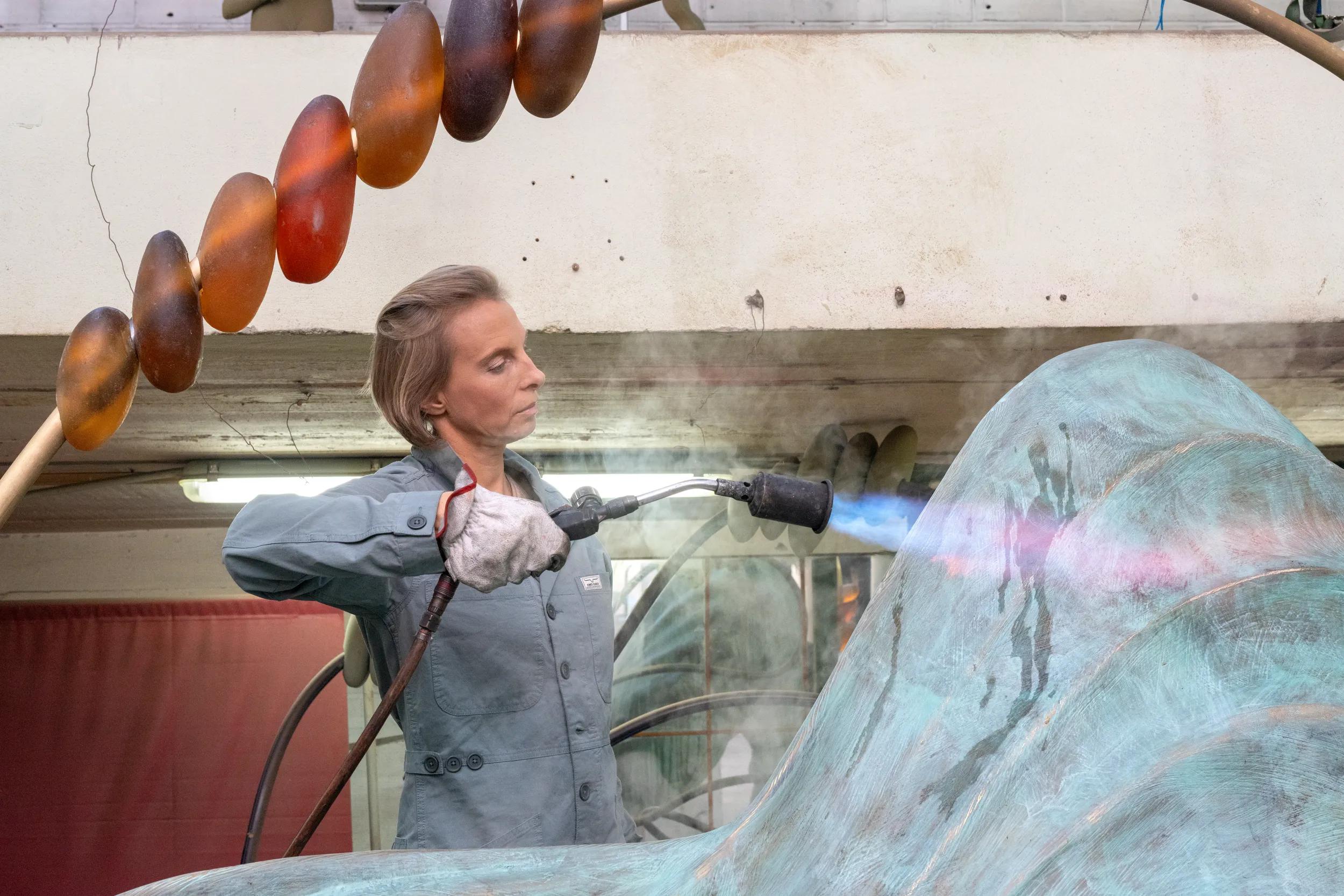
Camille Henrot
Born in 1978 in Paris, France, the artist lives and works in New York City.
The practice of French artist Camille Henrot moves seamlessly between film, painting, drawing, bronze, sculpture, and installation. Henrot draws upon references from literature, psychoanalysis, social media, cultural anthropology, self-help, and the banality of everyday life in order to question what it means to be both a private individual and a global subject.
A 2013 fellowship at the Smithsonian Institute resulted in her film ‘Grosse Fatigue,’ for which she was awarded the Silver Lion at the 55th Venice Biennale. She elaborated ideas from ‘Grosse Fatigue’ to conceive her acclaimed 2014 installation ‘The Pale Fox’ at Chisenhale Gallery in London. The exhibit, which displayed the breadth of her diverse output, went on to travel to institutions including Kunsthal Charlottenburg, Copenhagen; Bétonsalon – Centre for art and research, Paris; Westfälischer Kunstverein, Münster, Germany; and Tokyo Opera City Art Gallery, Japan. In 2017, Henrot was given carte blanche at Palais de Tokyo in Paris, where she presented the major exhibition ‘Days Are Dogs,’ She is the recipient of the 2014 Nam June Paik Award and the 2015 Edvard Munch Award, and has participated in the Lyon, Berlin, Sydney and Liverpool Biennials, among others.
Henrot has had numerous solo exhibitions worldwide, including the Middelheim Museum, Belgium; National Gallery of Victoria, Melbourne; New Museum, New York; Schinkel Pavilion, Berlin; New Orleans Museum of Art; Fondazione Memmo, Rome; Tokyo Opera City Art Gallery, Japan, among others.
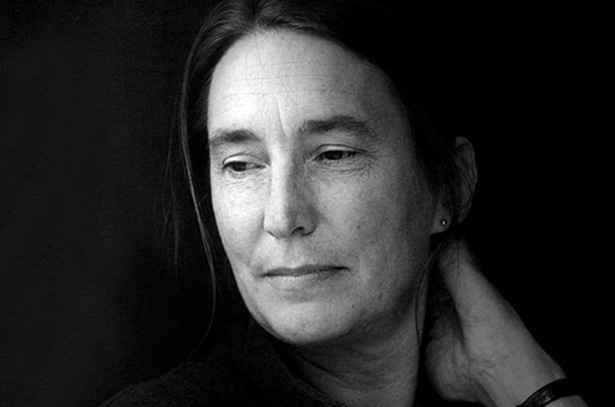
Jenny Holzer
Jenny Holzer is an American conceptual and installation artist whose work deploys text in public spaces across an array of media, including electronic signs, carved stone, paintings, billboards, and printed materials. Holzer’s oeuvre provokes public debate and illuminates social and political justice. Celebrated for her inimitable use of language and projects in the public sphere, Holzer creates a powerful tension between the realms of feeling and knowledge, with a practice that encompasses both individual and collective experiences of power and violence, vulnerability and tenderness.
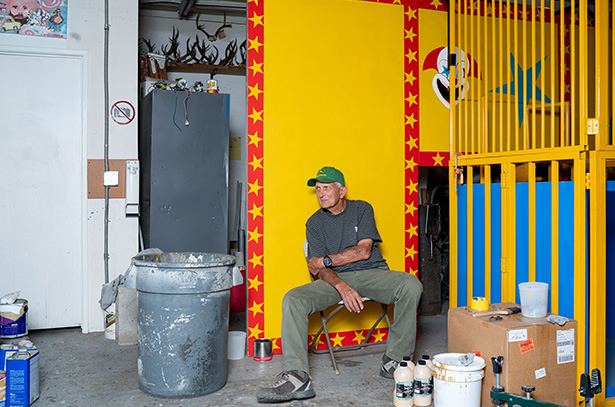
Richard Jackson
A pre-eminent figure in American contemporary art since the 1970s, Richard Jackson is influenced by both Abstract Expressionism and action painting, exploring a performative painting process which seeks to extend the potential of painting by upending its technical conventions. Born in Sacramento, California in 1939, Jackson first came to international attention with a major presentation of his installation works at the Menil Collection, Houston, in 1988, followed by the 1992 exhibition, ‘Helter Skelter,’ at the Los Angeles Museum of Contemporary Art.Jackson’s work is process-oriented, and the structural aspect of his installations involves a high level of craftsmanship and engineering. However, the final application of paint is generated through an automated process which Jackson calls ‘activation.’ He equips his ‘painting machines’ with a network of pipes and hoses which, when deployed, cause violent eruptions of paint that immerse the work and surrounding area. The finished installations remain in the aftermath of this extreme and unpredictable performative action.
Jackson responds to the high-mindedness of painterly practice by repositioning painting as an everyday experience. For Jackson, paint is not a tool used to create a representational image, but is used as a ubiquitous liquid which is spurted, splattered and sprayed over the surface of his installations.
He draws on the visual lexicon of domestic environments, universal basic human activities, and hallmarks of the quintessential American life such as hunting and sports. By harnessing this imagery and combining it with a physically laborious and conceptually rigorous artistic practice, Jackson has produced a body of work that questions and challenges the structure of the art world at large for over four decades.

Rashid Johnson
Born in Chicago in 1977, Rashid Johnson is among an influential cadre of contemporary American artists whose work employs a wide range of media to explore themes of art history, individual and shared cultural identities, personal narratives, literature, philosophy, materiality, and critical history. Johnson received a BA in Photography from Columbia College in Chicago and studied for his masters at the School of the Art Institute of Chicago. Johnson's practice quickly expanded to embrace a wide range of media—including sculpture, painting, drawing, film making, and installation—yielding a complex multidisciplinary practice that incorporates diverse materials rich with symbolism and personal history. Johnsons work is known for its narrative embedding of a pointed range of everyday materials and objects, often associated with his childhood and frequently referencing aspects of history and cultural identity. Many of Johnson’s more recent works delve into existential themes such as personal and collective anxiety, interiority, and liminal space.
Recent solo exhibitions include: ‘Rashid Johnson: A Poem for Deep Thinkers’, Guggenheim Museum, New York NY, 2025; ‘Seven Rooms and a Garden. Rashid Johnson + Moderna Museet’, Moderna Museet, Stockholm, Sweden, 2023; ‘Rashid Johnson. Nudiustertian’, Hauser & Wirth, Hong Kong, 2023; ‘The Chorus’, The Metropolitan Opera, New York NY, 2021; ‘Summer Projects. Rashid Johnson’, Creative Time, New York, NY, 2021; ‘Rashid Johnson. Capsule’, National Gallery of Canada, Ottawa, Canada, 2021; ‘The Crisis’, Storm King Art Center, New Windsor NY; ‘Rashid Johnson. Waves’, Hauser & Wirth, London, UK, 2020; the touring exhibition ‘Rashid Johnson. The Hikers’ at the Aspen Art Museum, Aspen CO, the Museo Tamayo, Mexico City, Mexico and at Hauser & Wirth, New York, 2019; ‘Provocations. Rashid Johnson’, Institute for Contemporary Art, Richmond VA, 2018; ‘Rashid Johnson. No More Water’ at Lismore Castle Arts, Lismore, Ireland, 2018 and ‘Rashid Johnson. Hail We Now Sing Joy’ at The Kemper Museum of Contemporary Art, Kansas City MO which traveled to the Milwaukee Art Museum, Milwaukee WI, 2017.
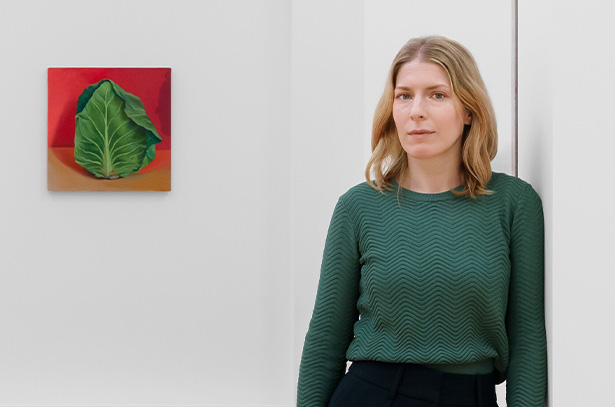
Allison Katz
For over a decade, Katz has investigated the ways in which aesthetic practices link and absorb autobiography, commodity culture, information systems and art history. Her diverse imagery, including cocks, cabbages, mouths, fairies, elevators, noses, waterways, and variations on her own name, appear as recurring symbols and icons which build an unending constellation of ideas and references. Images transmute across the media of painting, posters, ceramics and installations. It is through this act of returning to, copying, transforming and reshaping motifs that the artist creates a lineage and continuity from one work to another, informing and connecting the totality with each new appearance. ‘I paint like I write, that is, I build around quotes, which is a conversation, in effect,’ says Katz. Her subjects are united by a curiosity for how an image passes through embodied experience, while its elasticity of meaning is shaped by impersonal, cultural conditions through time. In this way her work addresses the ambiguity of subjectivity and its presentation.
Katz’s work is an examination of painting’s plane as a flat space where depth can appear, in both a literal and metaphorical way. Beyond the picture plane, her practice has a complex arrangement with the tactile world, engaging with the idea of the viewer as both subject and participant. Katz’s use of texture complicates the painting’s window-like view into another world, grounding the physicality of images in our own sense of touch by mixing sand or rice into the pigment.
Further breaking the autonomy of the illustrative tableau, her staging of exhibitions is inextricably linked to the paintings but also separate to them, and often an artwork in and of itself. The walls that she designs are built around the idea of a viewer’s encounter. This may involve the creation of contrasting perspectives, rooms within rooms or one-to-one painted copies of pre-existing architectural features, such as an elevator. Her relationship to site specificity is fluid, and motivated by constraints and a willingness to undermine the premise itself: paintings made to measure for one location find new meaning through a completely alternative set-up elsewhere. The autonomy of painting as a discrete object is both complicated and energized by the contingency of its reception and by the exhibition as form.
Katz’s interest in framing as both motif and subtext is a formal technique that investigates subjective assumptions; the frame becomes a portal for making sense of the world. The windows and mouths that frequently appear in her paintings address a duality between the sensual and intellectual consumption of information, and synthesize different kinds of sensory experience, such as taste and sight. Exhibition posters frame the event with actual dates and times, but also skew and extend it, by existing as independent artworks that are displayed after the fact.
Katz’s use of wordplay, double entendre or riddle, in both her choice of titles and the generation of the image itself, extends to the use of her signature as a visual element, and speaks to a self-referential thread running throughout her work. The AKgraph paintings—whose titles play on the origins of the words autos ‘self’ + graphos ‘written’—mine the territory between everyday signatures and formal drawing, inscribing identity to leave a trace. Creating a likeness of her own face through the elements that make up her name, Katz pits cartoonish forms against ideas assumed to be stable and hierarchical. This playful and inquiring touch refuses the conventional notion of an artist’s ‘signature style’ in favor of a broader engagement with how a painting can be made today.
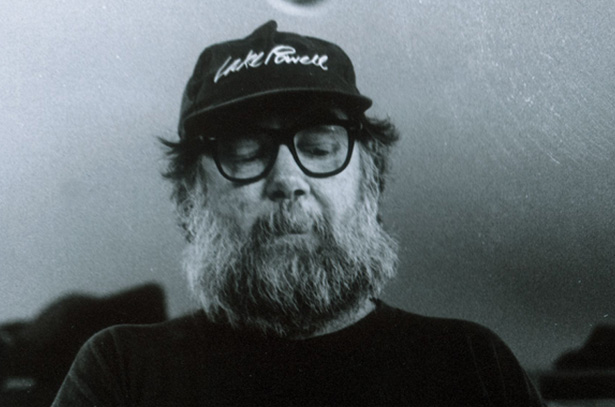
PAUL McCARTHY
Paul McCarthy is widely considered to be one of the most influential and groundbreaking contemporary American artists. Born in 1945, and raised in Salt Lake City, Utah, he first established a multi-faceted artistic practice, which sought to break the limitations of painting by using unorthodox materials such as bodily fluids and food. He has since become known for visceral, often hauntingly humorous work in a variety of mediums—from performance, photography, film and video, to sculpture, drawing and painting.
During the 1990s, he extended his practice into installations and stand-alone sculptural figures, utilizing a range of materials such as fiberglass, silicone, animatronics and inflatable vinyl. Playing on popular illusions and cultural myths, fantasy and reality collide in a delirious yet poignant exploration of the subconscious, in works that simultaneously challenge the viewer’s phenomenological expectations.
Whether absent or present, the human figure has been a constant in his work, either through the artist‘s own performances or the array of characters he creates to mix high and low culture, and provoke an analysis of our fundamental beliefs. These playfully oversized characters and objects critique the worlds from which they are drawn: Hollywood, politics, philosophy, science, art, literature, and television. McCarthy’s work, thus, locates the traumas lurking behind the stage set of the American Dream and identifies their counterparts in the art historical canon.
McCarthy earned a BFA in painting from the San Francisco Art Institute in 1969, and an MFA in multimedia, film and art from USC in 1973. For 18 years, he taught performance, video, installation, and art history in the New Genres Department at UCLA, where he influenced future generations of west coast artists and he has exhibited extensively worldwide. McCarthy’s work comprises collaborations with artist-friends such as Mike Kelley and Jason Rhoades, as well as his son Damon McCarthy.
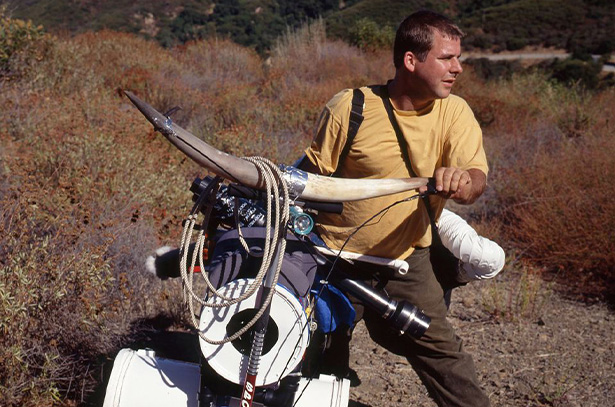
Jason Rhoades
Jason Rhoades (1965 – 2006) was a visionary artist and world builder for whom sculpture and myth were intertwined forms of construction. His epic assemblage installations established him as a force of the international art world in the 1990s, while based in Los Angeles. America was his art’s imaginative subject, which he represented with a provocative sense of irony and materialism, along with disarming humor and authentic identification.
Working on an architectural scale, Rhoades created immersive environmental sculptures that deployed copious quantities of consumer goods (Q-tips, computers, knickknacks), building supplies (plastic buckets, Sheetrock, extension cords), media (video games, hip-hop music, porn) and neon light. Imbued with a barely contained sense of chaos, these works are also highly crafted and surprisingly formal in their composition. Pattern, order, information networks, narrative threads, color and line give shape to Rhoades’ installations as diagrammatic depictions and systems of meaning. He considered art a tool for pursuing life’s big questions and dedicated major works to exploring the act of creation as signified by a garage, the brain, Brancusi’s studio and a penis, among other metaphorical sites. The car was also instrumental to Rhoades’ project as a readymade sculpture, as a conceptual space akin to the studio and as a vehicle for the driving ambition he held for his art. 'If you know my work', he said, 'you know that it is never finished'.
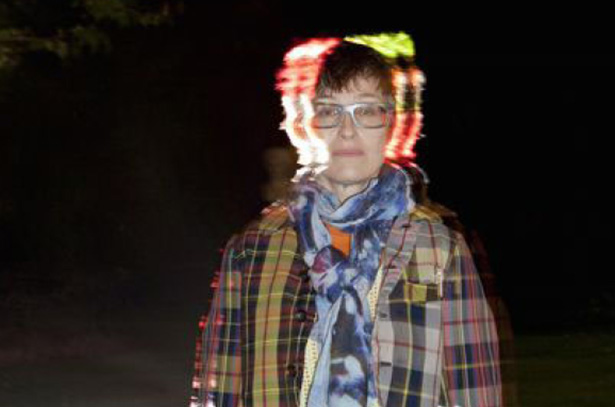
Pipilotti Rist
Pipilotti Rist, a pioneer of spatial video art, was born 1962 in Grabs in the Swiss Rhine Valley on the Austrian Border and has been a central figure within the international art scene since the mid-1980s.
Astounding the art world with the energetic exorcistic statement of her now famous single channel videos, such as ‘I’m Not The Girl Who Misses Much,’ 1986 and ‘Pickelporno,’ 1992, her artistic work has co-developed with technical advancements and in playful exploration of its new possibilities to propose footage resembling a collective brain. Through large video projections and digital manipulation, she has developed immersive installations that draw life from slow caressing showers of vivid color tones, like her works ‘Sip My Ocean,’ 1996 or ‘Worry Will Vanish,’ 2014.
For Rist, showing vulnerability is a sign of strength on which she draws for inspiration. With her curious and lavish recordings of nature (to which humans belong as an animal), and her investigative editing, Rist seeks to justify the privileged position we are born with, simply by being human. Her installations and exhibition concepts are expansive, finding within the mind, senses and body the possibility for endless discovery and poetical invention. ‘Pixel Forest,’ 2016, made from 3,000 thousand LEDs hung on strings, resembles a movie screen that has exploded into the room, allowing viewers an immersive walk through 3-dimensional video. As she herself puts it, ‘beside the energy-intensive exploration of the geographical world, pictures, films and sounds have been and are the spaces into which we can escape... The projector is the flamethrower, the space is the vortex and you are the pearl within.’
Since 1984, Rist has had countless solo and group exhibitions, and video screenings worldwide. Her recent solo exhibitions are 'Electric Idyll' at the Fire Station Doha (2024), 'Prickling Goosebumps & A Humming Horizon' at Hauser & Wirth New York and Luhring Augustine Chelsea (2023-24), 'Behind Your Eyelid' at Tai Kwun Hong Kong (2022), ‘Big Heartedness, Be My Neighbor’ at The Geffen Contemporary, MOCA, Museum of Contemporary Art Los Angeles (2021 – 2022), ‘Your Eye Is My Island’ at MoMAK, The National Museum of Modern Art Kyoto and ART TOWER MITO (2021). ‘Åbn min Lysning. Open my Glade’ at Louisiana Museum of Modern Art Humlebæk Denmark (2019), ‘Sip My Ocean’ at the Museum of Contemporary Art Sydney (2017 – 2018), ‘Pixel Forest’ at New Museum New York (2016 – 2017) and ‘Your Saliva is My Diving Suit of the Ocean of Pain’ at Kunsthaus Zürich (2016), all resulted in record-breaking attendance numbers for each institution. A major exhibition is planned for summer 2025 at UCCA Beijing.
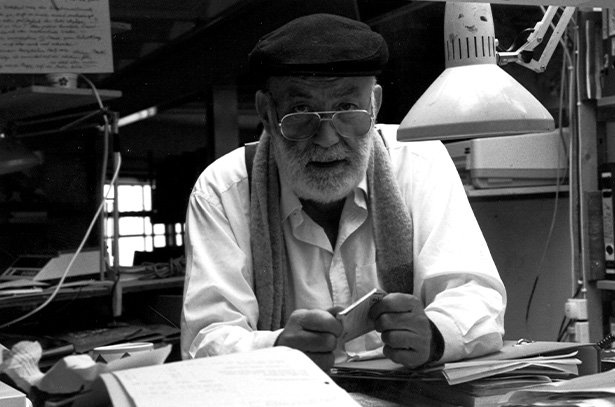
Dieter Roth
One of the most influential artists of the post-World War II period, Dieter Roth was born in Hanover, Germany, in 1930, to a German mother and a Swiss father, and died in Basel, Switzerland in 1998. Dieter Roth was an artist of an immense diversity and breadth, producing books, graphics, drawings, paintings, sculptures, assemblages, installations, audio and media works involving slides, sound recordings, film and video. He also worked as a composer, poet, writer and musician. He often collaborated with other artists, subverting the principle of authorship. Those partners included such significant figures as Richard Hamilton, Emmett Williams, Arnulf Rainer, and Hermann Nitsch. But it was Roth's long and symbiotic collaboration with his son, artist Björn Roth, that stands as testament to the enormous and enduring potency of his restless, relentless process.
Through much of his life, Roth was restlessly peripatetic, moving between studios in many cities. His two primary bases of activity—Iceland and Basel—were decidedly outside the mainstream. Throughout his career, the artist continually circled back to earlier ideas and processes, reinterpreting and transforming works so that linearity and closure are consistently defied. Transience and order, destruction and creativity, playful humor and critical inquiry, the abject and the beautiful, all maintain a consistent balance throughout his work.
Roth represented Switzerland at the 1982 Venice Biennale, and received a number of awards and prizes, including the 1991 Genevan Prix Caran d'Ache Beaux Arts, a prestigious Swiss prize. In 2004, The Museum of Modern Art and P.S.1 Contemporary Art Center in New York City jointly presented the major historical exhibition ‘Roth Time: A Dieter Roth Retrospective,’ a project co-organized with Schaulager Basel, Switzerland, and the Museum Ludwig of Cologne, Germany.
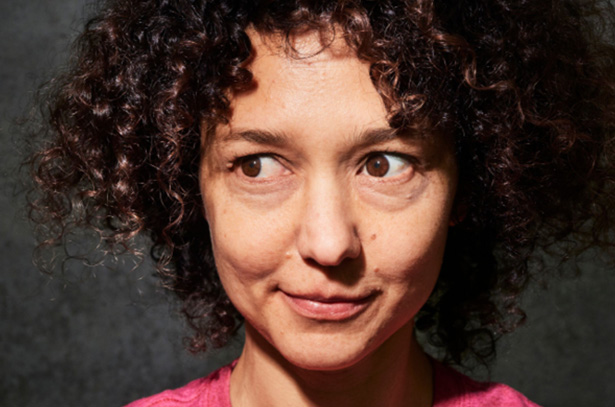
Mika Rottenberg
Argentina-born, New York-based artist Mika Rottenberg is devoted to a rigorous practice that combines film, architectural installation, and sculpture to explore ideas of labor and the production of value in our contemporary hyper-capitalist world.
Using traditions of both cinema and sculpture, she seeks out locations around the world where specific systems of production and commerce are in place, such as a pearl factory in China, and a Calexico border town. Through the editing process, and with footage from sets built in her studio, Rottenberg connects seemingly disparate places and things to create elaborate and subversive visual narratives. By weaving fact and fiction together, she highlights the inherent beauty and absurdity of our contemporary existence.
Each of Rottenberg’s video works is situated within a theatrical installation, made up of objects from the parallel worlds in her videos. Sacks of pearls, deflated pool toys, plastic flowers and sizzling frying pans seem to open a portal into the realm of the work. Her multidimensional film projects are often accompanied by standalone sculptural works, connected by allegory.
Rottenberg’s most recent body of work, “Lampshares” (2023–present), is a ‘mini circular economy’ that produces functional sculptures made from invasive vines and reclaimed plastic. The artist and her team collect, mold, extrude and press NYC street waste plastic and bittersweet vines from NY forests into sculptural and functional form—suggesting the artist’s studio can be an incubator for a restorative circle of creation and consumption.
Rottenberg’s latest feature length film, ‘REMOTE’ (2022), co-created with Mahyad Tousi, was commissioned by Artangel, United Kingdom; the Louisiana Museum, Humlebaek; and Moderna Museet, Stockholm; and premiered at Tate Modern and the New York Film Festival in 2022.
Rottenberg earned her BA from the School of Visual Arts in New York and followed this with an MFA at Columbia University in 2004. Rottenberg was the recipient of the 2019 Kurt Schwitters Prize, which recognizes artists who have made a significant contribution to the field of contemporary art. In 2018, she was the winner of the Smithsonian American Art Museum’s James Dicke Contemporary Artist Prize, which recognizes an artist younger than 50 who has produced a significant body of work and consistently demonstrates exceptional creativity.
Rottenberg’s work is held in numerous major museum and public collections including the Brooklyn Museum, Brooklyn NY; Institute of Contemporary Art, Boston MA; Hirshhorn Museum and Sculpture Garden, Washington DC; Louisiana Museum of Modern Art, Humlebæk, Denmark; The Metropolitan Museum of Art, New York NY; The Museum of Modern Art, New York NY; San Francisco Museum of Modern Art, San Francisco CA; Solomon R. Guggenheim Museum, New York NY; Moderna Museet, Stockholm, Sweden; Tate, London, United Kingdom; and the Whitney Museum of American Art, New York NY. Her work has been exhibited at major institutions including the Museum of Modern Art, New York NY; Venice Biennale (2015); and National Museum of Modern and Contemporary Art, Seoul, Korea. She has had solo exhibitions at the Louisiana Museum of Modern Art, Humlebæk, Denmark; New Museum, New York NY; Palais de Tokyo, Paris, France; Goldsmiths Centre for Contemporary Art, London, United Kingdom; and Museum of Contemporary Art Chicago, Chicago IL among others.
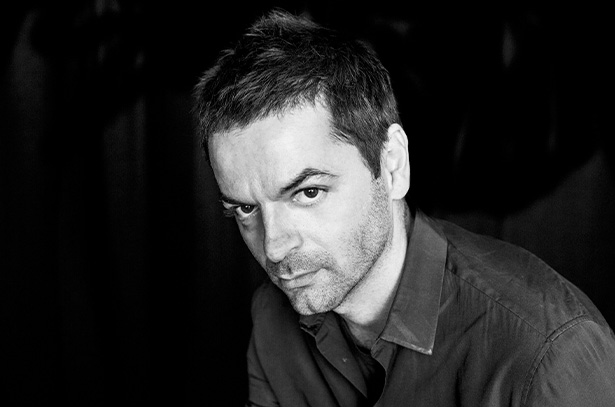
Anri Sala
Anri Sala represents a truly contemporary international vision: working in a range of media including video, photography and installation, Sala was educated in Albania and France, but now lives and works in Berlin. In his films and installations, Sala invites viewers to participate in his world of cultural observation, for which he often uses socio-political settings and personal experiences as backdrops.
By juxtaposing elements of past and present, discordance and harmony, and by overlapping narrative, sound and movement, Sala creates a unique sensibility. With his first critically acclaimed experimental documentary ‘Intervista (Finding the words)’ from 1998, the artist formulates his interest in perception of reality, truth and historical transformation. Since then, his practice emerged into a study of sound—soundtracks of images, the absence of sound, or the failure of verbal communication, all form distinct kinds of narratives.
In 2001, Sala was the recipient of the Young Artist Prize at the Venice Biennale and in 2013, he exhibited his acclaimed video works ‘Ravel Ravel’ and ‘Unravel’(both 2013) for the French Pavilion. Both works analyze the perception of space through music—two versions of Ravel’s ‘Piano Concerto for the Left hand in D-major’ can be seen performed alongside each other. ‘Unravel’ sets out to sync what deliberately was paced out of sync; Chloé, a DJ and music producer, can be observed standing in the middle of the German pavilion trying to untangle what has been entangled in ‘Ravel Ravel.'
The undercurrent of Sala’s projects, such as ‘Intervista (Finding Words)’ or ‘Ravel Ravel Unravel,’ is a fundamentally personal exploration of intimate, interwoven stories, resonating themes of a changing society and the individual. The artist’s interest in transition and rupture is demonstrated by the way in which he relates language, sound, music. The impact of his work featured at the world's top venues and exhibitions endorses Sala’s conviction that art can transcend cultural references without losing any of its specificity, nor indeed, its power.
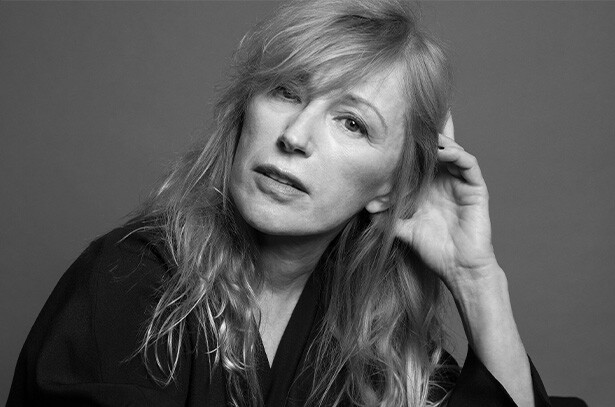
Cindy Sherman
Cindy Sherman was born in 1954 in Glen Ridge, New Jersey; she lives and works in New York. Her ground-breaking photographs have interrogated themes around representation and identity in contemporary media for over four decades. Sherman first turned her attention to photography at Buffalo State College, where she studied art in the early 1970s, and came to prominence in the late 1970s with the Pictures Generation group.
Utilising prosthetics, theatrical effects, photographic techniques and digital technologies, she has channeled and reconstructed familiar personas known to the collective psyche, often in unsettling ways, and has explored the more grotesque aspects of humanity through the lens of horror and the abject. Her later series have also touched on issues from class to aging.
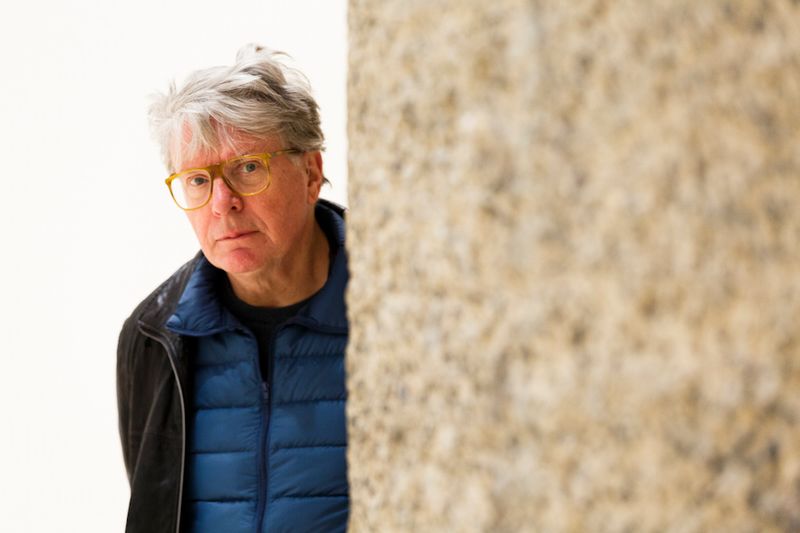
Roman Signer
Swiss artist Roman Signer has been redefining sculpture for more than 40 years and is now regarded as one of the finest representatives of Process and Conceptual art. He produces elementary dynamic sculptures and installations, also known as time sculptures for their preoccupation with the transformation of materials and objects through time. In his actions, acceleration and change are part of the creative process and he uses photography and moving image to document his work.Characterized by processes and potentialities, his work takes into account the concepts of Minimalism and Conceptualism, and with this Signer occupies a unique position in the recent history of sculpture. Signer exploits the possible uses and limitations of everyday objects, such as umbrellas, bottles, tables, chairs and candles, through a process guided by both curiosity and discipline. Like the director of a thriller, he makes use of tension and surprise—with the distinction that in his case everything takes place in the here and now. The works are the direct result of processes initiated by the artist.
Signer’s work explores the relationships between sudden energy releases and calm, between order and chaos, and the existence of form in the apparently formless. Physical forces like gravitation and motor energies are both a challenge to the artist and the instruments he relies on to realize his sculptural ideas. In his work, classical sculptural materials have been usurped by sand, water and ordinary objects. Meticulous planning and incalculable chance interact, generating ‘poetic’ visual installations with their own highly developed individual aesthetic. Signer’s artistic explorations of the world around us and its phenomena changes our perceptions and even seems to alter reality. Often the mere indication of a sudden or possible release of energy is enough to transmogrify a simple configuration of objects—a movable wooden arm and a rocket—into a wittily succinct visual commentary on the relationship between cause and effect.
His work has been presented in numerous museums and galleries worldwide and has been selected for prestigious international exhibitions such as the Venice Biennale, where he represented Switzerland in 1999, Skulptur Projekte Münster (1997) as well as Documenta 8 in Kassel where during ‘Action in front of the Orangerie’ he catapulted 350.000 sheets of paper into the air simultaneously with an explosive charge.

Lorna Simpson
Born in Brooklyn, Lorna Simpson came to prominence in the 1990s with her pioneering approach to conceptual photography. Simpson’s early work—particularly her striking juxtapositions of text and staged images—raised questions about the nature of representation, identity, gender, race and history that continue to drive the artist’s expanding and multi-disciplinary practice today. She deftly explores the medium’s umbilical relation to memory and history, both central themes within her work.
Studying on the West Coast in the mid-1980s, Simpson was part of a generation of artists who utilized conceptual approaches to undermine the credibility and apparent neutrality of language and images. Her most iconic works from this period depict African-American figures as seen only from behind or in fragments. Photographed in a neutral studio space, the figures are tied neither to a specific place nor time. Drawing upon a long-standing interest in poetry and literature, the artist accompanies these images with her own fragmented text, which is at times infused with the suggestion of violence or trauma. The incredibly powerful works entangle viewers into an equivocal web of meaning, with what is unseen and left unsaid as important as that which the artist does disclose. Seemingly straightforward, these works are in fact near-enigmas, as complex as the subject matter they take on.
Over the past 30 years, Simpson has continued to probe these questions while expanding her practice to encompass various media including film and video, painting, drawing and sculpture. Her recent works incorporate appropriated imagery from vintage Jet and Ebony magazines, found photo booth images, and discarded Associated Press photos of natural elements—particularly ice, a motif that appears in her sculptural work in the form of glistening ‘ice’ blocks made of glass. The new work continues to immerse viewers in layers of bewitching paradoxes, threading dichotomies of figuration and abstraction, past and present, destruction and creation, and male and female. Layered and multivalent, Simpson’s practice deploys metaphor, metonymy, and formal prowess to offer a potent response to American life today.

Alina Szapocznikow
Born in Poland to a Jewish family in 1926, Alina Szapocznikow survived internment in concentration camps during the Holocaust as a teenager. Immediately after the war, she moved first to Prague and then to Paris, studying sculpture at the École des Beaux Arts. In 1951, suffering from tuberculosis, she was forced to return to Poland, where she expanded her practice. When the Polish government loosened controls over creative freedom following Stalin’s death in 1952, Szapocznikow moved into figurative abstraction and then a pioneering form of representation. By the 1960s, she was radically re-conceptualizing sculpture as an intimate record not only of her memory, but also of her own body.
In 1962, Szapocznikow experienced a breakthrough when she began to cast her own body in plaster. Her first work with this approach, ‘Noga (Leg)’, 1962 depicts the artist’s right leg—a very public statement on the human corpus as vehicle of pleasure, liberation, illness, death, and decomposition. She spoke of this turn in her development: ‘Haunted by the increasingly academic nature of abstract art, and at the same time, partly out of my spirit of contradiction and partly perhaps out of some artistic exhibitionism, I made a cast of my own leg and an assemblage of casts of my face… Fortunately we believe that in art everything has been already, so nothing has been yet.’
Szapocznikow was diagnosed with breast cancer in 1969, a turn of events that shaped her later sculptural and photographic efforts. In a series of sculptures titled ‘Tumors,’ made of resin, gauze, crumpled newspapers, and photographs, the artist gave form to the anxiety and existential challenges of illness. Szapocznikow’s final works express her pointed desire to engage with something deeper and ineffable, physical and psychological, the symptoms of bodily experiences and the traces of what we leave behind. She wrote, ‘Despite everything, I persist in trying to fix in resin the traces of our body: I am convinced that of all the manifestations of the ephemeral, the human body is the most vulnerable, the only source of all joy, all suffering, and all truth.’
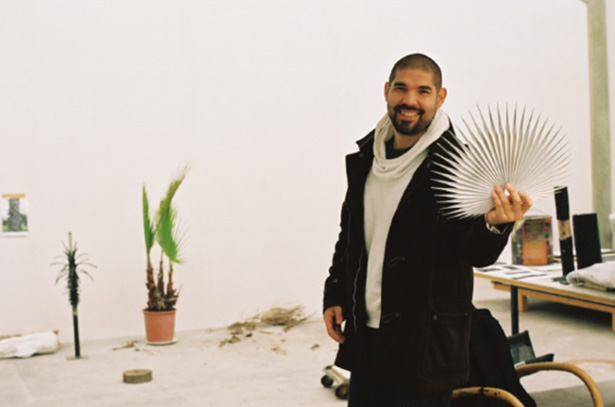
David Zink Yi
The oeuvre of the Berlin-based artist David Zink Yi revolves around themes of creation, manifestation, and the construction of identity. Born in Lima in 1973, Zink Yi left Peru for Germany at the age of 16. Drawing inspiration from his own experiences, he interrogates the complex aspects of identity construction through his multi-disciplinary practice; encompassing film, photography, sculpture, performance, ceramics and multi-channel video installations, which all emphasize the social interrelation of the protagonists, as well as physiological aspects of musical perception.
Zink Yi’s art has gained attention for its critical engagement with culturally and emotionally determined actions and experiences. These actions, such as cooking, speaking, dancing, singing, writing and narrating, sketch the complexity of identity, identity-formation and their forms of expression and are most often the performative stimulus for making the works. Over the past decades, the artist has been using natural forms, ritual, music and dance to explore the complex motifs as constructed within cultural traditions. As a medium of expression, the body is often present in the works. It is the place at which the limits between outward and inward experience, between factual history and personal feeling, are drawn.
Over the past few years, Zink Yi has worked within the ceramic tradition to create sculptural works inspired by different molluscs and cephalopods such as octopus fragments, squids and architeuthidae. These elusive animals, with a rich history in myth and fine art, are understood as a complex living species opposite to the human one.
Inquire about available works in ‘GRUPPENAUSSTELLUNG’
‘GRUPPENAUSSTELLUNG’ is on view through 1 January 2024 at Hauser & Wirth Somerset.
Related Content
Current Exhibitions
1 / 12
